Home Blog PowerPoint Tutorials How To Prepare and Deliver a Business Case Presentation

How To Prepare and Deliver a Business Case Presentation
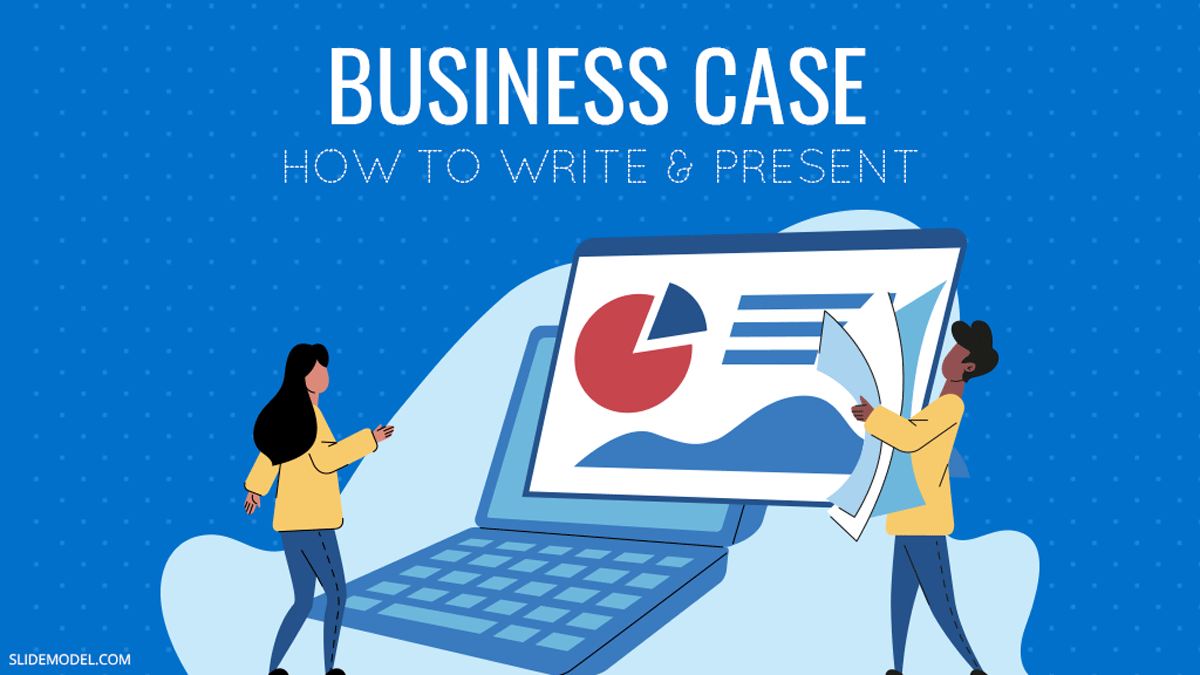
No matter how junior or senior an individual is in an organization, there will always be times when they need to convince others why they should fund them, choose them, or do anything else they want them to do. Sometimes an informal, but convincing, argument is enough. Often, it isn’t. Those are the times you’ll need to prepare a business case in order to change their mind.
What is a Business Case?
A business case is a document that presents the costs, risks, and benefits of a particular initiative, justifies the investment , and pitches why decision-makers should approve of the recommendation. Students pursuing an MBA with a specialization in marketing are often asked to prepare different business case studies to improve their business forecasting and analytics skills.
Depending on your organization and endeavor, this will be anything from an informal document to a formal presentation before stakeholders. Regardless of the format, a business case aims to convince people if a project or initiative is worth investing in and why one particular approach is better than others.
A Business Case Is Not a Project Proposal or a Project Plan
Don’t get a business case mixed up with a project proposal . While they have similar goals and will cover some of the same topics, they’re not quite the same thing. A project proposal focuses on what a project is, delving into many of the details like deliverables and timelines. They are also different from project plans , which explain how a project will be executed and have much more detail. A business case, on the other hand, is about why people should invest in your initiative.
When You Should Create a Business Case Presentation?
You should create a business case presentation any time you need to convince a manager or stakeholder to make a decision, where an informal conversation is not appropriate or enough.
Common reasons to create a business case presentation:
- Asking for new funding, more funding, or a continuation of funding
- Changing the scope of a project
- Starting a new project
- Requesting a policy change
- Asking for an exception to a rule
- Adding resources to a project or team
How to Create a Business Case Presentation?
While you might be eager to jump in and share the initiative you believe in, it’s a good idea to step back and make sure you prepare a solid case. The more concrete details, facts, and figures you have, the stronger your business case will be. The main sections of a business case will be the context of the situation, problem statement, opportunities, financial analysis, and solution description.
If you’ve never made a business case presentation before, consider using a business case template or try our AI presentation maker to help guide you through each step. Here’s a short summary of each of the parts of a convincing business case presentation.
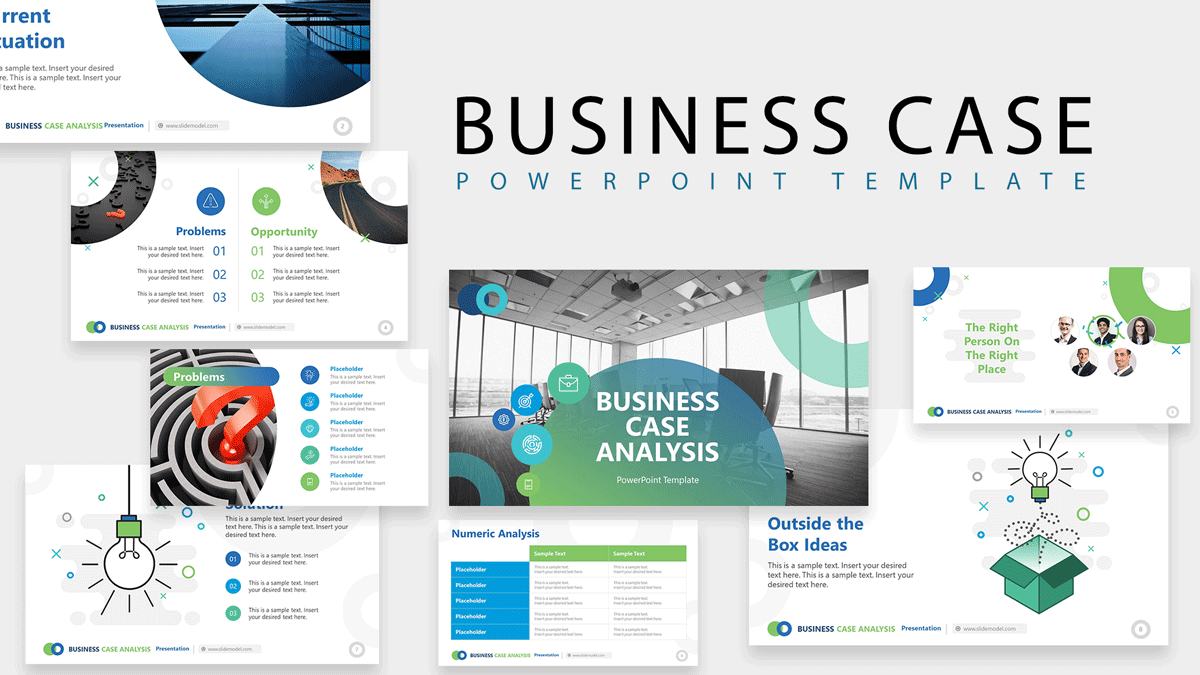
Step 1. Establish Context about the Current Situation
Not all audience members will immediately know what the current situation is leading up to your initiative. Briefly lay out the background of the idea. Note that this isn’t the problem statement, which will follow.
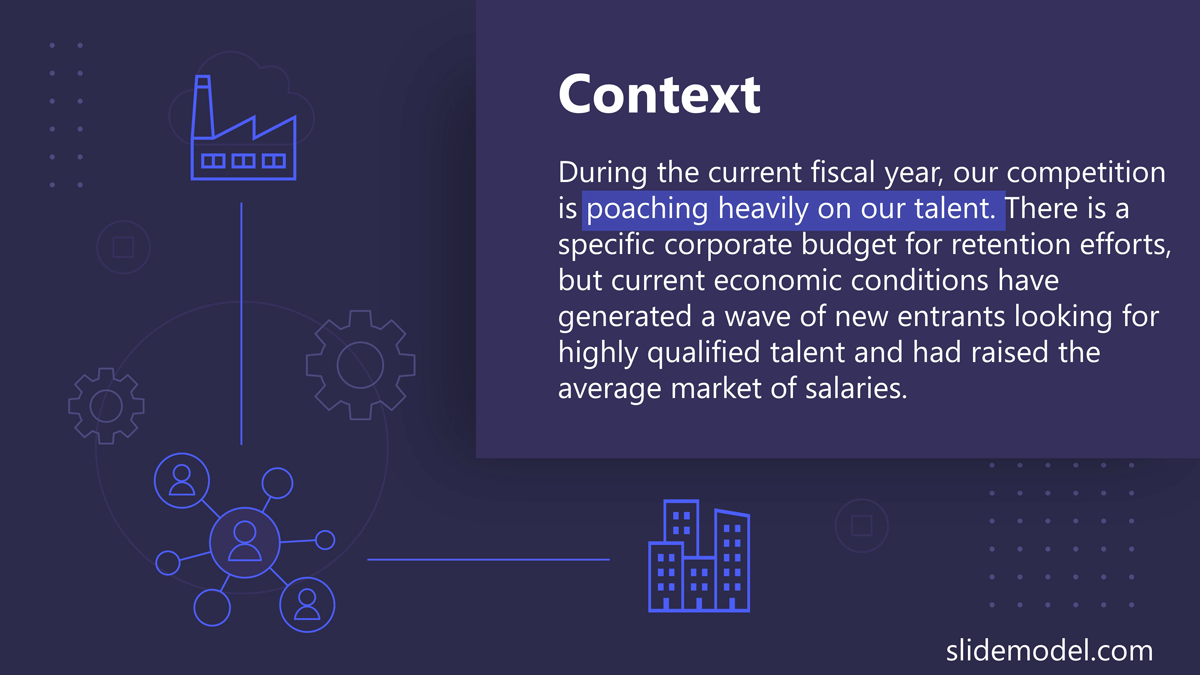
Step 2. State the Problems
This slide is where you can impress upon your audience the importance of the problem, and therefore, why the solution you’ll soon present is necessary.
When describing the problems, think about the direct and indirect effects of the situation, as well as the internal and external implications. Include statistical analysis if you’re already seeing negative effects because of the situation.
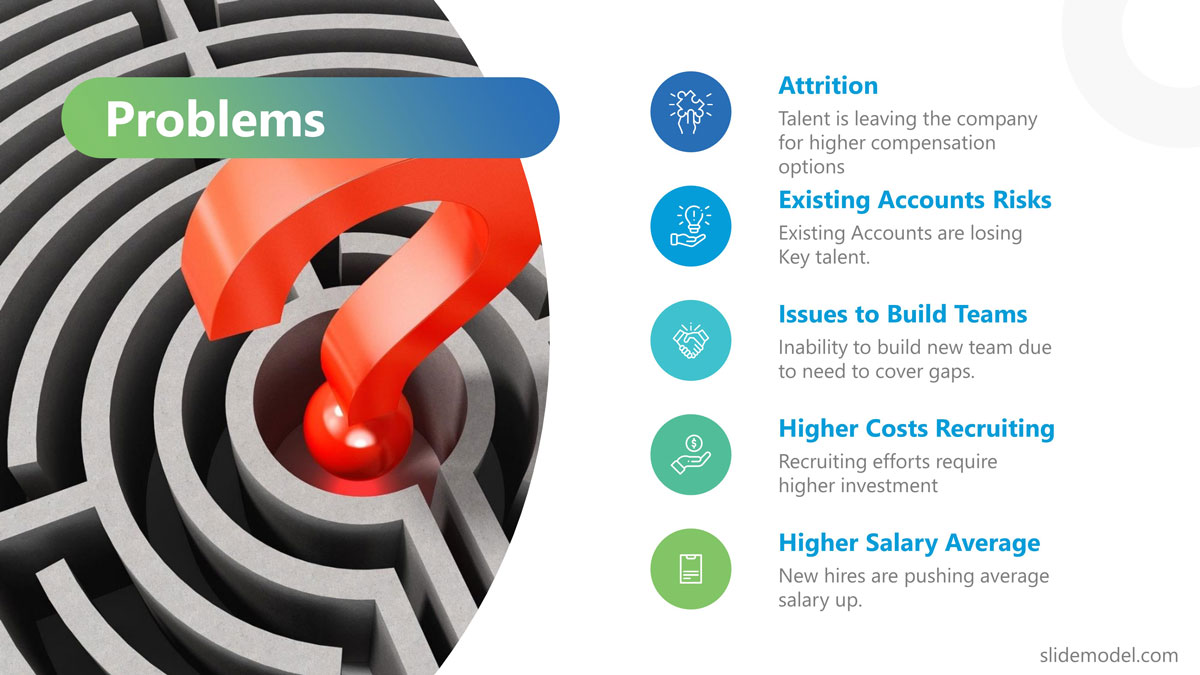
Step 3. Evaluate Opportunities
Your solution needs to be directly related to the stated problem. Here you can list, side-by-side, the opportunities you foresee to address problems. This section is a segway from your problem to your solution.
Another way to present this section is to analyze potential causes of the previously stated problem. This would then be the step to introduce the possible approaches, before settling on the one you’ve chosen to pitch.
Step 4. Analyze Finances
The numbers are probably the most important thing on stakeholder’s minds. They can make or break your business case. Present the current financial situation and compare it to the numbers you could be achieving if they choose to fund your initiative. Additionally, emphasize the potential for increased revenue through the implementation of a recurring payment system , which can provide a steady stream of income for your business.
Step 5. Describe Solution
Now that you’ve impressed the need for a change on your audience, it’s time to propose your solution. The format of your solution description will depend on what kind of decision you’re promoting. Generally speaking, you’ll want to briefly outline what needs to be done, how it will be done, who will do it, and when it will be done. Let’s look at sample solution formats for each of the examples from the introduction:
- Convincing the project manager to add you to a team: List the skills you have, how they relate to the needs of the project, and what you’ll be able to achieve once part of that team.
- Convincing your boss to commit time to fixing a product issue: List how you can fix the issue, how much time it will take, how many resources it will take, and how much it will cost, especially when compared to the alternative.
- Convincing HR to give an employee a raise: List how much of a raise your employee will need, any other non-monetary benefits that could work, and the advantages of retaining that talent.
- Convincing the board to open a new office: This initiative is clearly much more complex than the previous examples, which means it will require a much more in-depth business case document. However, in the business case presentation, you can list the costs, forecasted ROI, resources needed, and potential benefits of opening up the satellite office.
10 Tips for Presenting Effective Business Cases
- Use unique and attention-grabbing visuals. Chances are a board of directors or management team has seen a lot of business cases. Make sure yours doesn’t look just like everyone else’s.
- Clearly state your recommendation and required investment.
- Don’t shy away from costs and risks.
- Evaluate various scenarios when presenting your solution.
- Don’t forget to practice presenting your business case when preparing the documentation.
- Use an appropriate story alongside facts and figures to hook your audience, as recommended by the Harvard Business Review .
- Don’t add too much data to your PPT slides. Remember that the rest of your details will be in the business case document.
- Involve your audience by making eye contact, mentioning specific examples they may have heard about or been involved in, and even making appropriate jokes.
- Brainstorm potential questions your audience may ask and incorporate them into your presentation.
- Prepare both a long version and a short version of your business case presentation. You might be expecting an hour to pitch your idea to stakeholders, but you might just get a few minutes while walking down the hall to an emergency meeting.
Conclusion: Do Your Initiative Justice
You have a good idea. Maybe it’s a project you really believe in, a decision that just has to be made, or a strategy that will change the game for your organization. Whatever the case, your initiative won’t get approval if you communicate it ineffectively. Create a convincing business case and present it effectively and you’ll see decisions going your way in no time.

Like this article? Please share
Business Analysis Tools, Business Presentations, Presentation, Presentation Approaches Filed under PowerPoint Tutorials
Related Articles
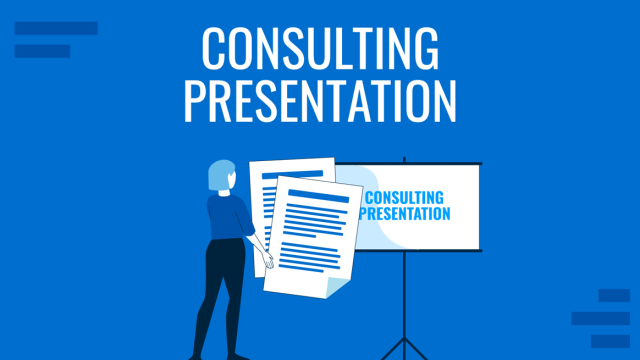
Filed under Business • April 4th, 2024
Consulting Presentation Slides: A Guide to PPT Consultant Tools
Get to know the best tools to craft a consulting presentation by area of interest. Fully detailed guide plus template list.

Filed under Design • March 27th, 2024
How to Make a Presentation Graph
Detailed step-by-step instructions to master the art of how to make a presentation graph in PowerPoint and Google Slides. Check it out!

Filed under Business • March 13th, 2024
Exploring the Significance of the Fit Gap Analysis (Examples + Templates)
Master the Fit Gap Analysis with this guide featuring professionally designed PPT templates and step-by-step examples.
Leave a Reply
- SUGGESTED TOPICS
- The Magazine
- Newsletters
- Managing Yourself
- Managing Teams
- Work-life Balance
- The Big Idea
- Data & Visuals
- Reading Lists
- Case Selections
- HBR Learning
- Topic Feeds
- Account Settings
- Email Preferences
The Right Way to Present Your Business Case
- Carolyn O’Hara

Get key stakeholders on board with one effective presentation.
You’ve already put a great deal of work into preparing a solid business case for your project or idea. But when it comes to the critical presentation phase, how do you earn the support of decision makers in the room? How do you present your case so that it’s clear and straightforward while also persuasive?
- Carolyn O’Hara is a writer and editor based in New York City. She’s worked at The Week, PBS NewsHour, and Foreign Policy. carolynohara1
Partner Center
.css-s5s6ko{margin-right:42px;color:#F5F4F3;}@media (max-width: 1120px){.css-s5s6ko{margin-right:12px;}} Join us: Learn how to build a trusted AI strategy to support your company's intelligent transformation, featuring Forrester .css-1ixh9fn{display:inline-block;}@media (max-width: 480px){.css-1ixh9fn{display:block;margin-top:12px;}} .css-1uaoevr-heading-6{font-size:14px;line-height:24px;font-weight:500;-webkit-text-decoration:underline;text-decoration:underline;color:#F5F4F3;}.css-1uaoevr-heading-6:hover{color:#F5F4F3;} .css-ora5nu-heading-6{display:-webkit-box;display:-webkit-flex;display:-ms-flexbox;display:flex;-webkit-align-items:center;-webkit-box-align:center;-ms-flex-align:center;align-items:center;-webkit-box-pack:start;-ms-flex-pack:start;-webkit-justify-content:flex-start;justify-content:flex-start;color:#0D0E10;-webkit-transition:all 0.3s;transition:all 0.3s;position:relative;font-size:16px;line-height:28px;padding:0;font-size:14px;line-height:24px;font-weight:500;-webkit-text-decoration:underline;text-decoration:underline;color:#F5F4F3;}.css-ora5nu-heading-6:hover{border-bottom:0;color:#CD4848;}.css-ora5nu-heading-6:hover path{fill:#CD4848;}.css-ora5nu-heading-6:hover div{border-color:#CD4848;}.css-ora5nu-heading-6:hover div:before{border-left-color:#CD4848;}.css-ora5nu-heading-6:active{border-bottom:0;background-color:#EBE8E8;color:#0D0E10;}.css-ora5nu-heading-6:active path{fill:#0D0E10;}.css-ora5nu-heading-6:active div{border-color:#0D0E10;}.css-ora5nu-heading-6:active div:before{border-left-color:#0D0E10;}.css-ora5nu-heading-6:hover{color:#F5F4F3;} Register now .css-1k6cidy{width:11px;height:11px;margin-left:8px;}.css-1k6cidy path{fill:currentColor;}
- Project planning |
- The beginner’s guide to writing an effe ...
The beginner’s guide to writing an effective business case

Nearly every project needs to be approved—whether that means getting the simple go-ahead from your team or gaining the support of an executive stakeholder. You may be familiar with using a project plan or project charter to propose a new initiative and get the green light for a project. But if your proposed project represents a significant business investment, you may need to build a business case.
If you’ve never written a business case, we’re here to help. With a few resources and a little planning, you can write a business case that will help you get the resources and support you need to manage a successful project.
What is a business case?
A business case is a document that explains the value or benefits your company will gain if you pursue a significant business investment or initiative. This initiative can be anything from the messaging for a new product or feature launch, a proposal to increase spend on a current initiative, or a significant investment with a new agency or contractor—to name a few. A compelling business case will outline the expected benefits of this significant investment decision. Key stakeholders will use the business case you provide to determine whether or not to move forward with an initiative.
If you’ve never created a business case, it may sound similar to other early project planning documentation. Here’s how it stacks up:
The difference between a business case and business plan
A business case is a proposal for a new strategy or large initiative. It should outline the business needs and benefits your company will receive from pursuing this opportunity.
A business plan , on the other hand, is an outline for a totally new business. Typically, you’d draft a business plan to map out your business strategy, your mission and vision statements, and how you’re planning on getting there. There may be a case where you create a business plan for an already-existing business, but you’d only do so if you’re trying to take your business in a significantly new direction.
Business case vs. executive summary
Business case vs. project charter.
If you need to create an elevator pitch for your project but you don’t quite need the full business case treatment, you might need a project charter. Much like a business case, a project charter outlines key details of an initiative. Specifically, a project charter will cover three main elements of your project: project objectives, project scope, and key project stakeholders. Your management team will then use the project charter to approve further project development.
Do you need a business case?
Not every project needs a business case—or even a project charter. Plan to build a business case only for initiatives or investments that will require significant business resources. If you’re working on a smaller initiative, consider creating a project charter to pitch your project idea to relevant stakeholders.
Even if you don’t need to pitch your project to any stakeholders, you should be ready to answer basic questions about your proposed project, like:
What is this project’s purpose?
Why are we working on this project?
How does this project connect to organizational goals and objectives?
Which metrics will we use to measure the success of the project ?
Who is working on this project?
When is this project going to be completed?
5 steps for creating and pitching a business case
Your business case shouldn’t just include key facts and figures—it should also tell a story of why pursuing a particular investment or initiative is a good idea for your business. When in doubt, avoid jargon and be brief—but always focus on communicating the value of the project. If this is your first time creating a business case, don’t worry. Follow these five steps to create a solid one.
1. Gather input
You don’t have to write a business case on your own. Instead, make sure appropriate team members and stakeholders are contributing to the relevant sections. For example, the IT team should be involved in any tooling and timeline decisions, while the finance team should review any budget and risk management sections. If you’re creating a business case to propose a new initiative, product line, or customer persona, make sure you also consult subject matter experts.
2. Plan to write your business case out of order
Some of the first things that appear in your business case—like your executive summary—should actually be drafted last, when you have all of the resources and information to make an informed suggestion. Your executive summary will present all of your findings and make a recommendation for the business based on a variety of factors. By gathering all of those details first—like project purpose, financial information, and project risk—you can ensure your executive summary has all of the relevant information.
3. Build your business case incrementally
A business case describes a significant investment for your company. Similarly, simply writing a business case is a significant investment of your time. Not every initiative is right for your business—so make sure you’re checking your work with stakeholders as you go. You don’t want to sink hours and weeks into this document only for it to be rejected by executive stakeholders right off the bat.
Consider doing a “soft launch” with an outline of your business case to your project sponsor or an executive stakeholder you have a good relationship with to confirm this initiative is something you should pursue. Then, as you build the different sections of your business case, check back in with your key stakeholders to confirm there are no deal-breakers.
4. Refine the document
As you create sections of your business case, you may need to go back and refine other sections. For example, once you’ve finished doing a cost-benefit analysis with your financial team, make sure you update any budget-related project risks.
Before presenting your business case, do a final read through with key stakeholders to look for any sections that can be further refined. At this stage, you’ll also want to write the executive summary that goes at the top of the document. Depending on the length of your business case, your executive summary should be one to two pages long.
5. Present the business case
The final step is to actually present your business case. Start with a quick elevator pitch that answers the what, why, and how of your proposal. Think of this presentation as your chance to explain the current business need, how your proposal addresses the need, and what the business benefits are. Make sure to address any risks or concerns you think your audience would have.
Don’t go through your business case page by page. Instead, share the document with stakeholders before the presentation so they have a chance to read through it ahead of time. Then, after your presentation, share the document again so stakeholders can dig into details.
A business case checklist
Start with the why.
The first section of the business case is your chance to make a compelling argument about the new project. Make sure you draft an argument that appeals to your audience’s interests and needs. Despite being the first section in your business case, this should be the last section you write. In addition to including the traditional elements of an executive summary , make sure you answer:
What business problem is your project solving? This is your chance to explain why your project is important and why executive stakeholders should consider pursuing this opportunity.
What is your business objective ? What happens at the end of a successful project? How will you measure success—and what does a successful project mean for your business?
How does this business case fit into your overall company business strategy plan? Make sure your proposed business case is connected to important company goals . The initiative proposed in your business case should move the needle towards your company's vision statement .
Outline financials and the return on investment
At this point in your business case, you should outline the project finance fundamentals. Don’t expect to create this section on your own—you should draft this in partnership with your company’s finance team. In particular, this section should answer:
How much will this project cost? Even if the initiative is completely new to your company, do some research to estimate the project costs.
What does each individual component of the project cost? In addition to estimating the total overall cost, break down the different project costs. For example, you might have project costs for new tools and resources, competitive intelligence resourcing, agency costs, etc.
What is the expected return on investment (ROI)? You’ve talked about the costs—now talk about how your company will benefit from this initiative. Make sure to explain how you calculated the ROI, too.
How will this project impact cash flow? Cash flow is the amount of money being transferred into and out of your business. Significant investments are going to cost a lot of money, so they’ll negatively impact cash flow—but you should also expect a high ROI, which will positively impact cash flow.
What is the sensitivity analysis? Sensitivity analysis is a summary of how uncertain your numbers are. There will be a variety of variables that impact your business case. Make sure to explain what those variables are, and how that could impact your projections.
Preview project details
Your business case is proposing a new initiative. In addition to the financial risks, take some time to preview project details. For example, your business case should include:
Your project objectives and key project deliverables . What will happen at the end of the project? What are you expecting to create or deliver once the project is over?
Your project plan . A project plan is a blueprint of the key elements your team needs to accomplish in order to successfully achieve your project goals.
The project scope . What are the boundaries of your project? What exact goals, deliverables, and deadlines will you be working towards?
A list of relevant project stakeholders . Who are the important project stakeholders and key decision makers for this work? This can include the members of the project team that would be working on this initiative, executive stakeholders who would sponsor the project, and any external stakeholders who might be involved.
A general project roadmap in a Gantt-chart like view. At this stage in the process, you don’t need to provide a detailed project timeline, but you should outline a general sense of when each project stage will happen in relation to the others. To do this, create a project roadmap in Gantt-chart like software . Make sure to include any important project milestones in your roadmap as well.
Any important project dependencies. Is there anything that would get in the way of this project getting started? Does this work rely on any other work that’s currently in flight?
Discuss project risks
Once you’ve outlined the financial impact and important project details, make sure you include any potential project risks. If you haven’t already, create a project risk management plan for your business case. Project risk management isn’t the process of eliminating risk—instead, it’s about identifying, analyzing, and proactively responding to any potential project risks. Clearly defining each project risk and how that risk might impact your project can best equip you and the project team to manage and avoid those risks.
In the risk section of your business case, include:
A risk analysis of any potential project risks. What is the risk? How likely is it to happen? What is the priority level of this risk?
What, if any, assumptions you are making. In project risk management, assumptions are anything you think will be true about the project, without those details being guaranteed facts. Basing project decisions around an assumption can open your project up to risk. Make sure you ratify every project assumption to avoid jeopardizing project success.
Any comparable alternatives in the market. If you’re writing a business case to pitch a new product or angle in the market, evaluate anything that already exists. Could the alternative impact your financial assessment or project success?
Develop an action plan
In the final section of your business case, outline how you will turn this business case into an actionable project. This section should answer questions like:
How will decisions be made? Who is responsible for the project? Who is the project sponsor? If you haven’t already, consider creating a RACI chart to outline project responsibilities.
How will progress be measured and reported? Not every project stakeholder needs to be notified of every project change. Outline key parts of your project communication plan , as well as how you’ll communicate project status updates .
What is the next course of action? If the management team ratifies this business case, what next steps will you take to put this into action?
Bring your business case to life
You’ve built a solid business case and it’s been ratified—congratulations! The next step is to bring your business case to life. It can be intimidating to initiate large-scale change , and implementing your business case is no exception.
If you haven’t already, make sure you have a project management tool in place to manage and organize your new initiative. With a central source of truth to track who’s doing what by when, share status updates, and keep project stakeholders in the loop, you can turn a great business case into a successful project.
Related resources

Unmanaged business goals don’t work. Here’s what does.

How Asana uses work management to drive product development

How Asana uses work management to streamline project intake processes

How Asana uses work management for smoother creative production
- Google Slides Presentation Design
- Pitch Deck Design
- Powerpoint Redesign
- Other Design Services

- Business Slides
Business case presentation: how to prepare, write, and present
A compelling business case and its high-quality presentation are the primary keys to the problem transformation and success. Most organizations fail to address both the critical success factor and business case presentation that can display benefits, reveal costs, and attract investments of key stakeholders, decision-makers, and funders. Addressing PowerPoint presentation services is the best way to make sure you are prepared well, but you can always start doing it on your own with our tips from the article below.
Let’s review what business case PPT should include and how to improve it to gain the expected effect and financial result.

What is a Business Case?
Initially, the business case is a short document or presentation that justifies a specific project and required investments. It describes why your organization should invest in some initiative or tells your audience (senior management, project sponsor) why they need to do so. The purpose of the business case is to convince people that the challenge or opportunity your organization is facing is significant enough to tackle and worth implementing the solution and taking advantage.
Any business case consists of:
- Benefits: revenue potential, operational improvements, cost avoidance, risk reduction.
- Costs: current state, future state, cost buildup, external vendors.
Indeed, no management would approve solutions that give no profitability. That is why business analysts exist. And that is why a PowerPoint business case is required to outline and deliver your message clearly while attractively.
What Is a Business Case Presentation?
Most companies mistake seeing the business case presentation as a nice nuance to have in stock. However, there’s a complete lack of direction, vision, and governance without a solid business case PowerPoint that depicts numbers, main statements, and all necessary context.
It also helps manage and assess the viability of the proposed solution.
To prepare for the presentation, make sure you’ve completed these steps:
- Investigate and analyze the market and competitors.
- Compare and conclude methods.
- Gather data.
- Elaborate on strategies, purposes, and alternatives.
- Prepare text document.
Never start doing the presentation when the text is not ready. Words are easy to rewrite but replacing charts every time one number changes takes too much time.
Business Case Presentation Structure
A business case presentation aims to present and demonstrate some problem analysis and proposed solutions. To make your thinking process clear for your audience, make sure you follow this body structure and include these elements in your business case slides:
1. Problem Statement
Give a brief description of your problem, its importance, and its urgency. You can also include background and what contributed to the problem’s occurrence.
2. Gap Analysis
This slide, or better, a set of 2-3 slides, has to show the difference between your current business situation and your desired achievements in the future. A thorough analysis must include shortcomings and steps to be taken to achieve the necessary results.
3. Action Plan
The slides of this section have to display a detailed list of steps to be taken to incorporate the proposed solution to your specific business case. We advise adding no more than 3 steps per slide, or you can add one step per slide with, e.g., some relevant infographics.
4. Costs and Benefits
If you know how, estimate and calculate the size of investment required, and do not forget about extra checks that will always appear from nowhere. Address intangible benefits, higher morale, etc. Use pies, lines, and charts.
Develop a plan or at least punctual actions to mitigate risks or omit them at all if possible.
6. Organizational Impact
It can be both negative and positive. Do not hide any 🙂
7. Comparison of Alternatives
Here, add an overview of different solutions related to your case. Comparison in charts or tables will help better visualize differences in time and resources needed to gain every solution.

How to Make a Business Case Presentation More Engaging?
You can benefit greatly from attractive slides that keep the audience’s attention and still deliver information effectively. Here are design tips for your business case presentation PPT:
- Use visual metaphors to communicate your message faster and clearer.
- Use icons, background images, and diagrams to visualize data.
- Don’t use stock templates, and order pitch deck slides from an agency if possible.
- Limit the volume of text per slide to no more than 6 lines.
- Use fonts that can be seen in the last rows.
- Use only background images that contrast with the text.
You will more likely have a long business speech with terms and statistics, so make sure your audience doesn’t sleep when you finally present solutions and plan to fulfill them.
Consider the business case PowerPoint presentation as the opportunity to bundle your project idea to demonstrate what it means, what it requires, and what benefits it offers. As we’ve defined, it is an extended piece that should include your strategies, goals, and ways and terms to achieve them. In other words, it is your business proposal that can be depicted attractively with the power of PowerPoint. Infographics, animation, and other special effects and tools can make your slides more engaging and understandable to your specific audience.
If you struggle with the design of your business case, make sure you contact us and get a free consultation on how your material can be improved.
#ezw_tco-2 .ez-toc-widget-container ul.ez-toc-list li.active::before { background-color: #ededed; } Table of contents
- Presenting techniques
- 50 tips on how to improve PowerPoint presentations in 2022-2023 [Updated]
- Keynote VS PowerPoint
- Types of presentations
- Present financial information visually in PowerPoint to drive results

- Guide & How to's
How to create a business plan presentation?

- Design Tips
Inspiration for PPT: how to find design ideas

Private: Difference between business plan and pitch deck: 2022 ultimate guide
Advisory boards aren’t only for executives. Join the LogRocket Content Advisory Board today →

- Product Management
- Solve User-Reported Issues
- Find Issues Faster
- Optimize Conversion and Adoption
What is a business case and how to write one (with template)

In this guide, we’ll define what a business case is, help you determine when you need one (and when you don’t), and walk you through a four-step process for creating a business case.

We’ll also outline what you should include in a business case and provide a free template you can use when writing a business case to secure stakeholder support for your next big project.
What is a business case?
Every project needs the support and approval of key stakeholders before it can launch. Many project and product leaders use a project plan or charter to communicate pertinent details to those involved.
Similarly, for large initiatives that require significant resources, potential investors are presented a business case outlining the costs, benefits, business need, and risks involved.
A business case is a document that defines the value it will deliver if executed and benefits the company over the costs involved. With a thorough understanding of the components to be included and necessary resources, it is possible to create a compelling business plan.
Why do you need a business case?
If a project is green-lit without a business case, it can lead to serious issues down the road. A project without clearly articulated expectations and goals can go on endlessly and aimlessly. This leads to wasted resources, money, and time with no outcome in the end.
A business case enables you to:
Align with strategy
Gain stakeholder support, prioritize projects, track outcomes.
A business case helps to showcase how a project is aligned with the overall strategy and goals of the organization. It clearly defines the problem or opportunity that the project is intended to address.
A business case also enables you to determine expected benefits and outcomes before you start a project or initiatives, thus projecting how the project contribute to achieving the organization’s goals.
A business case is a useful tool to provide a clear rationale for pursuing the project. A thorough business case can help key stakeholders decide whether to invest in the project by evaluating the feasibility, costs, risks and potential returns. A business case presentation gives stakeholders an opportunity to ask questions and address concerns.
A business case defines the value that the project is expected to deliver. Based on the value delivered by each project, business and product leaders can prioritize projects for budget cuts or further investments. Proper prioritization helps the organization achieve the goals aligned with the business strategy.
A business case provides a roadmap for the project, including the goals, milestones, and key deliverables. Once the project starts, a roadmap helps you keep track of your progress toward project goals, including what has already been achieved and what will be delivered at the end. Providing a timely update on the project to the key stakeholders is critical for setting expectations.
When you don’t need a business case
A business case is certainly helpful for large initiatives requiring support from key stakeholders, but there are some situations where creating a business case might be a waste of time.

Over 200k developers and product managers use LogRocket to create better digital experiences
For instance, small or low-risk projects that would not impact the organization in any negative way do not require a business case because it would not make sense to spend that much effort on a low-scale project.
A business case might also be considered superfluous for a project that is already ongoing. It can be tempting to create a business case post-launch for the sole purpose of documenting decisions made and milestones achieved. However, it’s typically not worth the time investment because such a business case rarely adds any value or insights.
Before you take on the task of creating a business case, it’s important to carefully consider the need and to ensure that doing so would produce valuable insights to the decision-making process. It is in the best interest of everyone to forgo the business case creation process in situations where it does not provide any additional value and to focus instead on other activities that directly impact the project.
Business case vs. business plan
A business plan is not the same thing as a business case.
A business case outlines a proposed project and its potential benefits to convince key stakeholders to invest. It typically includes analysis of costs, value to be delivered, and associated risks, along with ROI.
A business plan, on the other hand, outlines the overall strategy and goals for an entire organization. It defines the what, why, and who for the business, covering the products and services offered, target segment, marketing and sales strategy, and operational and financial projections over a period of time. A business plan is designed to help potential outside investors make informed decisions about whether the business is worth investing in.
The table below breaks down the differences between a business plan and a business case:
How to write a business case
Before we dive into steps to create a business case, let’s review what we’ve learned so far:
- A business case is a document created during the initiation of the project but is referred throughout the project lifecycle
- A strong business case helps in building confidence and gaining support of key stakeholders
- A business case also helps you track a project’s progress over time
- A weak business case that is not aligned with strategy can lead to project failure
To write a business case, follow this four-step process:
- Identify the business need
- Explore all possible solutions
- Propose the best approach
- Outline the implementation process
1. Identify the business need
Projects are initiated to solve a business need and achieve a value or a benefit aligned to the goals of the organization.
The first step to create a business case is to identify the business problem and define it clearly. Market research and any available data to justify the business need is helpful to include in the business case.
2. Explore all possible solutions
Once the business problem has been identified, the next step is to explore all the possible solutions for that problem. You can do this systematically by listing out all the possible solutions along with other parameters, such as:
- The benefits of each approach
- Feasibility
- Time period
- Assumptions
A detailed analysis of each option predicting the cash flows, ROI, and value delivered would help key stakeholders understand each solution and cross-question the assumptions, feasibility, and other parameters.
3. Propose the best approach
Set a criteria to showcase how you evaluate each solution and then come up with the best out of the list.
To set the criteria, identify attributes that closely align to the organization’s strategy. For example, if the organization’s goal is to increase revenue in the next year, then an important criterion might be the solution with maximum revenue projection.
List the top three-to-five attributes to evaluate alternative solutions against and rank each solution 1–5. Once you rank all of them, total the ranks for all the attributes to indicate a clear winner.
Document this process and present it to stakeholders to ensure they are on the same page with the selection process of the best solution.
4. Outline the implementation process
Once the best solution has been proposed, the next step is to think about how it will be implemented.
When it comes to planning the implementation process, you need to define:
- Resources needed
- Timeline from initiation till the end
- Risks and how to mitigate
- Milestones and when they will be achieved
- Total cost involved and how much will be used by when
These four steps, when captured in detail, can help you win the support of key stakeholders and kick off your project with a solid foundation and a clear objective.
What is included in a business case?
Now that we’ve walked through the steps of how to create a business case, let us also take a look at what to include in the business case document to support the four steps outlined above.
Here’s what to include in a business case:
- Executive summary — A quick overview of the project and the topics being covered in the business case
- Business problem — A description of the business problem and why it is important to solve it
- Possible solutions — A list of possible solutions and how the best possible solution is identified
- Project definition — Define the business objectives to be achieved along with general information about the project
- Project plan — Create the project plan with key elements your team needs to accomplish to successfully achieve your project goals
- Project scope — Clearly define what would be covered as a part of the project and what is out of scope to avoid any confusion
- Project budget — Estimated cost involved to complete the project needs to be captured with a detailed breakdown
- Project roadmap — Projection of the estimated timeline for each stage of the project to be done. Be sure to include any important project milestones
- Project financials — Financial metrics depicting the cash flow, such as NPV, IRR, ROI, and payback period to help stakeholders understand the financial value the project can bring in over a period of time
- Risk assessment — Capture the risks involved and the steps planned to mitigate the risks
- Project stakeholders — A list of key stakeholders involved can help anyone looking at the document to reach out to them when needed. The list can include the project team, sponsoring executives, and any external stakeholders who might be involved
Business case template
To help you get started writing a business case for your next big project or initiative, we created a business case template that you can download and customize for free.
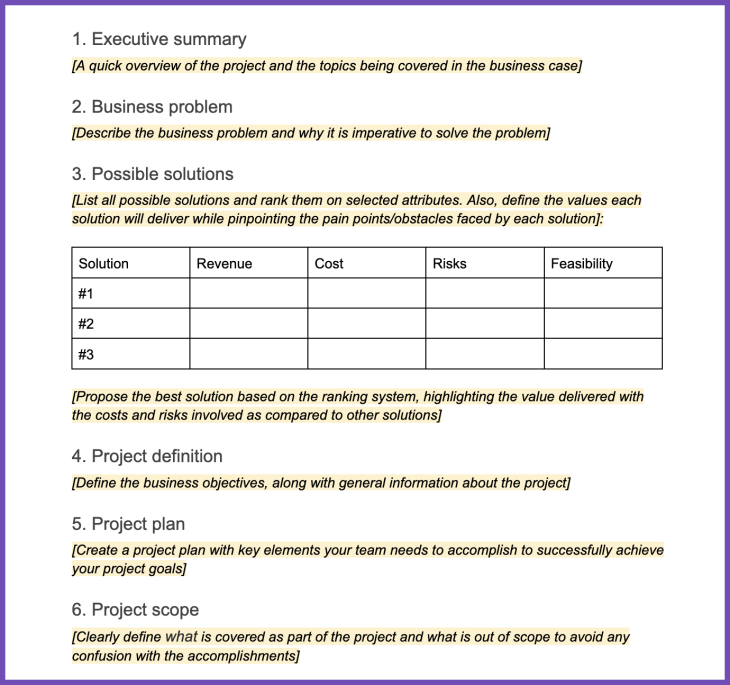
You can access this simple business case template by clicking here (be sure to select File > Make a copy from the main menu bar before editing the template).
Preparing the business case is only half the journey of initiating a project. The next step is to present the business plan to key stakeholders , answer their queries, and compel them to support the project.
Lastly, be sure to follow up with the attendees to make sure all the stakeholders are on the same page and aligned to support the project.
LogRocket generates product insights that lead to meaningful action
Get your teams on the same page — try LogRocket today.
Share this:
- Click to share on Twitter (Opens in new window)
- Click to share on Reddit (Opens in new window)
- Click to share on LinkedIn (Opens in new window)
- Click to share on Facebook (Opens in new window)
- #collaboration and communication
- #project management

Stop guessing about your digital experience with LogRocket
Recent posts:.

Leader Spotlight: The importance of challenging assumptions, with Alex Swain
Alex Swain talks about how the key to avoiding building a product that nobody will purchase is to always challenge assumptions.

How to use the PR/FAQ method to drive product innovation
The PR/FAQ method helps you clarify your vision, communicate your strategy, validate your assumptions, and solicit feedback from others.

Leader Spotlight: The nuances of quality localization, with Drew Wrangles
Drew Wrangles, Head of Product & Design at Taskrabbit, shares his experiences leading product localization.

Techniques for gaining insights from customers
A deep understanding of your customers helps you prioritize problems, define solutions, and adjust communications.

Leave a Reply Cancel reply
- Contact sales
Start free trial
How to Write a Business Case (Template Included)

Table of Contents
What is a business case, how to write a business case, business case template, watch our business case training video, key elements of a business case, how projectmanager helps with your business case.
A business case is a project management document that explains how the benefits of a project overweigh its costs and why it should be executed. Business cases are prepared during the project initiation phase and their purpose is to include all the project’s objectives, costs and benefits to convince stakeholders of its value.
A business case is an important project document to prove to your client, customer or stakeholder that the project proposal you’re pitching is a sound investment. Below, we illustrate the steps to writing one that will sway them.
The need for a business case is that it collects the financial appraisal, proposal, strategy and marketing plan in one document and offers a full look at how the project will benefit the organization. Once your business case is approved by the project stakeholders, you can begin the project planning phase.
Projects fail without having a solid business case to rest on, as this project document is the base for the project charter and project plan. But if a project business case is not anchored to reality, and doesn’t address a need that aligns with the larger business objectives of the organization, then it is irrelevant.

Get your free
Use this free Business Case Template for Word to manage your projects better.
The research you’ll need to create a strong business case is the why, what, how and who of your project. This must be clearly communicated. The elements of your business case will address the why but in greater detail. Think of the business case as a document that is created during the project initiation phase but will be used as a reference throughout the project life cycle.
Whether you’re starting a new project or mid-way through one, take time to write up a business case to justify the project expenditure by identifying the business benefits your project will deliver and that your stakeholders are most interested in reaping from the work. The following four steps will show you how to write a business case.
Step 1: Identify the Business Problem
Projects aren’t created for projects’ sake. They should always be aligned with business goals . Usually, they’re initiated to solve a specific business problem or create a business opportunity.
You should “Lead with the need.” Your first job is to figure out what that problem or opportunity is, describe it, find out where it comes from and then address the time frame needed to deal with it.
This can be a simple statement but is best articulated with some research into the economic climate and the competitive landscape to justify the timing of the project.
Step 2: Identify the Alternative Solutions
How do you know whether the project you’re undertaking is the best possible solution to the problem defined above? Naturally, prioritizing projects is hard, and the path to success is not paved with unfounded assumptions.
One way to narrow down the focus to make the right solution clear is to follow these six steps (after the relevant research, of course):
- Note the alternative solutions.
- For each solution, quantify its benefits.
- Also, forecast the costs involved in each solution.
- Then figure out its feasibility .
- Discern the risks and issues associated with each solution.
- Finally, document all this in your business case.
Step 3: Recommend a Preferred Solution
You’ll next need to rank the solutions, but before doing that it’s best to set up criteria, maybe have a scoring mechanism such as a decision matrix to help you prioritize the solutions to best choose the right one.
Some methodologies you can apply include:
- Depending on the solution’s cost and benefit , give it a score of 1-10.
- Base your score on what’s important to you.
- Add more complexity to your ranking to cover all bases.
Regardless of your approach, once you’ve added up your numbers, the best solution to your problem will become evident. Again, you’ll want to have this process also documented in your business case.
Step 4: Describe the Implementation Approach
So, you’ve identified your business problem or opportunity and how to reach it, now you have to convince your stakeholders that you’re right and have the best way to implement a process to achieve your goals. That’s why documentation is so important; it offers a practical path to solve the core problem you identified.
Now, it’s not just an exercise to appease senior leadership. Who knows what you might uncover in the research you put into exploring the underlying problem and determining alternative solutions? You might save the organization millions with an alternate solution than the one initially proposed. When you put in the work on a strong business case, you’re able to get your sponsors or organizational leadership on board with you and have a clear vision as to how to ensure the delivery of the business benefits they expect.
Our business case template for Word is the perfect tool to start writing a business case. It has 9 key business case areas you can customize as needed. Download the template for free and follow the steps below to create a great business case for all your projects.

One of the key steps to starting a business case is to have a business case checklist. The following is a detailed outline to follow when developing your business case. You can choose which of these elements are the most relevant to your project stakeholders and add them to our business case template. Then once your business case is approved, start managing your projects with a robust project management software such as ProjectManager.
1. Executive Summary
The executive summary is a short version of each section of your business case. It’s used to give stakeholders a quick overview of your project.
2. Project Definition
This section is meant to provide general information about your projects, such as the business objectives that will be achieved and the project plan outline.
3. Vision, Goals and Objectives
First, you have to figure out what you’re trying to do and what is the problem you want to solve. You’ll need to define your project vision, goals and objectives. This will help you shape your project scope and identify project deliverables.
4. Project Scope
The project scope determines all the tasks and deliverables that will be executed in your project to reach your business objectives.
5. Background Information
Here you can provide a context for your project, explaining the problem that it’s meant to solve, and how it aligns with your organization’s vision and strategic plan.
6. Success Criteria and Stakeholder Requirements
Depending on what kind of project you’re working on, the quality requirements will differ, but they are critical to the project’s success. Collect all of them, figure out what determines if you’ve successfully met them and report on the results .
7. Project Plan
It’s time to create the project plan. Figure out the tasks you’ll have to take to get the project done. You can use a work breakdown structure template to make sure you are through. Once you have all the tasks collected, estimate how long it will take to complete each one.
Project management software makes creating a project plan significantly easier. ProjectManager can upload your work breakdown structure template and all your tasks are populated in our tool. You can organize them according to your production cycle with our kanban board view, or use our Gantt chart view to create a project schedule.

8. Project Budget
Your budget is an estimate of everything in your project plan and what it will cost to complete the project over the scheduled time allotted.
9. Project Schedule
Make a timeline for the project by estimating how long it will take to get each task completed. For a more impactful project schedule , use a tool to make a Gantt chart, and print it out. This will provide that extra flourish of data visualization and skill that Excel sheets lack.
10. Project Governance
Project governance refers to all the project management rules and procedures that apply to your project. For example, it defines the roles and responsibilities of the project team members and the framework for decision-making.
11. Communication Plan
Have milestones for check-ins and status updates, as well as determine how stakeholders will stay aware of the progress over the project life cycle.
12. Progress Reports
Have a plan in place to monitor and track your progress during the project to compare planned to actual progress. There are project tracking tools that can help you monitor progress and performance.
Again, using a project management tool improves your ability to see what’s happening in your project. ProjectManager has tracking tools like dashboards and status reports that give you a high-level view and more detail, respectively. Unlike light-weight apps that make you set up a dashboard, ours is embedded in the tool. Better still, our cloud-based software gives you real-time data for more insightful decision-making. Also, get reports on more than just status updates, but timesheets, workload, portfolio status and much more, all with just one click. Then filter the reports and share them with stakeholders to keep them updated.

13. Financial Appraisal
This is a very important section of your business case because this is where you explain how the financial benefits outweigh the project costs . Compare the financial costs and benefits of your project. You can do this by doing a sensitivity analysis and a cost-benefit analysis.
14. Market Assessment
Research your market, competitors and industry, to find opportunities and threats
15. Competitor Analysis
Identify direct and indirect competitors and do an assessment of their products, strengths, competitive advantages and their business strategy.
16. SWOT Analysis
A SWOT analysis helps you identify your organization’s strengths, weaknesses, opportunities and threats. The strengths and weaknesses are internal, while the opportunities and threats are external.
17. Marketing Strategy
Describe your product, distribution channels, pricing, target customers among other aspects of your marketing plan or strategy.
18. Risk Assessment
There are many risk categories that can impact your project. The first step to mitigating them is to identify and analyze the risks associated with your project activities.
ProjectManager , an award-winning project management software, can collect and assemble all the various data you’ll be collecting, and then easily share it both with your team and project sponsors.
Once you have a spreadsheet with all your tasks listed, you can import it into our software. Then it’s instantly populated into a Gantt chart . Simply set the duration for each of the tasks, add any dependencies, and your project is now spread across a timeline. You can set milestones, but there is so much more you can do.

You have a project plan now, and from the online Gantt chart, you can assign team members to tasks. Then they can comment directly on the tasks they’re working on, adding as many documents and images as needed, fostering a collaborative environment. You can track their progress and change task durations as needed by dragging and dropping the start and end dates.
But that’s only a taste of what ProjectManager offers. We have kanban boards that visualize your workflow and a real-time dashboard that tracks six project metrics for the most accurate view of your project possible.
Try ProjectManager and see for yourself with this 30-day free trial .
If you want more business case advice, take a moment to watch Jennifer Bridges, PMP, in this short training video. She explains the steps you have to take in order to write a good business case.
Here’s a screenshot for your reference.

Transcription:
Today we’re talking about how to write a business case. Well, over the past few years, we’ve seen the market, or maybe organizations, companies or even projects, move away from doing business cases. But, these days, companies, organizations, and those same projects are scrutinizing the investments and they’re really seeking a rate of return.
So now, think of the business case as your opportunity to package your project, your idea, your opportunity, and show what it means and what the benefits are and how other people can benefit.
We want to take a look today to see what’s in the business case and how to write one. I want to be clear that when you look for information on a business case, it’s not a briefcase.
Someone called the other day and they were confused because they were looking for something, and they kept pulling up briefcases. That’s not what we’re talking about today. What we’re talking about are business cases, and they include information about your strategies, about your goals. It is your business proposal. It has your business outline, your business strategy, and even your marketing plan.
Why Do You Need a Business Case?
And so, why is that so important today? Again, companies are seeking not only their project managers but their team members to have a better understanding of business and more of an idea business acumen. So this business case provides the justification for the proposed business change or plan. It outlines the allocation of capital that you may be seeking and the resources required to implement it. Then, it can be an action plan . It may just serve as a unified vision. And then it also provides the decision-makers with different options.
So let’s look more at the steps required to put these business cases together. There are four main steps. One, you want to research your market. Really look at what’s out there, where are the needs, where are the gaps that you can serve? Look at your competition. How are they approaching this, and how can you maybe provide some other alternatives?
You want to compare and finalize different approaches that you can use to go to market. Then you compile that data and you present strategies, your goals and other options to be considered.
And then you literally document it.
So what does the document look like? Well, there are templates out there today. The components vary, but these are the common ones. And then these are what I consider essential. So there’s the executive summary. This is just a summary of your company, what your management team may look like, a summary of your product and service and your market.
The business description gives a little bit more history about your company and the mission statement and really what your company is about and how this product or service fits in.
Then, you outline the details of the product or service that you’re looking to either expand or roll out or implement. You may even include in their patents may be that you have pending or other trademarks.
Then, you want to identify and lay out your marketing strategy. Like, how are you gonna take this to your customers? Are you going to have a brick-and-mortar store? Are you gonna do this online? And, what are your plans to take it to market?
You also want to include detailed information about your competitor analysis. How are they doing things? And, how are you planning on, I guess, beating your competition?
You also want to look at and identify your SWOT. And the SWOT is your strength. What are the strengths that you have in going to market? And where are the weaknesses? Maybe some of your gaps. And further, where are your opportunities and maybe threats that you need to plan for? Then the overview of the operation includes operational information like your production, even human resources, information about the day-to-day operations of your company.
And then, your financial plan includes your profit statement, your profit and loss, any of your financials, any collateral that you may have, and any kind of investments that you may be seeking.
So these are the components of your business case. This is why it’s so important. And if you need a tool that can help you manage and track this process, then sign up for our software now at ProjectManager .

Deliver your projects on time and under budget
Start planning your projects.
Business case presentation: A comprehensive guide
Master business case presentations with this guide: audience, argument, and delivery.
Raja Bothra
Building presentations

Hey there, fellow business enthusiasts!
If you're reading this, you're probably no stranger to the term "business case." In fact, you might be here because you're keen to unravel the art of crafting an impressive business case presentation. Well, you're in the right place!
In this comprehensive guide, we're diving deep into the world of business cases, exploring why they're crucial, when to create one, and how to structure an effective business case presentation. Plus, we'll sprinkle in some do's and don'ts to ensure your presentation shines.
So, buckle up, because by the end of this journey, you'll be equipped with the skills to create a business case presentation that wows your stakeholders, just like a pro. Ready? Let's dive in!
What is a business case?
First things first, let's clarify what exactly we mean by a business case. It's more than just a buzzword; it's a powerful tool that helps organizations make informed decisions.
At its core, a business case is a document that outlines the rationale for initiating a project or making a significant business-related decision. It's like the blueprint for your business move, offering a structured way to assess the potential risks, benefits, and costs involved.
But here's the kicker: A well-crafted business case isn't just about numbers and graphs; it's a persuasive narrative that tells a compelling story about why your idea is worth pursuing. It's your secret weapon to gain buy-in from key decision-makers.
Why do you need a business case?
Now that you know what a business case is, you might be wondering why you need one. Well, here's the deal:
Clarity and focus : A business case forces you to articulate your idea clearly and concisely. It's like putting your thoughts through a refining process, leaving you with a crystal-clear vision.
Risk mitigation : Projects or decisions without a solid business case are like ships without navigation. It helps you identify potential pitfalls and navigate around them.
Resource allocation : Limited resources demand wise allocation. A business case helps you justify why your project deserves those resources.
Stakeholder buy-in : Ever tried convincing your team or investors without data? A business case equips you with the data-driven argument you need to win them over.
When should you create a business case presentation?
Alright, you're convinced of the importance of a business case. But when should you whip out your presentation skills? Here are some scenarios:
- Launching a new product or service : When introducing something new, a solid business case can prove it's worth the investment.
- Changing business processes : If you're considering a major shift in operations, a business case will help assess the pros and cons.
- Resource allocation : Whenever you're requesting significant resources, whether it's money, time, or manpower, a business case is a must.
- Problem solving : When your business encounters a challenge, a business case can outline the best course of action.
How to structure an effective business case presentation
Creating a business case presentation can be a daunting task, but fear not, we're breaking it down into manageable chunks. Here's a step-by-step guide:
Executive summary : Begin with an attention-grabbing summary. In just a few slides, give an overview of what your business case entails.
Problem statement : Clearly define the problem your business case addresses. Use real-world data to illustrate its significance.
Business objectives : Lay out your objectives and what you aim to achieve with this project.
Project plan : Detail the plan of action, including timelines, milestones, and resources required.
Key stakeholders : Identify the key players involved and their roles in the project.
Facts and figures : Support your case with concrete data. This is where those business case studies come in handy.
Solutions to the problem : Present your proposed solutions and explain why they're the best way forward.
Align with company goals : Show how your business case aligns with the broader goals of your organization.
Cost-benefit analysis : Break down the costs and potential benefits. Be transparent and realistic.
Conclusion : Summarize your business case and reiterate why it's a solid proposition.
Remember, clarity and structure are key. Use a business case presentation template to keep things organized and professional.
Do’s and don'ts on a business case presentation
Before we dive deeper, let's lay down some ground rules to ensure your business case presentation shines:
Do's :
- Do back your arguments with data and evidence.
- Do tailor your presentation to your audience.
- Do rehearse your presentation for a smooth delivery.
- Do use visuals and graphs to make your case more compelling.
- Do stay focused and avoid unnecessary jargon.
Don'ts :
- Don't overwhelm with too much information.
- Don't ignore potential objections; address them head-on.
- Don't rush through your presentation; take your time.
- Don't rely solely on your slides; engage with your audience.
- Don't forget to proofread and edit for clarity and coherence.
Summarizing key takeaways
By now, you've learned the essentials of crafting a persuasive business case presentation that combines data and storytelling to justify significant projects or decisions. They're crucial for clarity, risk mitigation, resource allocation, and gaining support for endeavors like product launches or process changes.
To create an effective business case presentation, follow a structured approach, including problem definition, objectives, plans, stakeholder involvement, data support, proposed solutions, alignment with company goals, and cost-benefit analysis. Remember to tailor your presentation to the audience, use visuals, and address objections while avoiding information overload and rushing through it. Proofreading ensures clarity and coherence. These steps will help you create a compelling business case presentation.
1. What are the benefits of employing a business case framework?
Utilizing a business case framework offers numerous advantages. It provides you with a solid foundation for your presentation, guaranteeing that you seamlessly address all critical elements. Moreover, it frees up valuable time, enabling you to concentrate on content rather than becoming entangled in formatting intricacies. Consider it your reliable companion for effortlessly crafting a compelling PowerPoint business case.
2. How can I write a business case that appeals to stakeholders?
To write a business case that truly resonates with stakeholders, it's vital to understand their needs and concerns. Start by identifying the key decision-makers and their expectations. Then, craft your business case in a way that addresses their concerns. Remember, it's not just about presenting facts; it's about presenting a compelling narrative that speaks to the business problem at hand.
3. Are there any tips for making an effective business case presentation?
Absolutely! When you're preparing to present your business case, consider these tips for success:
- Keep it concise and to the point. Don't overwhelm your audience with too much information.
- Use visuals and graphs from your powerpoint template to make complex data more accessible.
- Practice your delivery to ensure a smooth presentation.
- Address potential objections head-on and provide solutions.
- Make sure your business case is in line with the broader business requirements and goals.
4. How do I create an engaging business case powerpoint presentation?
Creating an engaging business case powerpoint is an art. Start with a captivating opening that hooks your audience. Use the slides to complement your narrative, not replace it. Remember, your ppt slides are there to support your story, not overwhelm it. Keep the design clean and consistent with your business case powerpoint template.
5. Is there a recommended length for a business case presentation?
While there's no hard-and-fast rule, a complete business case presentation should be concise but thorough. Aim for clarity rather than length. However, avoid the temptation to have too many slides – nobody wants to sit through 100 slides . Focus on presenting a strong case with the most important information. Your business case should be as long as it needs to be to make a convincing argument, but no longer.
Remember, the goal of your business case presentation is to convince others of your proposal, and using a well-structured business case template and adhering to the principles of an effective presentation will significantly increase your chances of success.
Create your business case presentation with Prezent
Imagine having a tool that not only helps you save time but also ensures your business case presentation is 100% on brand and compliant. With Prezent's real-time sharing and collaboration features, you can work seamlessly with your team to crush communication costs and deliver top-notch presentations.
So, why wait? The world of effective business presentations is at your fingertips. Get started with Prezent and elevate your presentation game today!
Are you ready to ignite your business case presentations? Try our free trial or book a demo today with Prezent!
Get the latest from Prezent community
Join thousands of subscribers who receive our best practices on communication, storytelling, presentation design, and more. New tips weekly. (No spam, we promise!)
We use essential cookies to make Venngage work. By clicking “Accept All Cookies”, you agree to the storing of cookies on your device to enhance site navigation, analyze site usage, and assist in our marketing efforts.
Manage Cookies
Cookies and similar technologies collect certain information about how you’re using our website. Some of them are essential, and without them you wouldn’t be able to use Venngage. But others are optional, and you get to choose whether we use them or not.
Strictly Necessary Cookies
These cookies are always on, as they’re essential for making Venngage work, and making it safe. Without these cookies, services you’ve asked for can’t be provided.
Show cookie providers
- Google Login
Functionality Cookies
These cookies help us provide enhanced functionality and personalisation, and remember your settings. They may be set by us or by third party providers.
Performance Cookies
These cookies help us analyze how many people are using Venngage, where they come from and how they're using it. If you opt out of these cookies, we can’t get feedback to make Venngage better for you and all our users.
- Google Analytics
Targeting Cookies
These cookies are set by our advertising partners to track your activity and show you relevant Venngage ads on other sites as you browse the internet.
- Google Tag Manager
- Infographics
- Daily Infographics
- Graphic Design
- Graphs and Charts
- Data Visualization
- Human Resources
- Training and Development
- Beginner Guides
Blog Case Study
How to Present a Case Study like a Pro (With Examples)
By Danesh Ramuthi , Sep 07, 2023

Okay, let’s get real: case studies can be kinda snooze-worthy. But guess what? They don’t have to be!
In this article, I will cover every element that transforms a mere report into a compelling case study, from selecting the right metrics to using persuasive narrative techniques.
And if you’re feeling a little lost, don’t worry! There are cool tools like Venngage’s Case Study Creator to help you whip up something awesome, even if you’re short on time. Plus, the pre-designed case study templates are like instant polish because let’s be honest, everyone loves a shortcut.
Click to jump ahead:
What is a case study presentation?
What is the purpose of presenting a case study, how to structure a case study presentation, how long should a case study presentation be, 5 case study presentation examples with templates, 6 tips for delivering an effective case study presentation, 5 common mistakes to avoid in a case study presentation, how to present a case study faqs.
A case study presentation involves a comprehensive examination of a specific subject, which could range from an individual, group, location, event, organization or phenomenon.
They’re like puzzles you get to solve with the audience, all while making you think outside the box.
Unlike a basic report or whitepaper, the purpose of a case study presentation is to stimulate critical thinking among the viewers.
The primary objective of a case study is to provide an extensive and profound comprehension of the chosen topic. You don’t just throw numbers at your audience. You use examples and real-life cases to make you think and see things from different angles.

The primary purpose of presenting a case study is to offer a comprehensive, evidence-based argument that informs, persuades and engages your audience.
Here’s the juicy part: presenting that case study can be your secret weapon. Whether you’re pitching a groundbreaking idea to a room full of suits or trying to impress your professor with your A-game, a well-crafted case study can be the magic dust that sprinkles brilliance over your words.
Think of it like digging into a puzzle you can’t quite crack . A case study lets you explore every piece, turn it over and see how it fits together. This close-up look helps you understand the whole picture, not just a blurry snapshot.
It’s also your chance to showcase how you analyze things, step by step, until you reach a conclusion. It’s all about being open and honest about how you got there.
Besides, presenting a case study gives you an opportunity to connect data and real-world scenarios in a compelling narrative. It helps to make your argument more relatable and accessible, increasing its impact on your audience.
One of the contexts where case studies can be very helpful is during the job interview. In some job interviews, you as candidates may be asked to present a case study as part of the selection process.
Having a case study presentation prepared allows the candidate to demonstrate their ability to understand complex issues, formulate strategies and communicate their ideas effectively.

The way you present a case study can make all the difference in how it’s received. A well-structured presentation not only holds the attention of your audience but also ensures that your key points are communicated clearly and effectively.
In this section, let’s go through the key steps that’ll help you structure your case study presentation for maximum impact.
Let’s get into it.
Open with an introductory overview
Start by introducing the subject of your case study and its relevance. Explain why this case study is important and who would benefit from the insights gained. This is your opportunity to grab your audience’s attention.

Explain the problem in question
Dive into the problem or challenge that the case study focuses on. Provide enough background information for the audience to understand the issue. If possible, quantify the problem using data or metrics to show the magnitude or severity.

Detail the solutions to solve the problem
After outlining the problem, describe the steps taken to find a solution. This could include the methodology, any experiments or tests performed and the options that were considered. Make sure to elaborate on why the final solution was chosen over the others.

Key stakeholders Involved
Talk about the individuals, groups or organizations that were directly impacted by or involved in the problem and its solution.
Stakeholders may experience a range of outcomes—some may benefit, while others could face setbacks.
For example, in a business transformation case study, employees could face job relocations or changes in work culture, while shareholders might be looking at potential gains or losses.
Discuss the key results & outcomes
Discuss the results of implementing the solution. Use data and metrics to back up your statements. Did the solution meet its objectives? What impact did it have on the stakeholders? Be honest about any setbacks or areas for improvement as well.

Include visuals to support your analysis
Visual aids can be incredibly effective in helping your audience grasp complex issues. Utilize charts, graphs, images or video clips to supplement your points. Make sure to explain each visual and how it contributes to your overall argument.
Pie charts illustrate the proportion of different components within a whole, useful for visualizing market share, budget allocation or user demographics.
This is particularly useful especially if you’re displaying survey results in your case study presentation.

Stacked charts on the other hand are perfect for visualizing composition and trends. This is great for analyzing things like customer demographics, product breakdowns or budget allocation in your case study.
Consider this example of a stacked bar chart template. It provides a straightforward summary of the top-selling cake flavors across various locations, offering a quick and comprehensive view of the data.

Not the chart you’re looking for? Browse Venngage’s gallery of chart templates to find the perfect one that’ll captivate your audience and level up your data storytelling.
Recommendations and next steps
Wrap up by providing recommendations based on the case study findings. Outline the next steps that stakeholders should take to either expand on the success of the project or address any remaining challenges.
Acknowledgments and references
Thank the people who contributed to the case study and helped in the problem-solving process. Cite any external resources, reports or data sets that contributed to your analysis.
Feedback & Q&A session
Open the floor for questions and feedback from your audience. This allows for further discussion and can provide additional insights that may not have been considered previously.
Closing remarks
Conclude the presentation by summarizing the key points and emphasizing the takeaways. Thank your audience for their time and participation and express your willingness to engage in further discussions or collaborations on the subject.

Well, the length of a case study presentation can vary depending on the complexity of the topic and the needs of your audience. However, a typical business or academic presentation often lasts between 15 to 30 minutes.
This time frame usually allows for a thorough explanation of the case while maintaining audience engagement. However, always consider leaving a few minutes at the end for a Q&A session to address any questions or clarify points made during the presentation.
When it comes to presenting a compelling case study, having a well-structured template can be a game-changer.
It helps you organize your thoughts, data and findings in a coherent and visually pleasing manner.
Not all case studies are created equal and different scenarios require distinct approaches for maximum impact.
To save you time and effort, I have curated a list of 5 versatile case study presentation templates, each designed for specific needs and audiences.
Here are some best case study presentation examples that showcase effective strategies for engaging your audience and conveying complex information clearly.
1 . Lab report case study template
Ever feel like your research gets lost in a world of endless numbers and jargon? Lab case studies are your way out!
Think of it as building a bridge between your cool experiment and everyone else. It’s more than just reporting results – it’s explaining the “why” and “how” in a way that grabs attention and makes sense.
This lap report template acts as a blueprint for your report, guiding you through each essential section (introduction, methods, results, etc.) in a logical order.

Want to present your research like a pro? Browse our research presentation template gallery for creative inspiration!
2. Product case study template
It’s time you ditch those boring slideshows and bullet points because I’ve got a better way to win over clients: product case study templates.
Instead of just listing features and benefits, you get to create a clear and concise story that shows potential clients exactly what your product can do for them. It’s like painting a picture they can easily visualize, helping them understand the value your product brings to the table.
Grab the template below, fill in the details, and watch as your product’s impact comes to life!

3. Content marketing case study template
In digital marketing, showcasing your accomplishments is as vital as achieving them.
A well-crafted case study not only acts as a testament to your successes but can also serve as an instructional tool for others.
With this coral content marketing case study template—a perfect blend of vibrant design and structured documentation, you can narrate your marketing triumphs effectively.

4. Case study psychology template
Understanding how people tick is one of psychology’s biggest quests and case studies are like magnifying glasses for the mind. They offer in-depth looks at real-life behaviors, emotions and thought processes, revealing fascinating insights into what makes us human.
Writing a top-notch case study, though, can be a challenge. It requires careful organization, clear presentation and meticulous attention to detail. That’s where a good case study psychology template comes in handy.
Think of it as a helpful guide, taking care of formatting and structure while you focus on the juicy content. No more wrestling with layouts or margins – just pour your research magic into crafting a compelling narrative.

5. Lead generation case study template
Lead generation can be a real head-scratcher. But here’s a little help: a lead generation case study.
Think of it like a friendly handshake and a confident resume all rolled into one. It’s your chance to showcase your expertise, share real-world successes and offer valuable insights. Potential clients get to see your track record, understand your approach and decide if you’re the right fit.
No need to start from scratch, though. This lead generation case study template guides you step-by-step through crafting a clear, compelling narrative that highlights your wins and offers actionable tips for others. Fill in the gaps with your specific data and strategies, and voilà! You’ve got a powerful tool to attract new customers.

Related: 15+ Professional Case Study Examples [Design Tips + Templates]
So, you’ve spent hours crafting the perfect case study and are now tasked with presenting it. Crafting the case study is only half the battle; delivering it effectively is equally important.
Whether you’re facing a room of executives, academics or potential clients, how you present your findings can make a significant difference in how your work is received.
Forget boring reports and snooze-inducing presentations! Let’s make your case study sing. Here are some key pointers to turn information into an engaging and persuasive performance:
- Know your audience : Tailor your presentation to the knowledge level and interests of your audience. Remember to use language and examples that resonate with them.
- Rehearse : Rehearsing your case study presentation is the key to a smooth delivery and for ensuring that you stay within the allotted time. Practice helps you fine-tune your pacing, hone your speaking skills with good word pronunciations and become comfortable with the material, leading to a more confident, conversational and effective presentation.
- Start strong : Open with a compelling introduction that grabs your audience’s attention. You might want to use an interesting statistic, a provocative question or a brief story that sets the stage for your case study.
- Be clear and concise : Avoid jargon and overly complex sentences. Get to the point quickly and stay focused on your objectives.
- Use visual aids : Incorporate slides with graphics, charts or videos to supplement your verbal presentation. Make sure they are easy to read and understand.
- Tell a story : Use storytelling techniques to make the case study more engaging. A well-told narrative can help you make complex data more relatable and easier to digest.

Ditching the dry reports and slide decks? Venngage’s case study templates let you wow customers with your solutions and gain insights to improve your business plan. Pre-built templates, visual magic and customer captivation – all just a click away. Go tell your story and watch them say “wow!”
Nailed your case study, but want to make your presentation even stronger? Avoid these common mistakes to ensure your audience gets the most out of it:
Overloading with information
A case study is not an encyclopedia. Overloading your presentation with excessive data, text or jargon can make it cumbersome and difficult for the audience to digest the key points. Stick to what’s essential and impactful. Need help making your data clear and impactful? Our data presentation templates can help! Find clear and engaging visuals to showcase your findings.
Lack of structure
Jumping haphazardly between points or topics can confuse your audience. A well-structured presentation, with a logical flow from introduction to conclusion, is crucial for effective communication.
Ignoring the audience
Different audiences have different needs and levels of understanding. Failing to adapt your presentation to your audience can result in a disconnect and a less impactful presentation.
Poor visual elements
While content is king, poor design or lack of visual elements can make your case study dull or hard to follow. Make sure you use high-quality images, graphs and other visual aids to support your narrative.
Not focusing on results
A case study aims to showcase a problem and its solution, but what most people care about are the results. Failing to highlight or adequately explain the outcomes can make your presentation fall flat.
How to start a case study presentation?
Starting a case study presentation effectively involves a few key steps:
- Grab attention : Open with a hook—an intriguing statistic, a provocative question or a compelling visual—to engage your audience from the get-go.
- Set the stage : Briefly introduce the subject, context and relevance of the case study to give your audience an idea of what to expect.
- Outline objectives : Clearly state what the case study aims to achieve. Are you solving a problem, proving a point or showcasing a success?
- Agenda : Give a quick outline of the key sections or topics you’ll cover to help the audience follow along.
- Set expectations : Let your audience know what you want them to take away from the presentation, whether it’s knowledge, inspiration or a call to action.
How to present a case study on PowerPoint and on Google Slides?
Presenting a case study on PowerPoint and Google Slides involves a structured approach for clarity and impact using presentation slides :
- Title slide : Start with a title slide that includes the name of the case study, your name and any relevant institutional affiliations.
- Introduction : Follow with a slide that outlines the problem or situation your case study addresses. Include a hook to engage the audience.
- Objectives : Clearly state the goals of the case study in a dedicated slide.
- Findings : Use charts, graphs and bullet points to present your findings succinctly.
- Analysis : Discuss what the findings mean, drawing on supporting data or secondary research as necessary.
- Conclusion : Summarize key takeaways and results.
- Q&A : End with a slide inviting questions from the audience.
What’s the role of analysis in a case study presentation?
The role of analysis in a case study presentation is to interpret the data and findings, providing context and meaning to them.
It helps your audience understand the implications of the case study, connects the dots between the problem and the solution and may offer recommendations for future action.
Is it important to include real data and results in the presentation?
Yes, including real data and results in a case study presentation is crucial to show experience, credibility and impact. Authentic data lends weight to your findings and conclusions, enabling the audience to trust your analysis and take your recommendations more seriously
How do I conclude a case study presentation effectively?
To conclude a case study presentation effectively, summarize the key findings, insights and recommendations in a clear and concise manner.
End with a strong call-to-action or a thought-provoking question to leave a lasting impression on your audience.
What’s the best way to showcase data in a case study presentation ?
The best way to showcase data in a case study presentation is through visual aids like charts, graphs and infographics which make complex information easily digestible, engaging and creative.
Don’t just report results, visualize them! This template for example lets you transform your social media case study into a captivating infographic that sparks conversation.

Choose the type of visual that best represents the data you’re showing; for example, use bar charts for comparisons or pie charts for parts of a whole.
Ensure that the visuals are high-quality and clearly labeled, so the audience can quickly grasp the key points.
Keep the design consistent and simple, avoiding clutter or overly complex visuals that could distract from the message.
Choose a template that perfectly suits your case study where you can utilize different visual aids for maximum impact.
Need more inspiration on how to turn numbers into impact with the help of infographics? Our ready-to-use infographic templates take the guesswork out of creating visual impact for your case studies with just a few clicks.
Related: 10+ Case Study Infographic Templates That Convert
Congrats on mastering the art of compelling case study presentations! This guide has equipped you with all the essentials, from structure and nuances to avoiding common pitfalls. You’re ready to impress any audience, whether in the boardroom, the classroom or beyond.
And remember, you’re not alone in this journey. Venngage’s Case Study Creator is your trusty companion, ready to elevate your presentations from ordinary to extraordinary. So, let your confidence shine, leverage your newly acquired skills and prepare to deliver presentations that truly resonate.
Go forth and make a lasting impact!
How to Write a Business Case: Examples, Templates, and Checklists
By Joe Weller | April 24, 2019 (updated February 26, 2023)
- Share on Facebook
- Share on LinkedIn
Link copied
This article presents expert tips on how to write a business case. We also provide a checklist to prepare for, write, and present a business case, along with free, easy-to-use Word and PowerPoint business case templates.
Included on this page, you'll find details on how to write a business case , sections to include in your business case , a business case checklist , and business case presentation examples .
What Is a Business Case?
A business case is a formal, structured document; an informal, short document; or a verbal exchange that defines the benefits of an initiative or project.
In addition, a business case forecasts the costs, benefits, and risks of an initiative, so decision makers — and even the project initiators — can decide whether a project is worthwhile and why to choose one approach over similar strategies.
Jim Maholic has over 20 years of experience with IT strategy and business case development, including two stints as a CIO, two management positions with the Big Four consulting firms, and leadership positions at several technology companies.
He describes a business case in this way: “A business case is the full story that explains the ROI for a capital project. It begins with a statement of a business problem, then explores how we can solve it or what the value of solving it is. For example, ‘Our revenues aren’t rising as fast as they should,’ or ‘Inventory isn't turning over as fast as it should,’ or ‘Costs are too high.’ That's where the business case starts.

“Then, we find out how big this problem is. We talk to people in the company and find out what they think the value of solving the problem is. All this information is packaged into a story that says, ‘Here's the problem. Here's the value of solving the problem. Here's what it costs in hardware, software, or whatever. Here are the benefits. And here’s the whole story.’”
Business Cases Explain Why You Should Invest
A business case explains why stakeholders should invest in a project. The purpose of a business case contrasts with that of a project proposal , which provides a high-level outline of what you want to initiate and its benefits to the company, or that of a project plan , which explains how you execute a project. You should create your business case during the earliest stages of project planning .
A business case can also become a key document for a project manager when planning, creating milestones, and evaluating progress.
Other names and uses for business cases are financial justification, cost-benefit analysis (CBA) , total cost of ownership (TCO) analysis , and return on investment (ROI) analysis . Nonprofits and government entities sometimes refer to business cases as case statements .
What Is Business Case Analysis (BCA)?
A business case analysis (BCA) looks not only at lowest costs, but also at technical value and other nonquantitative factors in what is known as a best-value analysis . The BCA addresses the triple constraints of time, money, and scope, and it can include measures such as performance, reliability, viability, and supportability.
Although business case analysis is used interchangeably with business case , some experts consider the analysis to be part of the business case as a whole.
What Is a Business Case Used For?
A business case helps a company or an organization prepare for new ventures or changes. This document is a crucial building block of project success and underpins the foundations of senior-level involvement and strong planning. Business cases summarize the benefits of an endeavor, clarifying a project’s business value to help stakeholders make decisions.
A good business case should focus less on the technology, domain knowledge, or specific deliverables and more on the users of a product and the goals of a project. In the same vein, a project manager should focus not only on creating output, but also on delivering value. An initiative can offer many types of value, including contributing to strategic aims, increasing efficiency, and supporting compliance. Insufficient attention to the details of a business case and the accompanying research can lead to poor project results.
Business cases usually describe these items:
- A business problem or opportunity
- Possible solutions and their benefits and disadvantages (sometimes known as disbenefits )
- Risks associated with the main solution
- Implementation timeline
- Consequences for implementing a solution and for retaining the status quo
- Resources required for the initiative or project
Advantages of a Business Case
A business case may seem like just another document destined for the shelf or the shredder, but it can offer real advantages:
- All stakeholders have similar expectations concerning the value and benefits of an initiative to an organization.
- You can convert a business case into a project plan with milestones. You increase the chances of a project’s success with planning.
- A business case becomes a gauge for determining whether an endeavor continues to offer value during execution and after a team produces a deliverable.
- Project planners can more easily establish objectives and goals.
- You can more easily discern success.
- Teams apply the right resources more efficiently.
Who Prepares a Business Case?
You might think that business cases are the purview of financial officers and accountants. In fact, people who have direct knowledge of processes and teams should be responsible for creating these documents.
Some pundits say that the individual who advocates change must enact the change, so anyone in any role could assume the responsibilities for producing a business case. This includes consultants, line managers, or IT managers. In some organizations, the project sponsor or project manager may guide the preparation of the business case and include input from relevant departments and SMEs.
When Do You Need a Business Case?
It’s no longer enough to complete a project and present a deliverable. In an economy that often seems as unstable as it was in 2008, stakeholders want to see that a deliverable creates value and benefits for an organization. This is particularly true for complex projects or those that require justification for enlisting external resources. Public sector projects frequently need business cases.
What's in a Business Case?
A business case outlines for a decision maker the benefits and business value of a proposed initiative. The term business case frequently refers to a written document that is submitted for review or presented at a meeting, but can also apply to an informal, spoken proposal.
What Should Be in a Business Case?
A well-written business case flows logically from presenting a problem or opportunity through the advantages and disadvantages of solutions to describing the recommended solution. When you require great detail, you can chunk text into sub-sections so that the content is easier to scan, as well as faster and less overwhelming to read. Following are the common sections of a business case in sequential order:
- Executive summary
- Problem statement
- Analysis and financial details
- Recommendation
Many organizations have pre-established templates for writing business cases. If your organization doesn’t, search online for free, easy-to-use business case templates for construction business cases, one-page business cases, and more. Depending on the narrative needs of the business case, it can contain many possible sections:
- Preface: A preface may indicate the intended audience and any related documents.
- Table of Contents: If your document is delivered as a PDF file, consider hyperlinking your table of contents to the appropriate sections.
- What is the problem?
- What do you believe is the value of solving the problem?
- How much are you asking for?
- When will we start seeing benefits?
“I’ve had some presentations that don't get beyond that first page,” Maholic muses.
- Description of the Product or Service: When proposing a new object or concept, detail what the deliverable is and how it works.
- A Problem Statement or Mission Statement: By describing the problem or the mission of the organization, you can contextualize the proposed initiative.
- Business Drivers for the Initiative: Indicate what benefits will contribute to the strategic aims of the organization.
- Finance Section: Explain how much the project will cost and whether it is affordable. Detail the cash flow. Describe the expenses to execute (or not execute) the project in a cost comparison against forecasted benefits. Conduct a sensitivity analysis , a technique for determining how the different values of an independent variable affect a dependent variable.
- Financial and nonfinancial benefits
- Quality improvements
- Cost savings through efficiencies
- Added revenue
- Competitiveness
- Improved customer services
- Options: What are the possible solutions to the problem? Usually, you narrow this list to 3 to 5 viable choices. Frequently, you include a “do nothing” option and a benchmark option. Some organizations require the do-nothing option; others require it only if the do-nothing option is a legitimate possibility. Quantify the benefits of each potential solution. Also, outline the risks, issues, and interdependencies for each solution.
- What is required?
- How is it done?
- Who does what?
- When will things happen?
- Assessments or Analysis: Your analysis should list assumptions and consider cash flow and costs. Describe the risks of the project and the plans to deal with them. Also, discuss how you will leverage opportunities. Describe the context of your undertaking using PESTLE (political, economic, sociological, technological, legal, and environmental) analysis.
- Project Approach: Detail the organization of the project, including governance and accountability, roles and responsibilities, and the schedule of progress reporting. Describe the purchasing strategy for completing the endeavor. Will you lease equipment? Rent office space? Hire contractors or employees?
- Recommendation and Next Steps: Note the recommended solution and immediate required action.
- Appendix: Add supporting documentation here, such as spreadsheets, charts, or drawings.
Considerations for Executive Presentations
The sections that comprise a business case may vary depending on your house style and the type of initiative. Jim Maholic says, “I package my business cases this way: I set up a one-hour meeting, so I have maybe 20 slides, but 10 to 15 slides are plenty. In reality, I might have 100 slides, but I add those in an appendix.” You may have credible supporting information, but you don’t want to bore your audience of decision makers by slogging through each slide.
“They might allocate an hour, but honestly, you're going to get their attention for 10 to 15 minutes, and then they'll start checking email and stuff,” Maholic adds. “You really have to be crisp in how you do this and know where you're going.
“Start with, ‘We have this problem,’ followed by, ‘Here are the people that we talked to who validated that this is a problem. They offered ideas about solving this problem, so we could see this substantial benefit,’” he notes.
“What matters in an executive meeting is that I answer the main questions: What is the problem? What is the cost of not solving it? What are the benefits of solving it? And when do we see the benefits? You may address additional questions later in the meeting or after the meeting, on an individual, offline basis,” Maholic says.
Business Case Templates
Using templates, you can more easily create business cases because you can focus on your research and fill in the blanks. The following free, downloadable templates are customizable for your organization’s needs.
Business Case Presentation Template

You can lengthen this short PowerPoint presentation template to accommodate more detail. The business case presentation template includes spaces for describing the following elements: the project name, the executive summary, the project description, the financials, the recommended solution, the assumptions and dependencies, the options, and the benefits.
Download Business Case Presentation Template - PowerPoint
Simple Business Case Template
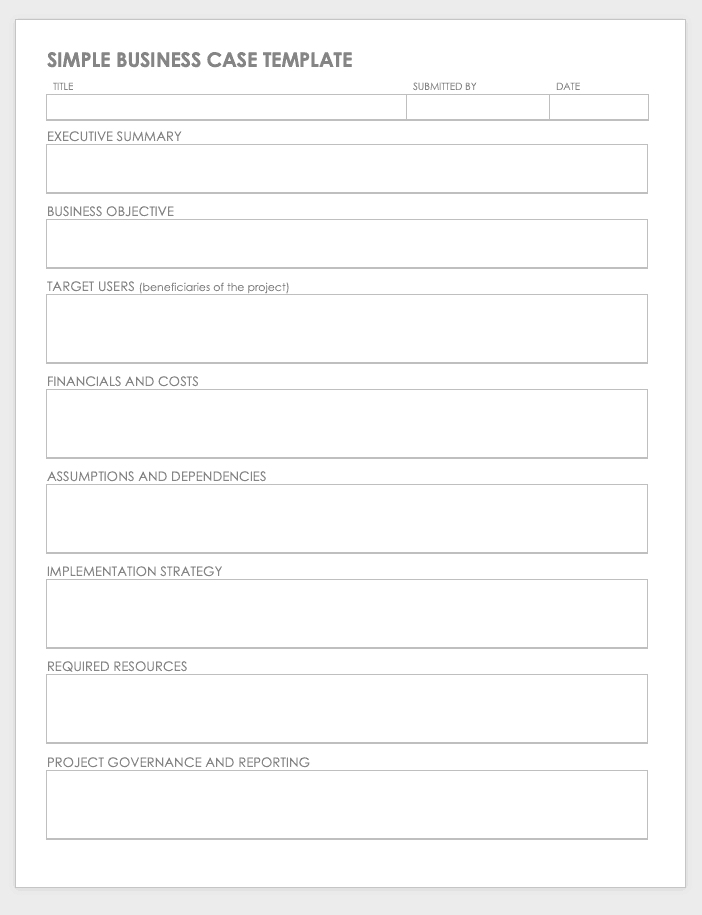
A simple business case template serves a small project or a small organization. It can cover extensive details if necessary. It includes spaces for describing the following elements of the case: the title, the executive summary, the business objective, the target users, the financials and costs, the assumptions and dependencies, the implementation strategy, the required resources, and the project governance and reporting.
Download Simple Business Case Template
Word | PDF | Smartsheet
Healthcare Business Case Template
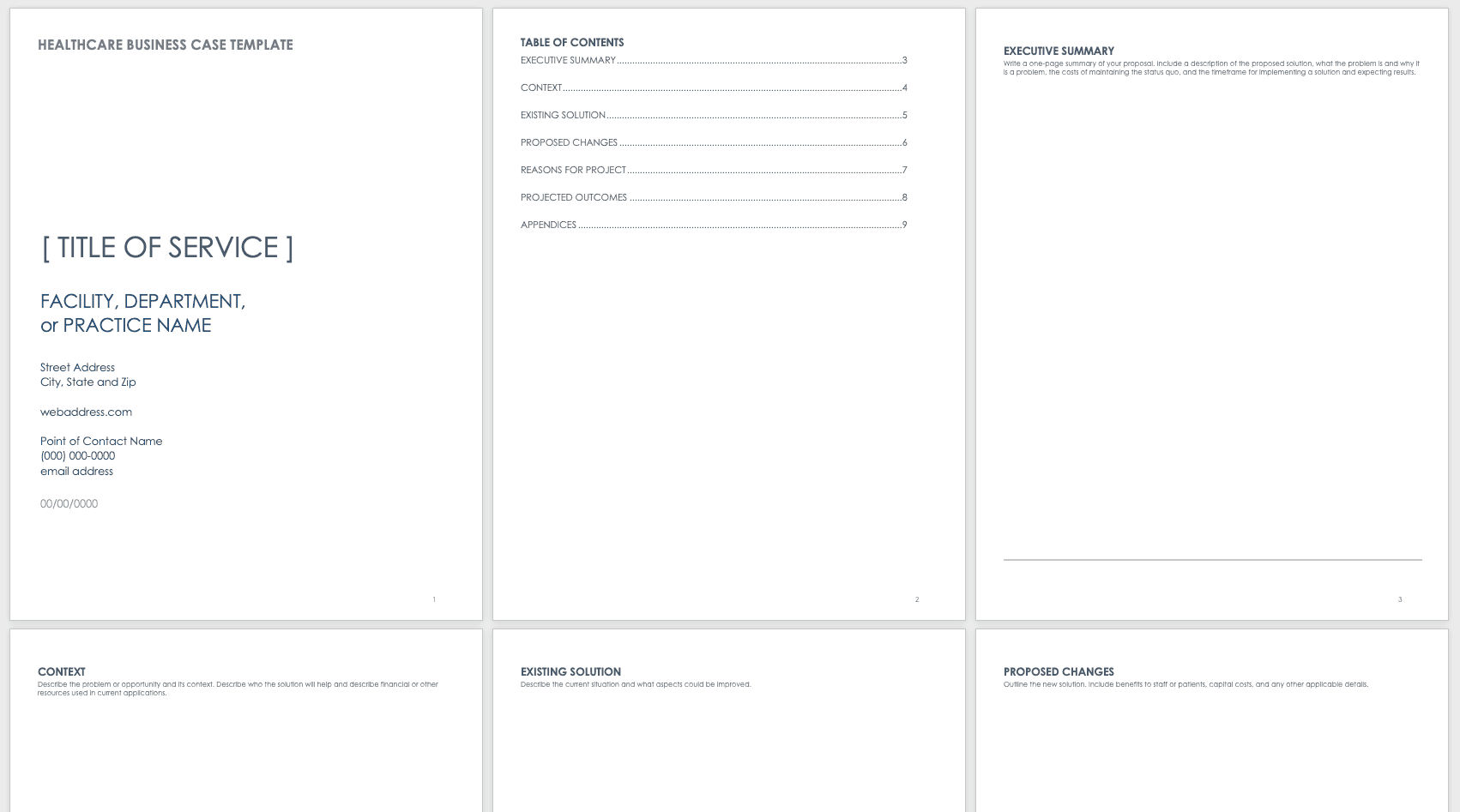
A healthcare business case template helps you explain the current setup and how the proposed solution can create improvements. It provides space for a one-page executive summary, context for the problem or opportunity, a description of the current situation, an explanation of the proposed changes, and details of how the changes can affect your organization and any other entities.
Download Healthcare Business Case Template
Word | Google Docs
New Product Business Case Template
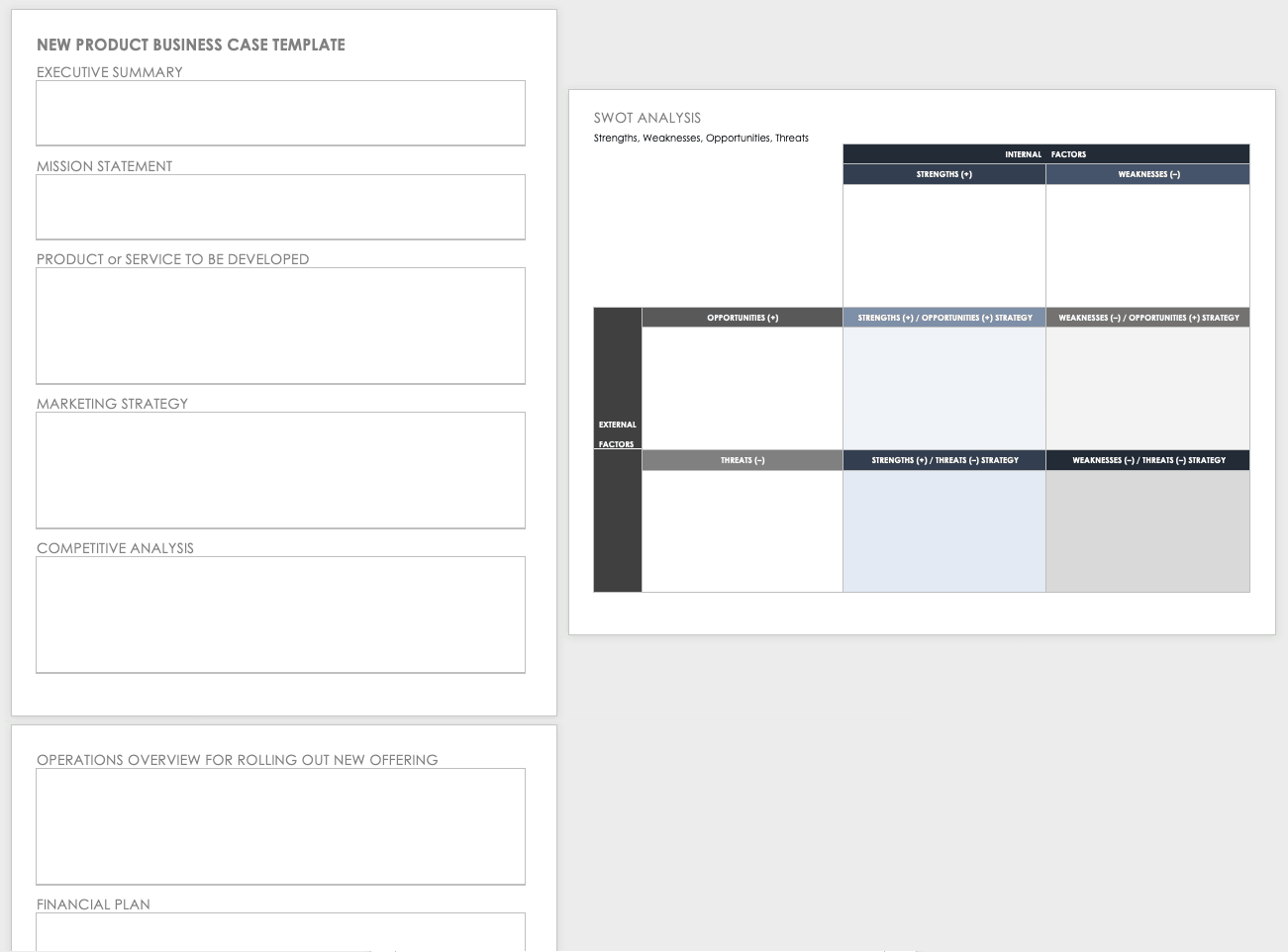
A new product business case template explores the business landscape for a new product or service. In addition to the meta information, such as the title, the author, and the executive summary, the template includes space to describe the current mission statement, the proposed product or service, the marketing strategy, an analysis of competitors, SWOT analysis , an overview of the implementation plan, and financial details.
Download New Product Business Case Template
Preparing to Write the Business Case
You can expedite your business process by understanding business case structure and using a template. In addition, having the correct perspective and following best practices can contribute to your success.
Why Are You Doing the Project?
Before you start researching and writing, understand why you want to initiate a project. The goal of a project is to solve problems. What is a problem? A problem prevents your organization from achieving its full potential. To begin, determine what problem the project is trying to solve.
Projects have deliverables, whether tangible or intangible. Think of an outcome as the result created by the deliverables. Benefits represent quantifiable improvements derived from an outcome. When a customer or team member can leverage these benefits, they become advantages.
Do Your Business Case Research
To start, review the mission statement(s) for the organization or the project. Identify the sources of data for your business case. One way to encourage the acceptance of your proposal is to discuss your rough estimates of the costs and resources with a project sponsor or customer before you embark on the business case. This helps you and the sponsor understand each other’s expectations and lessens the chance of sticker shock during the executive presentation. Then interview the people who conduct the day-to-day work and get their perspective on problems and possible solutions.
Do the Business Case Math
You must consider whether the returns justify the request. “If we're asking for $3 million, we've got to show that the project benefits far exceed that amount,” asserts Maholic. “With returns of $10, $15, or $20 million, you're going to get their attention. If you say the benefits are $300 million, they're going to think you've fallen off the truck somewhere, because that's not realistic. On the other hand, if you show benefits of $3.5 million for a cost of $3 million, that's probably not going to beat the projected return of any other project that comes across their desk.”
Consider Who the Business Case Is For
Whether the business case comes in document form or as a presentation, the project sponsor and key stakeholders will study it. Consider the key audience for each section of your document and write with that audience in mind.
The most convincing arguments for projects are those that your team can initiate and wrap up within six months, as well as produce considerable quantifiable results. Especially when big money is on the table, your proposal will compete with others from different departments. “No company has all the money it wants to invest in everything — it has to prioritize. The business case helps evaluate what the return will be for each of the projects that comes across the board's desk for approval,” explains Maholic.
Furthermore, a business case presents estimates. A business case should be built on sound research, but no one has a lock on certitude. “I think first-time business case writers in particular get caught up in building some great story. But seasoned executives get requests all the time, and they're not buffaloed by clever-sounding words or fancy spreadsheets,” Maholic cautions.
“Your ideas have to be rooted in something sensible, not just, ‘I bet we can raise revenues by 15 percent,’” he explains. Grand plans may be possible, but the key, according to Maholic, is to help decision makers understand how it is possible.
How Do You Write a Business Case?
When you have the main questions in mind and a sense of the required sections and format, you can begin to write. Consider limiting the number of authors to ensure an effective writing effort that’s consistent in style and voice. Then follow these tips:
- Concisely cover the core content with enough detail, so stakeholders can make an informed decision.
- Compare options, so decision makers understand the landscape.
- Be clear, concise, and captivating.
- Avoid jargon as much as possible.
- Demonstrate the value of the project to the business by creating a credible and accurate argument.
- Clearly describe the landscape for the initiative, including its dependencies. Enumerating these dependencies is crucial because contextual changes can alter the project parameters or eliminate the need for the project altogether.
- Focus on the business and the business value rather than the knowledge domain covered by the intended project deliverable.
How Do You Know You Have Enough Detail?
You determine the length of your business cases according to the scope and complexity of your proposed endeavour. A complex project means a long business case; a small, short project means a short business case.
However, Maholic cautions against adding too much detail — conciseness can be a challenge. “You may take 4 to 6 weeks to create a business. You might talk to 50 or 100 people. There's this gnawing urge in some people to show everything they've collected in the executive presentation. Look how hard we worked. Look how smart I am . That's just awful.
“You have enough data and slides when you can answer those 4 or 5 basic questions. There may be 100 other slides, but those are supporting detail,” he says.
Common Mistakes in Writing Business Cases
You can strengthen your business case by avoiding common mistakes:
- Forget What Your White Papers Say: Maholic finds that when salespeople create cases for customers, they frequently rely on the benefits outlined in a product’s white papers. He notes, “Saying your product cuts costs by Y percent is a great place to start, but it has to be balanced by what's in front of you regarding a particular customer.” He continues, “As a salesperson, you may say that your product can increase revenue by 5 percent. That may be true for past customers, but this particular customer may have three straight years of declining revenues. It's silly to say that a product is going to both arrest a decline and bump up revenue by 5 percent. You have to think things through. That’s the analysis part. You can't just mouth off.”
- Spreadsheets Are not the Main Show: "Too often, I think, people hear business case , and they jump right to building a spreadsheet,” Maholic says. “They're eager to build the mother of all spreadsheets and show how smart they are by demonstrating the mother of all spreadsheets. While certainly spreadsheets are necessary to show the math, the spreadsheet is only a small part of the solution. Spreadsheets don't really articulate the problem or indicate who you talked to or what you analyzed to get to that solution,” he adds.
- Arguments Do not Equal More Money: Sometimes, people believe that a strong case justifies a more generous price tag. Not so, says Maholic: “As a decision maker, having a better business case doesn't mean I'm going to roll over and say, ‘Sure, you can charge me an extra million dollars.’ A good business case means the project has the value to go forward. Now, we're going to start negotiating and I'm still going to work to get the best price I can. People who've done business cases before know that. But people who are new to them don't completely understand that.”
- Remember That It’s About Value, Not About Toys: For startups, the coolness factor of the technology or product may carry some weight, but for most organizations, a business case must focus on the business value without getting lost in the domain knowledge and technical details. Maholic explains: “Nobody at the executive level cares what the throughput ratio is of this process or that stack. What they want to know is, ‘Do I get revenue more quickly? Do I cut costs more deeply? Tell me what the value of doing X is, and then you can go off and buy whatever toys you want to in order to do X.’”

Steps to Produce a Business Case
Your organization may have a tribal understanding of the best process for creating a business case. Some employees may advocate for following the Ds , which refer to the steps to produce a business case. The Ds can include as many as six steps, but generally focus on these four:
- Discover your problem or opportunity.
- Design your solutions and alternatives.
- Develop the details that describe the pros and cons of each potential solution.
- Deploy the business case.
Some advocates add the Define step to the beginning of the process and the Deliver step to the end. For best results, create your business case in the following order:
- Determine your problem or opportunity.
- Research the context for your proposal as appropriate: When developing a new product, your research may focus on the market; when acquiring new training or software, you may review current internal processes; and when making a new purchase, you may interview dozens of team members who use current tools and procedures.
- Compare alternative approaches and recommend the most appropriate strategy.
- Gather supporting data and evidence for the recommended approach.
- Write the business case.
- Write the executive summary.
- Edit your business case draft.
- Present your business case to either the final authority or the personnel who will be instrumental in implementing the case plan.
Download Business Case Process Checklist
The Business Case in Project Development
Contrary to what you might imagine, the business case can be a living document. Starting with the review process, stakeholders may reject, cancel, postpone, accept, or adjust the business case. To some extent, the business case becomes the guidebook for your initiative. Stakeholders and the project manager should refer to the business case throughout the lifecycle of the project to ensure that efforts (and intentions) remain on track.
What Are the Features of a Project Business Case?
A well-considered business case offers the following characteristics: an easy-to-understand description of the business value of the initiative and the immediate benefits of the project, including details of the positive impact on organizational strategy.
How Do You Analyze a Business Case?
In university-level business schools, business case studies (or case studies) function as teaching tools to help students use their analytic skills. Case studies describe a company and how it employs a solution. Following is the suggested approach for students analyzing a case:
- Review the case in detail. Identify the key issues.
- Determine 2 to 5 essential problems.
- Look for solutions to those problems.
- Describe your recommended solution.
What Is a Full Business Case?
A business case is a structured, detailed document that presents the justification for the commitment of financial and other resources to an endeavor. Business cases help you gain the support of management and other stakeholders, as well as approval for projects and programs.
What Is a Business Case in Project Management?
An approved business case can have a long life. Although the project sponsor ultimately owns the business case, it is the project manager who uses the business case as the guidebook for expectations and dependencies. In addition, the business case becomes an important document in an organization’s project portfolio management process. During this process, a company balances its resources with its strategic objectives to determine the livelihood of all the projects it undertakes.
History and Origins of Business Cases
The formal business case has its roots in 19th-century Europe, particularly with the work of French-Italian engineer-economist Jules Dupuit. His contribution included statistical tools to identify, measure, and value the benefits beyond merely determining the lowest bidder. Specifically, Dupuit is credited with inventing what he called the benefit-cost analysis . Today, professionals recognize the value of business cases outside of public works and government. Both nonprofit and for-profit organizations regularly use business cases.
Resources and Examples for Creating Your Business Case
If you’re new to business cases, you don’t have to start empty-handed. We offer resources to help you begin writing. Please see the following examples and templates:
- Here’s an example of a business case in a classic document format . This particular business case argues against a capital investment.
- This example presents three business cases for one higher education department . The presentation comes in a slide format.
- In this article, Jim Maholic offers a template for creating your business case .
Improve Your Business Cases with Real-Time Work Management in Smartsheet
Empower your people to go above and beyond with a flexible platform designed to match the needs of your team — and adapt as those needs change.
The Smartsheet platform makes it easy to plan, capture, manage, and report on work from anywhere, helping your team be more effective and get more done. Report on key metrics and get real-time visibility into work as it happens with roll-up reports, dashboards, and automated workflows built to keep your team connected and informed.
When teams have clarity into the work getting done, there’s no telling how much more they can accomplish in the same amount of time. Try Smartsheet for free, today.
Discover why over 90% of Fortune 100 companies trust Smartsheet to get work done.

JCU Online Blog
How to write a business case: tips, resources and examples.

In business, resources are finite, and opportunities come at a cost. In pursuing profit and growth, organisations continually ask themselves several questions: What projects should we invest in? What products or services should we offer? How do we best utilise resources? The answers are not simple, and they need to be supported by research, facts, and figures. To facilitate decision-making, research, facts, and data that support certain decisions are presented as a business case.
Business cases are critical pieces of project documentation that outline a business problem and provide options to solve it. The aim of a business case is to convince decision-makers that a particular course of action will result in the best outcome for an organisation.
Business cases need to be created daily within organizations. They have consequences for the individual presenting it, the department and the business at large. As such, it’s critical to understand how to create and present them effectively. Here, you will discover the different types of business cases, how to write a business case and how to present one. You will also find an example of a business case and resources to help you create your own.
Business case basics
Business cases have characteristics that are similar to other types of organisational documentation. Below is information on what business cases are (and what they are not) and the different types of business cases you can produce.
What is a business case?
Every day, hundreds of different projects take place within organisations around the world. Of these projects, many are business-as-usual (BAU). BAU projects are projects the business carries out as part of their everyday activities. Outside of these, there are also special projects that don’t form part of an organisation’s everyday activities but are still critical. These projects may require a business case to be created.
A business case will help decision-makers understand why a special project needs to be completed and how they should do so.
Why create a business case?
Business cases perform two important functions. Firstly, they help organisations understand project options and what each will cost in terms of time, money and opportunities lost or gained.
Secondly, they show decision-makers that there is rigour behind certain courses of action. For example, a business case might show that two IT systems have been analysed but that a certain provider will fit the business’s requirements better. Business cases show that decisions are based on research and facts, as opposed to one person’s opinion. They can help businesses justify their spending, as well as help to protect project leads if something goes wrong.
How is a business case different from a business plan?
Business cases and business plans both help to convince key decision-makers to proceed with a certain course of action. Yet, there are critical differences between a business case and a business plan:
Business cases and project plans both present details of certain projects. Yet, there are important differences:
What are the different types of business cases?
For any business case, there are numerous stakeholders who want to have their say. These stakeholders come from different departments within a business and have different interests in the project. For example, a representative from the finance team might be most interested in whether the business can afford the project, whereas someone from the management team might be more interested in whether his or her team can deliver the project.
Catering to the differing and sometimes conflicting interests that various stakeholders can have requires a sound business case structure. One model that provides this structure is the Five Cases Model, which stipulates that a business case must be presented from five different perspectives: strategic, economic, commercial, financial and management.
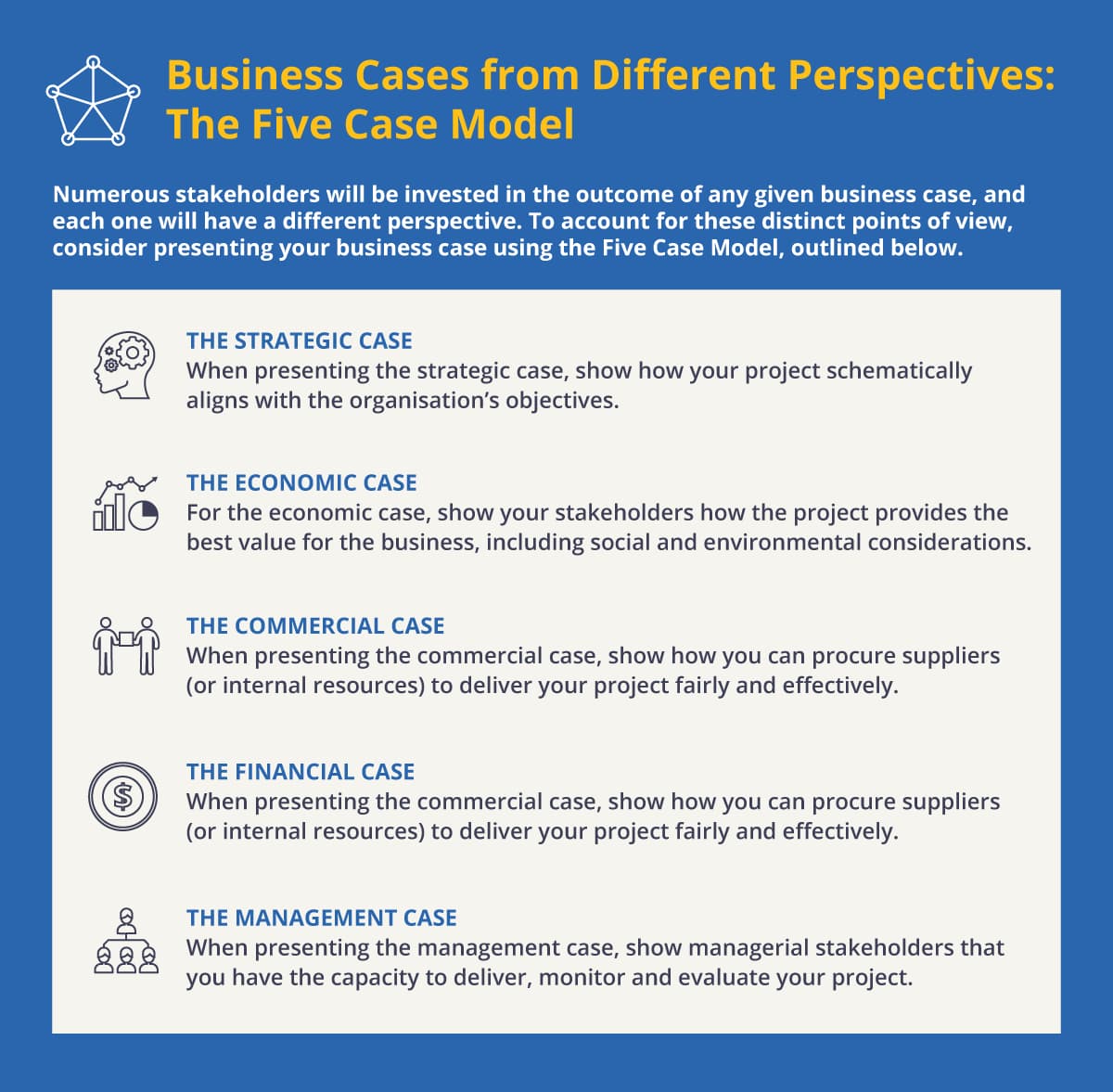
How is a business case different from a project plan?
1. the strategic case.
The aim of the strategic case is to make a case for change and show how it strategically aligns with the direction of the business. To do this, you align your project’s goals and objectives with those of the business.
To present the strongest possible strategic case, outline the business problem to be solved, detail the scope of what you are trying to achieve, and describe the benefits and risks. Explain how a particular process, if successful, would contribute positively to the business overall.
2. The economic case
The aim of the economic case is to identify which of the options you are presenting provides the best value to the business, including broader considerations, such as social and environmental effects. This is important if you are presenting a case for a project that the public will interact with, such as developing a product or building a structure.
To present the best possible economic case, show that you’ve appraised multiple options (i.e. created a long list), ruled out options based on cost and value (i.e. created a shortlist), and then explored, in detail, what each remaining option provides.
3. The commercial case
The commercial case is the next logical step after the economic case. When looking at a project from this perspective, show that you can procure suppliers (or internal resources) and that you can do so fairly and cost-effectively. =
To present the best commercial case, anticipate the resources you need and then factor in any contingencies that might occur within the delivery of the project.
4. The financial case
When thinking from a financial case perspective, show that the business can afford to fund the preferred option you are presenting.
To do so, demonstrate that you have analysed the capital, revenue and whole-of-life costs of your preferred option. Do so in a structured manner, such as by using a profit and loss analysis or other financial ratio analysis.
5. The management case
Lastly, the management case needs to show managerial stakeholders that adequate plans are in place for the delivery, monitoring and evaluation of your preferred option.
To do this, present a plan for how your preferred option will be project managed in accordance with best practices, and also show that independent assurance is available if required. For example, consider contract management and how to ensure benefits are realised and human resources are used fairly and appropriately.
When considering how to write your business case, the Five Cases Model is useful, as it considers the perspectives of different stakeholders. Using the Five Cases Model will ensure you present a balanced business case and support agreement on your preferred option more quickly.
How to write a business case
Business cases are critical documents within organisations and can steer strategic decision-making. As such, it’s important to understand how to write a business case in a structured, professional manner. Here is a list of what should be included in a business case, followed by a detailed description of each.
- Executive summary
- Background information
- Project definition
- Business requirements
- Option presentation and evaluation
- Presentation of preferred option
- Strategic alignment
- Project implementation plan
- Financial analysis
- Resources required
- Authorisations
1. Executive summary
Business cases can become hundred-plus-page documents, so it’s important to begin with an executive summary. The executive summary should include a brief description of the business problem, options presented and the preferred option.
2. Background information
Many people will have a stake in your business case, and many may have little or no context for the project. As such, you need to provide background information on the project. Background information might include why the project needs to take place, similar projects that have taken place, and what has happened in the lead up to preparing the business case.
3. Project definition
In this section, outline all of the critical details of your project. Describe your project and include details on the business problem that it will solve.
4. Business requirements
For any given project, there will be a number of business requirements. For example, did the business have preferred suppliers to work with? Did they have a budget? Did they need a return to be realised within a certain amount of time? Specify these requirements and how your project will meet them.
5. Option presentation and evaluation
The purpose of this section is to show stakeholders that you have researched different options and selected the best one for your business.
Some business cases may require that you conduct research, present a long list of options and then create a shorter list (and a final selection) based on certain criteria. For other business cases, all you will need to do is write a short description of options. What is appropriate will depend on the scale of the project.
Regardless of how you present options, show that you have evaluated them based on the criteria you have been provided. For example, you might look at the price for software, or you might consider price and features. Whatever criteria you are using, make sure you apply it equally to all options to show that you have reached a rational conclusion.
6. Presentation of preferred option
Present your preferred option. Detail why you have selected it and why it best meets the evaluation criteria. Show how it meets business requirements.
7. Strategic alignment
For projects within smaller organisations, it might be obvious how the project aligns with the strategic objectives of a business. For example, a business case for an EFTPOS machine within a restaurant allows customers to pay for their food, so it has a direct correlation with the business’s cash flow. However, for larger organisations, the alignment between a particular project and the company’s objectives may not be so clear.
The strategic alignment section is your chance to demonstrate how your project actively contributes to your company’s broader business and strategy plans.
8. Benefits
The benefits section is crucial in a business case. Outline the clear benefits of your chosen option.
The benefits you outline should be two-fold. Firstly, they should discuss why the project should proceed in general. Secondly, they should outline the benefits of what you are recommending, so as to convince stakeholders it is the right option going forward.
Often, people are concerned that if they present the risks of a project in too much detail, decision-markers won’t decide to move forward with a project. This isn’t true. All projects involve risks, and as part of the due diligence in writing your business case, you need to present them honestly and fairly.
In this section, present the risks, including the likelihood that these risks might eventuate.
10. Project implementation plan
To approve a project, stakeholders want a clear vision of how the project will be implemented. Detail this plan here.
Give stakeholders a brief insight into how the project will proceed, which stakeholders need to be involved, what resources are required and a timeline.
11. Financial analysis
The financial analysis section of your business plan is critical in demonstrating that the project is affordable to the business, that they can fund it, and that it will deliver financial value in the short and long term.
Depending on the scale of your project, a simple analysis may be required, or conversely, you may need to go into detail and present forecasts and other financial reports.
12. Resources required
In this section, include all resources, including physical assets, intellectual resources, human resources and financial resources that your project will need.
13. Authorisations
The authorisations section details who needs to sign off on what and at what stage.
14. Appendices
The appendices house important information that doesn’t belong in the body of your business case, such as more detailed research on the options you’ve presented, further analysis of risks and benefits, or more in-depth financial models or project plans.
Business cases are important business documents and require a detailed structure to ensure they function as they should. Including the sections detailed above will give you the best chance of creating a successful business case.
How to present a business case
Learning how to write a business case is only the first step. The next critical step is presenting it to stakeholders.
6 tips for presenting your business case successfully
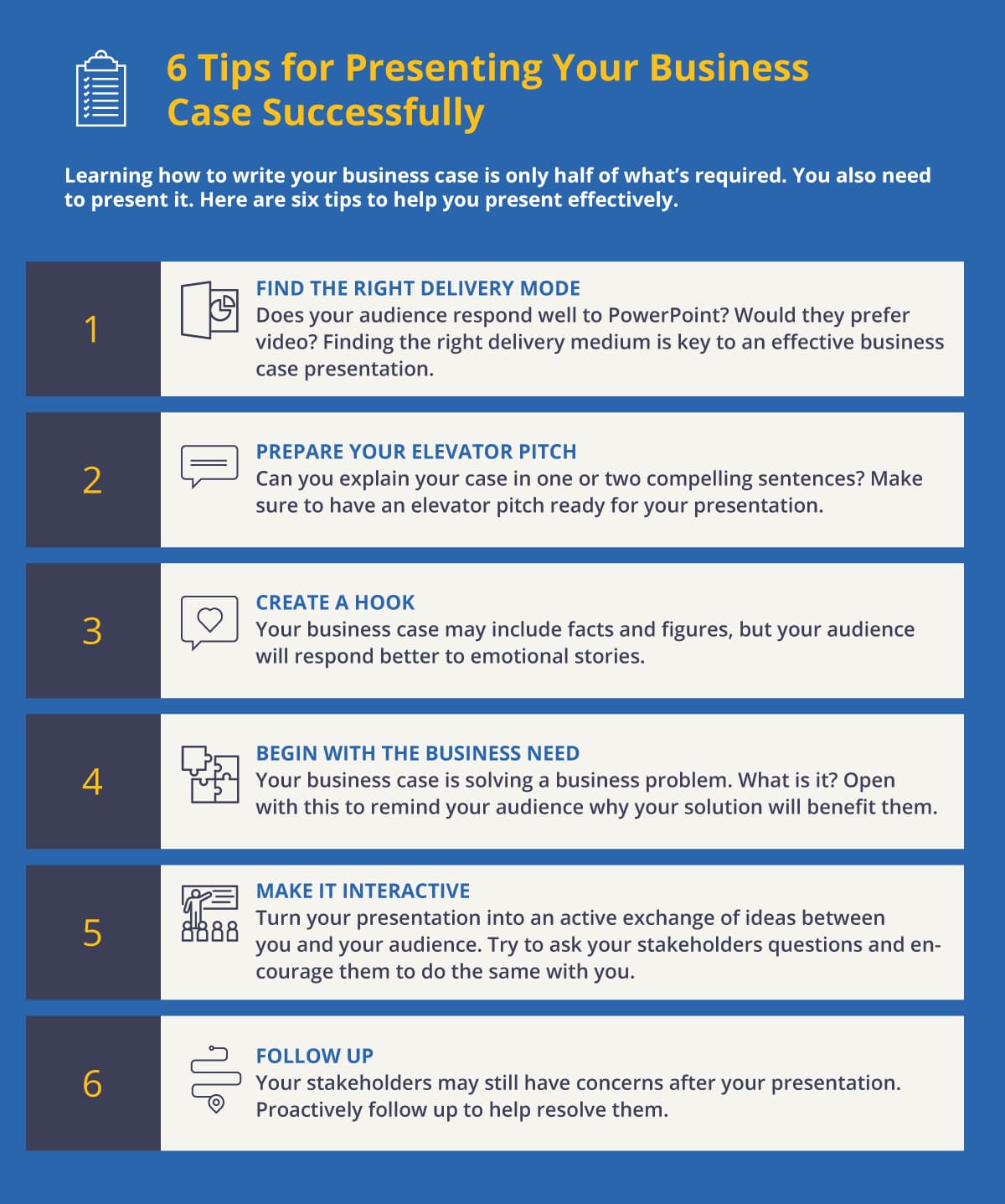
Follow the steps below to successfully present a business case:
1. Find the right delivery mode
Finding the right delivery mode will ensure that your business case is well received by decision-makers. Think about how your decision-makers like to be engaged. Would it make sense to send them the business case file first and then present the highlights to them? Or do you want them to view your presentation with no prior knowledge of your business case? Here, consider what presentation medium you use. For example, would a short video introduction work best? Alternatively, will you use PowerPoint? If you use PowerPoint, how can you do so in a way that’s convincing while providing the right amount of detail? Do you need to practice your presentation before you deliver it? Ensuring that you have all of these elements right is the first step in presenting your business case.
2. Prepare an elevator pitch
Senior stakeholders are time-poor, so it’s critical to have a short, sharp elevator pitch that summarises your business case. This is important, as not everyone has time to read the business case. Ensure you have the basics covered with your elevator pitch so stakeholders can make an informed decision.
3. Create a hook
Your business case will contain many critical facts and figures. To engage your stakeholders, you will need to translate them into an emotional story. The story you create around your business case will differ from your elevator pitch. It will include how the project will benefit people. For example, you might talk about how much easier life will be for employees with a new type of software or all the happy families who will enjoy an apartment block. Creating a connection through emotion will help you make an impact and be memorable when presenting your business case.
4. Begin with the business need
Every business case should address a business problem. To get stakeholder buy-in for your business case, start by reminding them of what this problem is so they will have greater incentive to hear about your solution.
5. Make it interactive
Interactive presentations are more engaging and memorable. As such, view and deliver your business case as a discussion. To do this, regularly ask questions to specific stakeholders, and ensure you proactively answer any questions asked to you. Also, if you make your presentation interactive, you won’t have to rely as much on your slides, which will make you appear more confident.
5. Follow up
Following up after your business case presentation is important, as not everyone may have had time to ask questions or felt comfortable doing so. Follow up individually, if possible, to ensure stakeholders have the opportunity to privately voice their concerns. Understanding how to present a business case is as important as knowing how to write a business case. If you follow the steps described above, you will have a higher chance of success.
Business case resources
When learning how to write a business case, it’s helpful to have best-practice templates to work with. Here are some resources you can use:
Smartsheet
Smartsheet provides numerous business case templates, including one-page business case templates, construction and project management business case templates, and a PowerPoint business case template.
Safety and quality
The Australian Commission on Safety and Quality in Healthcare provides a solid template for healthcare (and general) business cases.
The importance of your business case
Business cases have significant impacts on organisations. They help steer everything from small decisions to those that change the course of organisations forever. Learning how to craft best-practice business cases can set you up to be effective and efficient when you prepare them in the future.
Learning how to write successful business cases is one part of what success looks like as an executive in modern organisations. Broaden your horizons and opportunities with an Online Master of Business Administration from James Cook University. Learn more here .
- Previous post 5 types of psychological research that everyone should know
- Next post How to make an impressive professional nursing portfolio
Find out more about JCU’s online MBA Global .
Get in touch with our Enrolment team on 1300 535 919
Related study options
Jan, Mar, May, Jul, Sep, Oct
24 months part-time
16 months part-time
8 months part-time
Ready to get started?
Download a course guide.
For more detailed and up-to-date information about your degree, including:
- Information about the course
- Course duration
- Course descriptions
- What to expect from the course
Speak with an Enrolment Advisor
Investing in the right course for you is important to us and we’re here to help. Simply request a call back and will assist you with:
- Entry requirements
- Choosing right course
- How to apply and enrol
- How online study works
- Course duration and fees
By submitting this form, you agree that a representative of James Cook University may contact you by email, phone and SMS in relation to your enquiry and to provide you with further information about its programs. You may opt out at any time. For more information on how your personal information will be collected, stored and used, please see our Privacy Statement .
Speak with a advisor
Find out more about:
- Application guide
*All fields required
You must be a Registered Nurse (Division 1) or Registered Midwife with AHPRA to be eligible for this course.
If you’re not currently a Registered Nurse, you may be interested in our on-campus Bachelor of Nursing Science course.

We acknowledge Australian Aboriginal People and Torres Strait Islander People as the first inhabitants of the nation, and acknowledge Traditional Owners of the lands where our staff and students live, learn and work.
- © James Cook University 1995 to 2021
- CRICOS Provider Code 00117J
- ABN 46253211955
- Terms of use
- Right to Information and Privacy
- CRICOS Provider Code: 00117J
people downloaded a course guide in the last 24 hours .
You must have a bachelor’s degree, a postgraduate degree or an equivalent qualification to be eligible for this course.
If you do not have one of these qualifications, you may still be eligible for one of our on-campus psychology courses.

Researched by Consultants from Top-Tier Management Companies

Powerpoint Templates
Icon Bundle
Kpi Dashboard
Professional
Business Plans
Swot Analysis
Gantt Chart
Business Proposal
Marketing Plan
Project Management
Business Case
Business Model
Cyber Security
Business PPT
Digital Marketing
Digital Transformation
Human Resources
Product Management
Artificial Intelligence
Company Profile
Acknowledgement PPT
PPT Presentation
Reports Brochures
One Page Pitch
Interview PPT
All Categories
Top 7 Business Case Presentation Templates With Samples And Examples

Kajal Sharma
Are you struggling to create persuasive and captivating business case presentations that leave a lasting impact on your audience? We understand the challenge you are facing – trying to strike the perfect balance between engaging content and visually appealing design.
A well-crafted presentation can be a game-changer for any business. That's why we've curated the Top 7 Business Case Presentation Templates, with Samples and Examples, exclusively designed to address the issue you're grappling with.
The best part? These templates are 100% editable and content-ready, empowering you to tailor each slide to suit your business needs and target audience. Each template includes high-quality graphics and images, enhancing the overall visual appeal.
In the fast-paced business world, time is of the essence, yet creating a compelling case presentation is critical in garnering support for your projects and ideas. Whether pitching a game-changing proposal to potential investors or seeking buy-in from stakeholders, a well-crafted presentation can make all the difference between both success as well as failure.
So, let's explore these transformative templates that will take your business case presentations to a new level. Get ready to inspire & conquer with your captivating stories – because we've got the tools to help you shine!
We're here to help! Read this blog to master crafting compelling case studies for your success.
Let's have a look!
Template 1: Ways Business Case PPT Portfolio
This PPT Template is crafted with precision and elegance, and serves as the perfect backdrop for any subject. With this visually appealing and professionally designed template, you'll effortlessly command attention and leave a lasting impression on your audience. This template contains consistent formatting and design across all slides for a polished and unified presentation.
It has a responsive design optimized for different devices and screen sizes, ensuring consistent quality across platforms. So, why wait? Elevate your presentation game and showcase your expertise like a pro. Let your ideas shine and mesmerize your audience with our top-tier Smartart CPB templates.
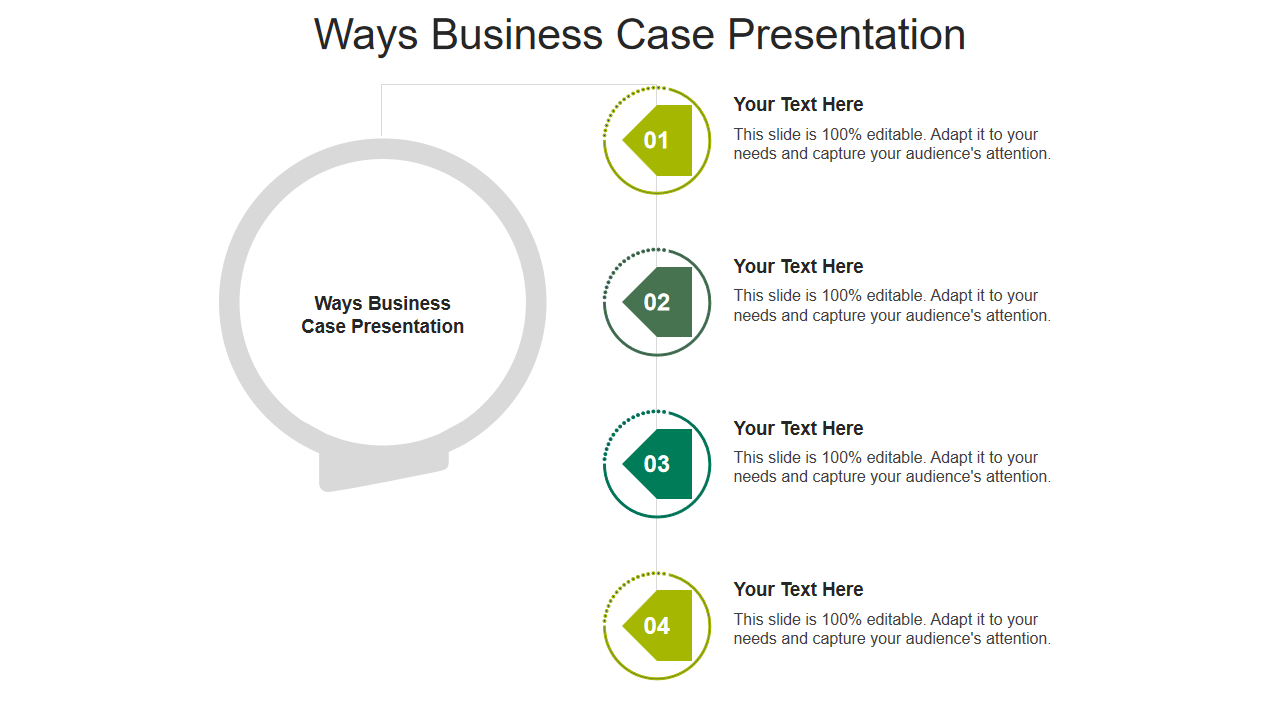
Download This Template Now!
Template 2: Business Case Template For Business Planning
This template is a powerful tool for building your business case and planning your next steps. With a five-stage process, you will be guided through every aspect of building your business case, such as identifying savings opportunities, and ensuring compliance management. With this dynamic and visually stunning presentation, you'll be well-equipped to beat any challenge that comes your way. Elevate your business strategy with this must-have tool.
This ready-to-use template saves you valuable time creating slides from scratch, allowing you to focus on refining your message. So, without further thinking, try our template now and see the difference it can make in captivating your audience and presenting your ideas with style.

Template 3: Business Case Professional Development PPT
This dynamic template showcases a five-stage process that will revolutionize your business strategy. From design and modeling to execution, monitoring, and optimization, this template has it all. It is perfect for business professionals looking to elevate their presentations to the next level. Don't miss out on this transformative tool for success. Download this template and start seeing results from today!
The time for success is now, and it all begins with this transformative tool. So, grab it today and embark on a journey of innovation and success in the world of business strategy. The possibilities are endless, and your path to greatness starts here!
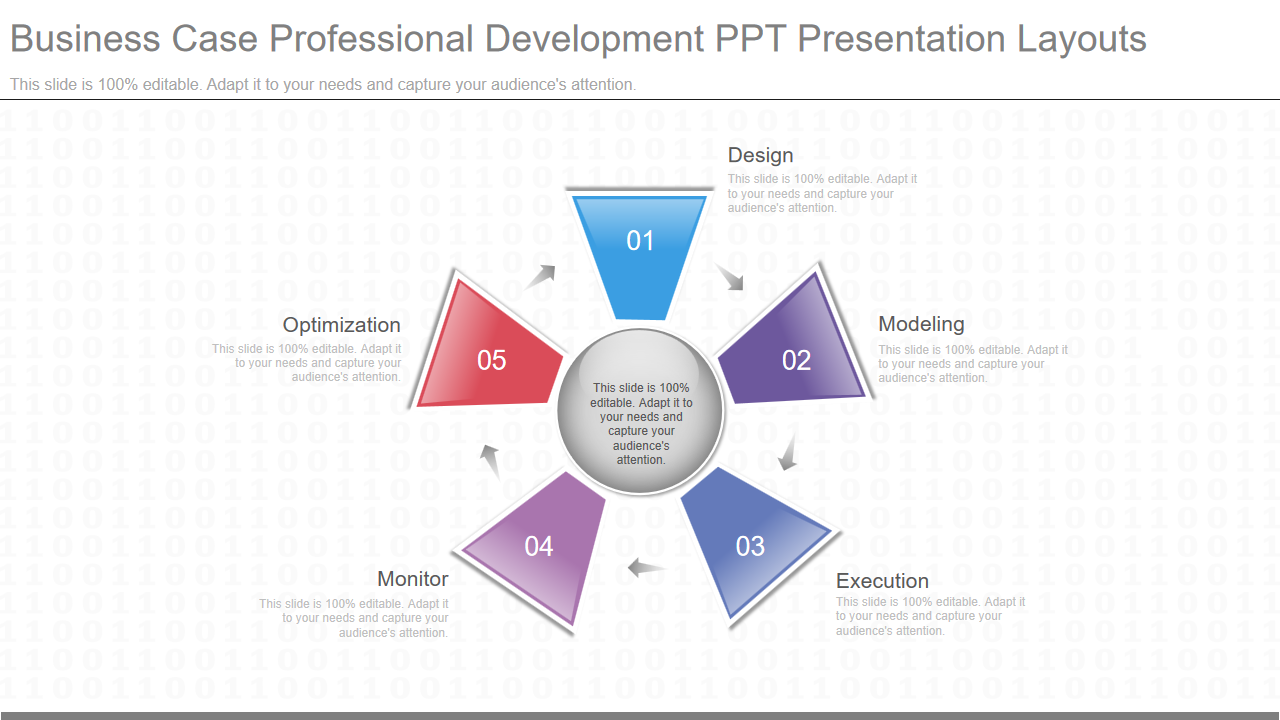
Template 4: Presentation Outline: Business Case Development Services
This visually stunning template is your ultimate guide to creating a compelling business case. With six incredibly informative stages, including quality assurance, initiation phase, current state analysis, future state analysis, business case development, and project management, this presentation outline guarantees success in your next business venture. The template is designed & developed by professionals so that the template exudes a level of polish and professionalism that elevates any project.
This template lets you easily present your Standardized Data and statistics quickly. It allows you to Transform raw data into visually engaging charts, graphs, and infographics that enhance understanding and retention.
So, get ready to impress your stakeholders and pave the way for unprecedented growth and profitability.
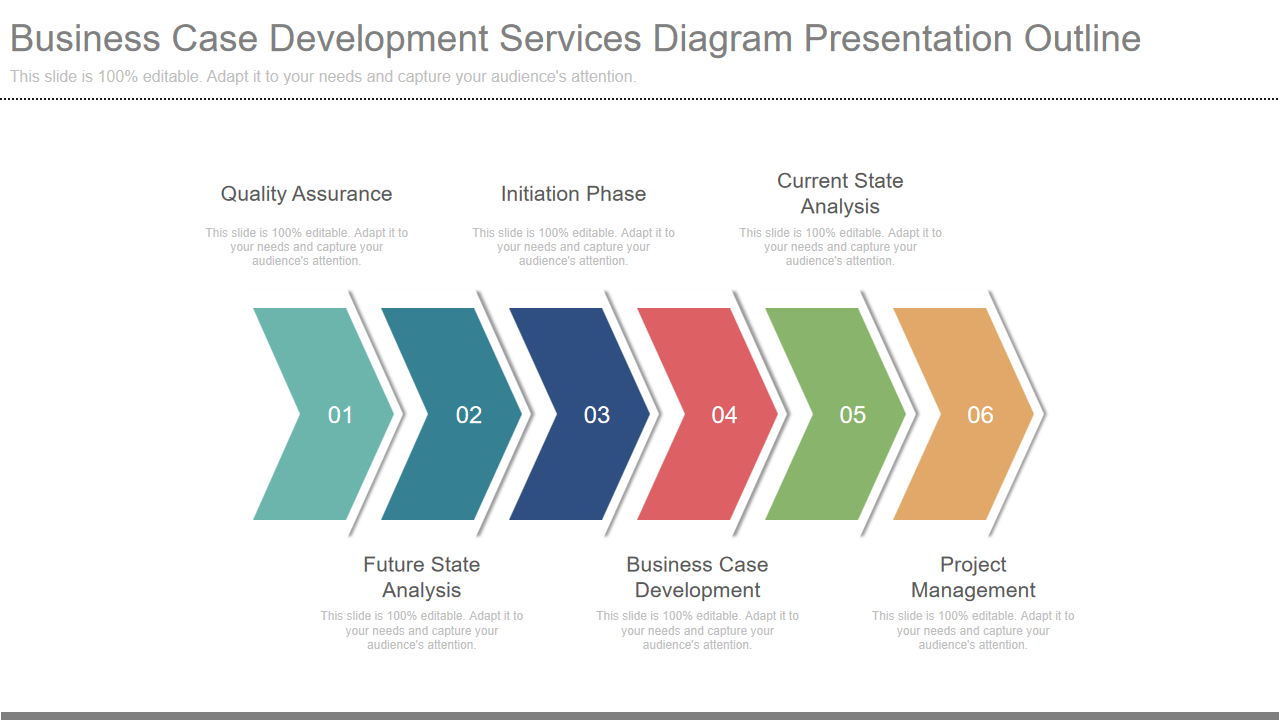
Template 5: Business case Template For Outline Presentation
This template is a one-stage process. The stages in this process include an executive summary, concept overview, market overview, industry position, competition, opportunity potential, and sales and financial forecast. This comprehensive outline will help you to communicate your business case and showcase the potential of your idea or project. Use it to impress your investors and stakeholders and enhance your Business Value with a well-structured and persuasive presentation.
This template boasts visually stunning and captivating designs that captivate your audience from the first slide. With eye-catching graphics, modern layouts, analytical capabilities, and a visually appealing presentation, stand out from the crowd with a download of this PPT Template.

Template 6: Business Case Template For Development Process
This template showcases a seamless four-stage process, expertly guiding you through every critical aspect of creating a compelling business case.
This template contains several fundamental questions:
- What is your business concept?
- What will your business deliver?
- Who will pay for it?
- And why would they pay for it?
With an intuitive and easy-to-navigate interface, the templates simplify the editing process, enabling users of all skill levels to create stunning results.
The time for growth is now, and we are here to make it happen! Grab the template now.
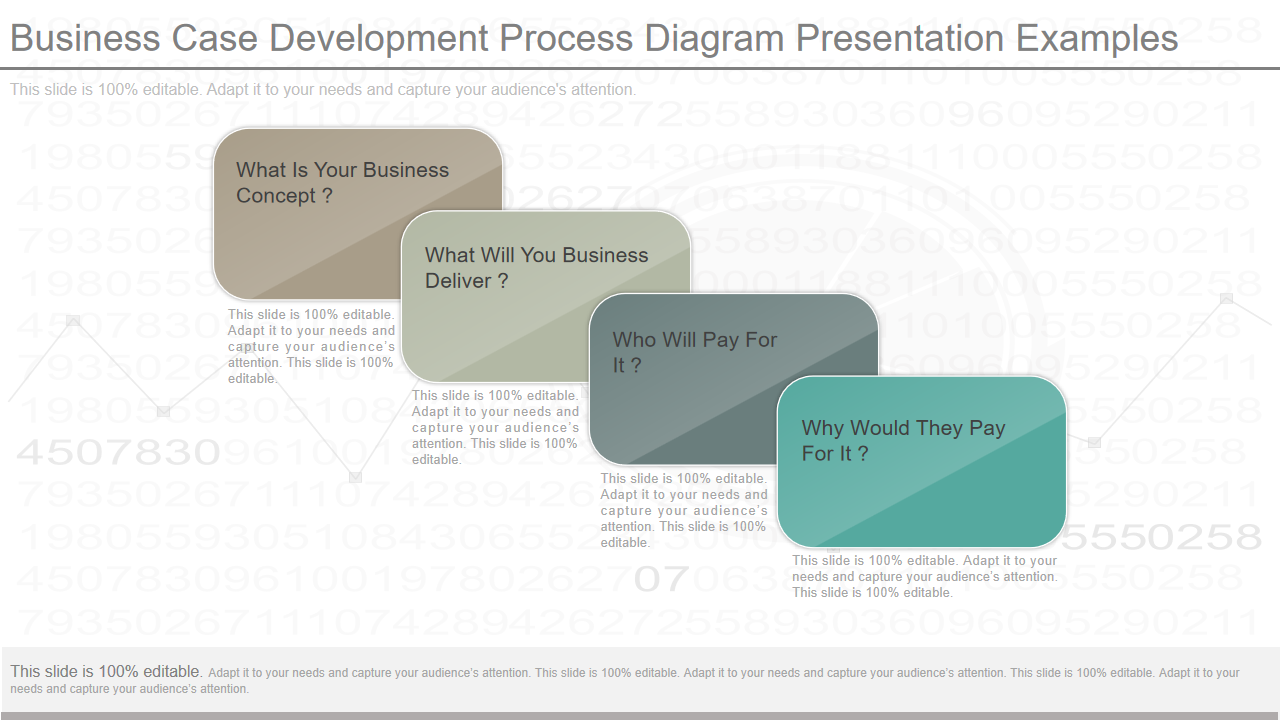
Template 7: Business Case Template For New Product Development
This professionally designed template represents a seamless seven-stage process, guiding you through every critical phase of new product creation. Centered around three key elements - New Product, Development Funnel, and Business Case - this presentation offers an impressive array of options for customization.
Our fantastic design and visually captivating layout will leave your audience in awe from the moment you start presenting. The seamless blend of eye-catching visuals and data-driven insights ensures your message is conveyed with impact and clarity.
The best part? This PowerPoint presentation is available for immediate download so that you can dive into your project without delay.
So, don't miss out on this incredible tool to propel your new product development journey. Download now and watch your ideas come to life!
Grab it now and let your innovation shine!
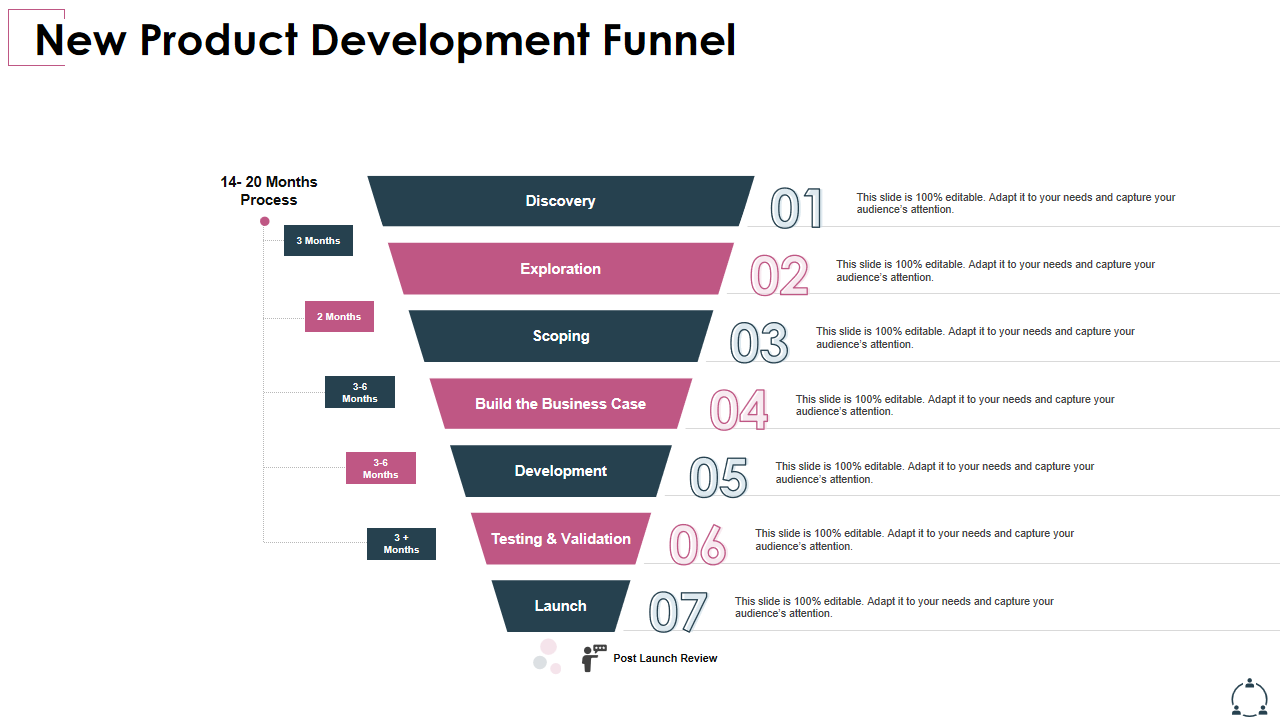
Get The Best Business Case From The Best
SlideTeam collections are meticulously curated to ensure that each template is not just visually stunning but also actionable and adaptable to meet the unique needs of diverse organizations and their specific business challenges. Whether a dynamic startup aiming to make a mark or a well-established corporation seeking to inspire innovation, our templates empower you to present your ideas confidently and with finesse.
No matter whether you need templates for websites, presentations, or documents, our collection covers a diverse range of applications. We are dedicated to ensuring your presentation experience is smooth and successful.
So why go with the ordinary when you can have extraordinary? Elevate your presentations, leave a lasting impression, and unlock the path to success with SlideTeam's unbeatable templates. We provide dedicated customer support to help you with any query or issues you may encounter while using the templates.
The best is here, and it's waiting for you!
Also, investing in these templates is more cost-effective than hiring a designer from scratch.
FAQs on Business Case Presentation
1. what is a typical business case.
A typical business case is a structured document that outlines the justification for a proposed business initiative or project. It is a comprehensive tool to assess the proposed undertaking's viability, benefits, costs, risks, and potential returns. A well-prepared business case provides decision-makers with the necessary information to evaluate the project's feasibility and make informed choices regarding resource allocation and Investment.
2. What are the components of a business case?
A business case typically consists of five components:
- Strategic context: The rationale for change and the reasons behind the proposed project.
- Economic analysis: Expected Return on Investment and assessment of different options.
- Commercial approach: Based on sourcing and procurement strategies.
- Financial case: Ensuring affordability within the organization's timeframe.
- Management approach: Involves roles, governance structure, and life cycle choices.
3. Why is a business case important?
The business case plays a crucial role as it accomplishes the following:
- Justifies the necessity of a project.
- Outlines the potential benefits and feasibility.
- Facilitates informed decision-making and efficient resource allocation.
- Ensures alignment of projects with organizational objectives.
- Enhances the likelihood of achieving successful outcomes.
Related posts:
- Top 25 Small Business Plan Templates in PowerPoint to Streamline Your Operations
- [Updated 2023] Top 25 One Page Business Plan PPT Templates
- Top 20 Business Operation Templates To Define Your Organizational Structure
- Top 25 Business Action Plan Templates to Map Out Winning Company Strategies
Liked this blog? Please recommend us

Top 5 Responsibility Matrix Templates with Samples and Examples

Top 15 Product Development Best Practices Examples with Samples and Templates
This form is protected by reCAPTCHA - the Google Privacy Policy and Terms of Service apply.

Digital revolution powerpoint presentation slides

Sales funnel results presentation layouts
3d men joinning circular jigsaw puzzles ppt graphics icons

Business Strategic Planning Template For Organizations Powerpoint Presentation Slides

Future plan powerpoint template slide

Project Management Team Powerpoint Presentation Slides

Brand marketing powerpoint presentation slides

Launching a new service powerpoint presentation with slides go to market

Agenda powerpoint slide show

Four key metrics donut chart with percentage

Engineering and technology ppt inspiration example introduction continuous process improvement

Meet our team representing in circular format

9 Creative Case Study Presentation Examples & Templates
Learn from proven case study presentation examples and best practices how to get creative, stand out, engage your audience, excite action, and drive results.
9 minute read

helped business professionals at:

Short answer
What makes a good case study presentation?
A good case study presentation has an engaging story, a clear structure, real data, visual aids, client testimonials, and a strong call to action. It informs and inspires, making the audience believe they can achieve similar results.
Dull case studies can cost you clients.
A boring case study presentation doesn't just risk putting your audience to sleep—it can actually stifle your growth, leading to lost sales and overlooked opportunities. When your case study fails to inspire, it's your bottom line that suffers.
Interactive elements are the secret sauce for successful case study presentations.
They not only increase reader engagement by 22% but also lead to a whopping 41% more decks being read fully, proving that the winning deck is not a monologue but a conversation that involves the reader.
Benefits of including interactive elements in your case study presentation
More decks read in full
Longer average reading time
In this post, I’ll help you shape your case studies into compelling narratives that hook your audience, make your successes shine, and drive the results you're aiming for.
Let’s go!
How to create a case study presentation that drives results?
Crafting a case study presentation that truly drives results is about more than just data—it's about storytelling, engagement, and leading your audience down the sales funnel.
Here's how you can do it:
Tell a story: Each case study should follow a narrative arc. Start with the problem, introduce your solution, and showcase the results. Make it compelling and relatable.
Leverage data: Hard numbers build credibility. Use them to highlight your successes and reinforce your points.
Use visuals: Images, infographics, and videos can enhance engagement, making complex information more digestible and memorable.
Add interactive elements: Make your presentation a two-way journey. Tools like tabs and live data calculators can increase time spent on your deck by 22% and the number of full reads by 41% .
Finish with a strong call-to-action: Every good story needs a conclusion. Encourage your audience to take the next step in their buyer journey with a clear, persuasive call-to-action.
Here's a visual representation of what a successful case study presentation should do:

How to write an engaging case study presentation?
Creating an engaging case study presentation involves strategic storytelling, understanding your audience, and sparking action. In this guide, I'll cover the essentials to help you write a compelling narrative that drives results.
What is the best format for a business case study presentation?
4 best format types for a business case study presentation:
- Problem-solution case study
- Before-and-after case study
- Success story case study
- Interview style case study
Each style has unique strengths, so pick one that aligns best with your story and audience. For a deeper dive into these formats, check out our detailed blog post on case study format types .
I also recommend watching this video breaking down the 9-step process for writing a case study:

What to include in a case study presentation?
An effective case study presentation contains 7 key elements:
- Introduction
- Company overview
- The problem/challenge
- Your solution
- Customer quotes/testimonials
To learn more about what should go in each of these sections, check out our post on what is a case study .
How to write a compelling narrative for your case study presentation?
Storytelling is the heart of an engaging case study presentation. It involves more than just stringing events together. You should weave an emotional journey that your audience can relate to.
Begin with the challenge —illustrate the magnitude of the problem that was faced. Then, introduce your solution as the hero that comes to the rescue.
As you progress, ensure your narrative highlights the transformative journey from the problem state to the successful outcome.
Here’s our recommended storyline framework:

How to motivate readers to take action?
Based on BJ Fogg's behavior model , successful motivation involves 3 components:
Motivation is all about highlighting the benefits. Paint a vivid picture of the transformative results achieved using your solution. Use compelling data and emotive testimonials to amplify the desire for similar outcomes, therefore boosting your audience's motivation.
Ability refers to making the desired action easy to perform. Show how straightforward it is to implement your solution. Use clear language, break down complex ideas, and reinforce the message that success is not just possible, but also readily achievable with your offering.
Prompt is your powerful call-to-action (CTA), the spark that nudges your audience to take the next step. Ensure your CTA is clear, direct, and tied into the compelling narrative you've built. It should leave your audience with no doubt about what to do next and why they should do it.
Here’s how you can do it with Storydoc:

How to adapt your presentation for your specific audience?
Every audience is different, and a successful case study presentation speaks directly to its audience's needs, concerns, and desires.
Understanding your audience is crucial. This involves researching their pain points, their industry jargon, their ambitions, and their fears.
Then, tailor your presentation accordingly. Highlight how your solution addresses their specific problems. Use language and examples they're familiar with. Show them how your product or service can help them reach their goals.
A case study presentation that's tailor-made for its audience is not just a presentation—it's a conversation that resonates, engages, and convinces.
How to design a great case study presentation?
A powerful case study presentation is not only about the story you weave—it's about the visual journey you create.
Let's navigate through the design strategies that can transform your case study presentation into a gripping narrative.
Add interactive elements
Static design has long been the traditional route for case study presentations—linear, unchanging, a one-size-fits-all solution.
However, this has been a losing approach for a while now. Static content is killing engagement, but interactive design will bring it back to life.
It invites your audience into an evolving, immersive experience, transforming them from passive onlookers into active participants.
Which of these presentations would you prefer to read?

Use narrated content design (scrollytelling)
Scrollytelling combines the best of scrolling and storytelling. This innovative approach offers an interactive narrated journey controlled with a simple scroll.
It lets you break down complex content into manageable chunks and empowers your audience to control their reading pace.
To make this content experience available to everyone, our founder, Itai Amoza, collaborated with visualization scientist Prof. Steven Franconeri to incorporate scrollytelling into Storydoc.
This collaboration led to specialized storytelling slides that simplify content and enhance engagement (which you can find and use in Storydoc).
Here’s an example of Storydoc scrollytelling:

Bring your case study to life with multimedia
Multimedia brings a dynamic dimension to your presentation. Video testimonials lend authenticity and human connection. Podcast interviews add depth and diversity, while live graphs offer a visually captivating way to represent data.
Each media type contributes to a richer, more immersive narrative that keeps your audience engaged from beginning to end.
Prioritize mobile-friendly design
In an increasingly mobile world, design must adapt. Avoid traditional, non-responsive formats like PPT, PDF, and Word.
Opt for a mobile-optimized design that guarantees your presentation is always at its best, regardless of the device.
As a significant chunk of case studies are opened on mobile, this ensures wider accessibility and improved user experience , demonstrating respect for your audience's viewing preferences.
Here’s what a traditional static presentation looks like as opposed to a responsive deck:

Streamline the design process
Creating a case study presentation usually involves wrestling with a website builder.
It's a dance that often needs several partners - designers to make it look good, developers to make it work smoothly, and plenty of time to bring it all together.
Building, changing, and personalizing your case study can feel like you're climbing a mountain when all you need is to cross a hill.
By switching to Storydoc’s interactive case study creator , you won’t need a tech guru or a design whizz, just your own creativity.
You’ll be able to create a customized, interactive presentation for tailored use in sales prospecting or wherever you need it without the headache of mobilizing your entire team.
Storydoc will automatically adjust any change to your presentation layout, so you can’t break the design even if you tried.

Case study presentation examples that engage readers
Let’s take a deep dive into some standout case studies.
These examples go beyond just sharing information – they're all about captivating and inspiring readers. So, let’s jump in and uncover the secret behind what makes them so effective.
What makes this deck great:
- A video on the cover slide will cause 32% more people to interact with your case study .
- The running numbers slide allows you to present the key results your solution delivered in an easily digestible way.
- The ability to include 2 smart CTAs gives readers the choice between learning more about your solution and booking a meeting with you directly.
Light mode case study
- The ‘read more’ button is perfect if you want to present a longer case without overloading readers with walls of text.
- The timeline slide lets you present your solution in the form of a compelling narrative.
- A combination of text-based and visual slides allows you to add context to the main insights.
Marketing case study
- Tiered slides are perfect for presenting multiple features of your solution, particularly if they’re relevant to several use cases.
- Easily customizable slides allow you to personalize your case study to specific prospects’ needs and pain points.
- The ability to embed videos makes it possible to show your solution in action instead of trying to describe it purely with words.
UX case study
- Various data visualization components let you present hard data in a way that’s easier to understand and follow.
- The option to hide text under a 'Read more' button is great if you want to include research findings or present a longer case study.
- Content segmented using tabs , which is perfect if you want to describe different user research methodologies without overwhelming your audience.
Business case study
- Library of data visualization elements to choose from comes in handy for more data-heavy case studies.
- Ready-to-use graphics and images which can easily be replaced using our AI assistant or your own files.
- Information on the average reading time in the cover reduces bounce rate by 24% .
Modern case study
- Dynamic variables let you personalize your deck at scale in just a few clicks.
- Logo placeholder that can easily be replaced with your prospect's logo for an added personal touch.
- Several text placeholders that can be tweaked to perfection with the help of our AI assistant to truly drive your message home.
Real estate case study
- Plenty of image placeholders that can be easily edited in a couple of clicks to let you show photos of your most important listings.
- Data visualization components can be used to present real estate comps or the value of your listings for a specific time period.
- Interactive slides guide your readers through a captivating storyline, which is key in a highly-visual industry like real estate .
Medical case study
- Image and video placeholders are perfect for presenting your solution without relying on complex medical terminology.
- The ability to hide text under an accordion allows you to include research or clinical trial findings without overwhelming prospects with too much information.
- Clean interactive design stands out in a sea of old-school medical case studies, making your deck more memorable for prospective clients.
Dark mode case study
- The timeline slide is ideal for guiding readers through an attention-grabbing storyline or explaining complex processes.
- Dynamic layout with multiple image and video placeholders that can be replaced in a few clicks to best reflect the nature of your business.
- Testimonial slides that can easily be customized with quotes by your past customers to legitimize your solution in the eyes of prospects.
Grab a case study presentation template
Creating an effective case study presentation is not just about gathering data and organizing it in a document. You need to weave a narrative, create an impact, and most importantly, engage your reader.
So, why start from zero when interactive case study templates can take you halfway up?
Instead of wrestling with words and designs, pick a template that best suits your needs, and watch your data transform into an engaging and inspiring story.

Hi, I'm Dominika, Content Specialist at Storydoc. As a creative professional with experience in fashion, I'm here to show you how to amplify your brand message through the power of storytelling and eye-catching visuals.
Found this post useful?
Subscribe to our monthly newsletter.
Get notified as more awesome content goes live.
(No spam, no ads, opt-out whenever)
You've just joined an elite group of people that make the top performing 1% of sales and marketing collateral.

Create your best pitch deck to date.
Stop losing opportunities to ineffective presentations. Your new amazing deck is one click away!
Connect with us
What you need for a winning business case presentation
Grow a business.
- Flat Design
- Minimalist Design
- Colorful, Bright, and Bold Design
- Infographic-Style Slides in Presentations
- Bold Typography Design

In a business case presentation, you need to create an engaging, concise presentation with all the relevant data needed to win over investors. Here, we will discuss all the relevant factors that make a business… ... read more In a business case presentation, you need to create an engaging, concise presentation with all the relevant data needed to win over investors. Here, we will discuss all the relevant factors that make a business presentation successful, interesting, and worthwhile. close
When planning to meet investors, you will need to develop a business case presentation to persuade stakeholders that your plans are worth supporting. A well-researched and well-thought-out business case presentation should have an argument at its core that it vouches for. You need to present a credible and authoritative argument to create support for an initiative.
What is a business case?
In a project’s early phase, a business case is a document that contains vital information including the risks, benefits, and costs. The purpose of a business case is to bolster decision-makers to take action and provide the funds and resources needed. It is an outline that addresses questions and concerns, evaluates benefits, and outlines challenges to communicating an initiative’s value.
When should you create a business case presentation?
When planning to persuade a stakeholder or sponsor to offer their support, a business case presentation is an appropriate course of action that formalizes the request. Business case presentations are usually used in circumstances when funding is needed, a project’s scope is changed, a new project is being started, or additional team members or resources are requested.
Why is a business case presentation important?
A business case presentation is developed to serve two main functions. They explain projects to their stakeholders and lay out all the details, from the time it will take to the costs and potential losses and gains.
Business case presentations also help investors see the effort behind the initiative. Showcasing the research, facts, and detailed planning assures decision-makers that their contributions are worthwhile and justified.
How is a business case different from a business plan?
Although both business cases and business plans share the same purpose of persuading decision-makers to invest in your project, there are important differences to make note of.
A business case has a narrower focus, concentrating more on a certain problem and its following finances, risks, and benefits. Decision-makers here are the relevant heads of departments or internal stakeholders selecting options based on strategy and priority.
A business plan encompasses a broader reach, offering layouts for new businesses and major changes. It looks into competitors and marketing plans to persuade investors and senior leadership in a business.
What are the different types of business cases?
In any business case presentation preparation, you need to consider that stakeholders will differ according to departments and interests. These differences will need to be accommodated and catered to to ensure that the structure adequately addresses the stakeholder’s interests.
01 The Strategic Business Case
In a strategic business case, the case is for a change in a business and how it ought to align with its overall goals and direction. A strong, strategic business case needs to outline the solution to a problem and the overall scope of what the project is meant to achieve.
02 The Economic Business Case
An economic business case presents the best economic case by evaluating options based on their cost and the value they provide. The options showcased take into account broader factors, like social and environmental effects, especially if the project affects the public, such as a product or building.
03 The Commercial Business Case
The commercial case takes the economic case a step further by looking at suppliers and acquiring resources more cost-effectively. A commercial case anticipates what is needed for a project and the obstacles that might occur throughout obtaining them.
04 The Financial Business Case
This presentation type focuses on what a business can afford to fund by demonstrating an analysis of the capital and revenue for the preferred option. A financial business case needs to be presented in a structured manner that represents the analysis.
05 The Management Business Case
A management business case demonstrates the plans in place for the delivery, monitoring, and evaluation of your project to managerial stakeholders. Present the plans for how a project will be managed and the practices it is set to follow.
What you need to create a business case PowerPoint presentation
When preparing a business case presentation, you need to collect all the facts, figures, details, and research to build a solid case. You need to cover all the points of concern for the stakeholders, including the context, problem, analysis, solution, and execution.
It’s important to note that the different business case presentations we discussed earlier would address different points and have different requirements. Use a business case presentation template as a guide or a checklist to reference throughout.
Establish context
When preparing your presentation, you need to consider that not all members of the audience will have previously read your proposal or are aware of your circumstance. Begin by presenting an executive summary that gives context to your initiative.
An executive summary would offer a brief but comprehensive overview of your business case. Since business cases can easily become over a hundred pages, it’s important to have a summary that highlights the problem being addressed and the solutions available.
State the problem
A problem statement puts the spotlight on the goals and purpose of your business case. It’s time to showcase your understanding of a problem and the plans you have to address it. When describing a problem, make sure to disclose the internal and external effects it has. Why is your solution important? How does it approach the problem?
Business requirements
In any project, there will be business requirements needed to aid throughout. Whether it’s a certain budget, preferred suppliers, or a specific timeline, you need to establish your project’s needs. Since these factors could affect the overall success or quality of a project, determine what they are and explain how they would help carry out the project.
Analyze finances
There is no doubt that the main thing on your investor’s mind is the numbers involved in your business case. Present your current financial details in comparison to the projected numbers if your project gets the support it needs.
Describe the solution
The solution you propose is a direct response to the problem you address. Here, you broach the answers your business case offers. How you describe your solution relates to the decision you’re aiming for.
A solution could be a material difference to your resources such as a new office or fixing a product issue. So in the presentation, outline all the questions relating to your solution, the what, who, when, and how of the answers you’re proposing.
Detail the execution strategy
To support an initiative, stakeholders want to be in on the overall vision and know all the goings-on and plans. Detail your execution strategy describing the plans, process, risks, metrics, and KPIs involved to produce the best results possible. Share any issues you initially faced and how you handled them to convey your credibility.
Share your results
This section is necessary to elaborate on the positive impact your solution will have on a project. This is the space to discuss projected or available financial and growth results and other palpable improvements. This section would also benefit from visual aids such as graphs and charts.
9 Tips for presenting your business case
Now that you’ve gathered all the data you need for your business case, there are things you need to keep in mind as you lay out all this information. Developing a business case is about how you present it as much as it is about what you present.
01 Determine your goals
The first step in designing a business case presentation is outlining the goals you want your presentation to achieve. What is the main purpose? What do you want stakeholders to get out of it? Consider aligning the business case’s objectives with its solutions. For example, use the relevant pain points to address the intended outcomes of your presentation.
02 Decide on the right delivery mode
We often advise that when preparing for a presentation, you should aim to tailor it for your audience to make it more engaging, and a business case presentation is no different. Consider the mediums or features that would best capture your audience’s attention. What are the main points you want to highlight? Would a video do? Would your audience prepare beforehand, or do you need to address every detail yourself? These are all questions you need to ask yourself when developing your presentation.
03 Have an elevator pitch ready
Sometimes, the stakeholders you want to present to are busy and distracted, so you have an elevator pitch ready. Prepare a quick pitch that grabs their attention with all the basics covered.
04 Focus on the essential information
In the same vein as having an elevator pitch ready, be selective with the information you present . There is no need to share the entire business plan. Focus on the essential information that serves your overall case and emphasize it.
05 Be memorable
Structure your business case’s data into a compelling story. This is more elaborate than an elevator pitch. Find the narrative that your facts and figures are telling you and highlight it. Using customer feedback, for example, alongside market research, gives the presentation a more personal edge, making it more engaging.
06 Begin with the business need
A business case should address a business problem. To convince a stakeholder or investor, invoke the problem to refocus the audience on your solution.
07 Make it interactive
Make your presentation interesting and brief. Use your time to focus on slides that serve your overall objectives and create a dialogue with the audience. The more involved the audience is, the more invested they will be in your argument and business case.
08 Rehearse your presentation
Practice, practice, practice. Once you’ve created your presentation, begin rehearsing what you want to say. Make note of all the ideas you need to mention and create an outline you want to follow. That way, when the day comes to present, you can cover all the key points you want to address without straying or losing the plot.
09 Follow up
Not everyone will get the chance to ask you questions after you present, so follow up individually to make sure investors can have the opportunity to voice their concerns to you personally and privately.
Putting together a business case presentation requires both data and creativity. You need all the hard facts to support your initiative and a creative mindset that helps you share them. Investors are interested in what you bring to the table, so make it worth their time.
Recommended for you..

16 January 2024
Web Design Trends 2024: Elevating web experiences

08 February 2024
The world of interactive presentations

18 February 2024
Data Storytelling: A guide for effective data narratives
404 Not found
20+ Best Case Study PowerPoint Templates for In-Depth Analysis
In today’s dynamic professional environment, presenting in-depth case studies becomes critical for businesses and individuals alike. This compilation features over 20 of the best PowerPoint templates specifically designed for presenting comprehensive and engaging case studies. Whether you aim to detail the analysis and strategies behind a business decision, or delve into a person’s journey, these assets can streamline your process and elevate your presentation.
Each template is carefully curated, equipped with slides that cater to an array of elements necessary for a persuasive case study – presenting research, displaying data, sharing interviews, and more. With these templates at your disposal, you can easily translate raw information into an insightful and visually appealing narrative.
Available in both free and paid options, these PowerPoint templates encompass a diverse set of designs and formats. Be it a start-up pitch or an academic research presentation, this post brings forward a wide variety of quality tools for crafting impactful case studies.
One Subscription: Everything You Need for Your PowerPoint Presentation
Get everything you need to give the perfect presentation. From just $16, get unlimited access to thousands of PowerPoint presentation templates, graphics, fonts, and photos.
Build Your PowerPoint Presentation

Ciri PPT Template

Bolo PPT Template
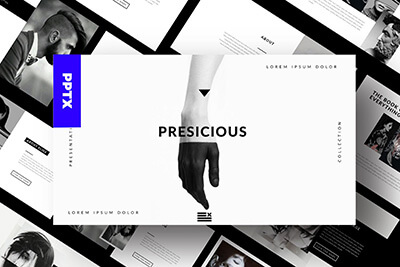
Agency Portfolio PPT

Clean Business PPT
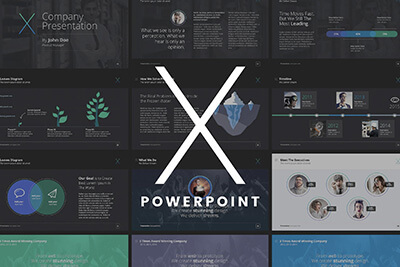
The X Note Template

Analysiz Powerpoint
Blue case study powerpoint template.

The Blue Case Study PowerPoint Template offers a sleek and modern design, perfect for various presentations. Designed meticulously, this 18-slide multipurpose template allows users to easily edit graphics and texts. It’s user-friendly, simply drag and drop pictures into placeholders. The template, ideal for seminars, webinars, business presentations, arrives with a documentation file and free support. Recommended free web fonts included. Note, preview images aren’t included within download files.
Black & Yellow Study PowerPoint Template
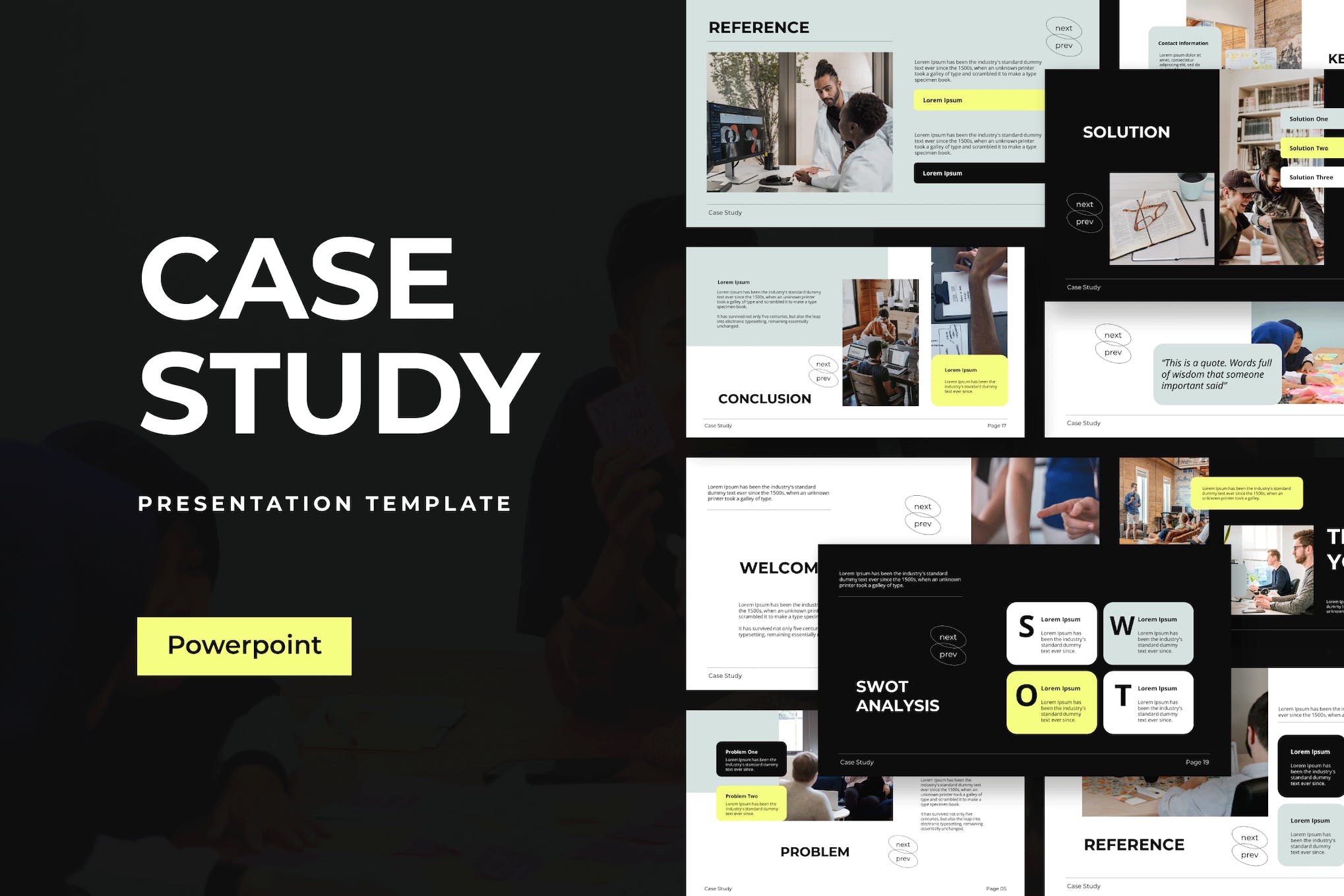
The Black & Yellow Study PowerPoint Template is a sleek, easy-to-use resource perfect for presenting information in an engaging way. With 35 customizable slides, charts and graphs for data representation, and drop-and-drag image placeholders, it balances professional design with practical features. Ideal for students, workers, or any professional who needs to visually communicate information, this template enhances any presentation. Note: preview photos are not included.
Vibrant Case Study PPT Template
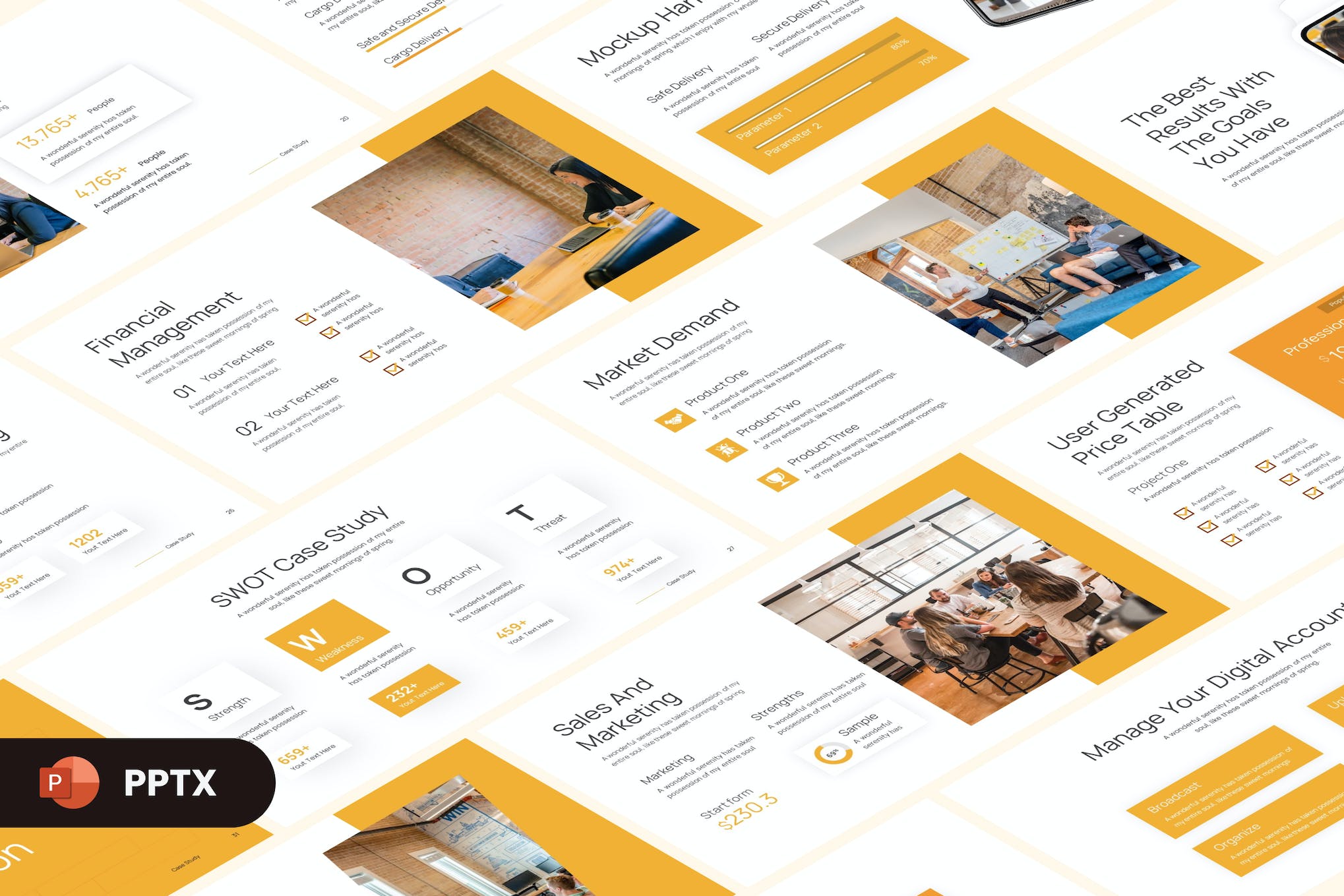
Introducing the Vibrant Case Study PPT Template: a modern, versatile tool perfect for enhancing business presentations, project pitches and lookbook slides. Features include a 16:9 widescreen format, resizable and editable graphics, and a convenient drag & drop picture placeholder. The package comes with PowerPoint and XML files, as well as a helpful guidance file. Please note, images are not included.
Stylish Case Study PowerPoint Template
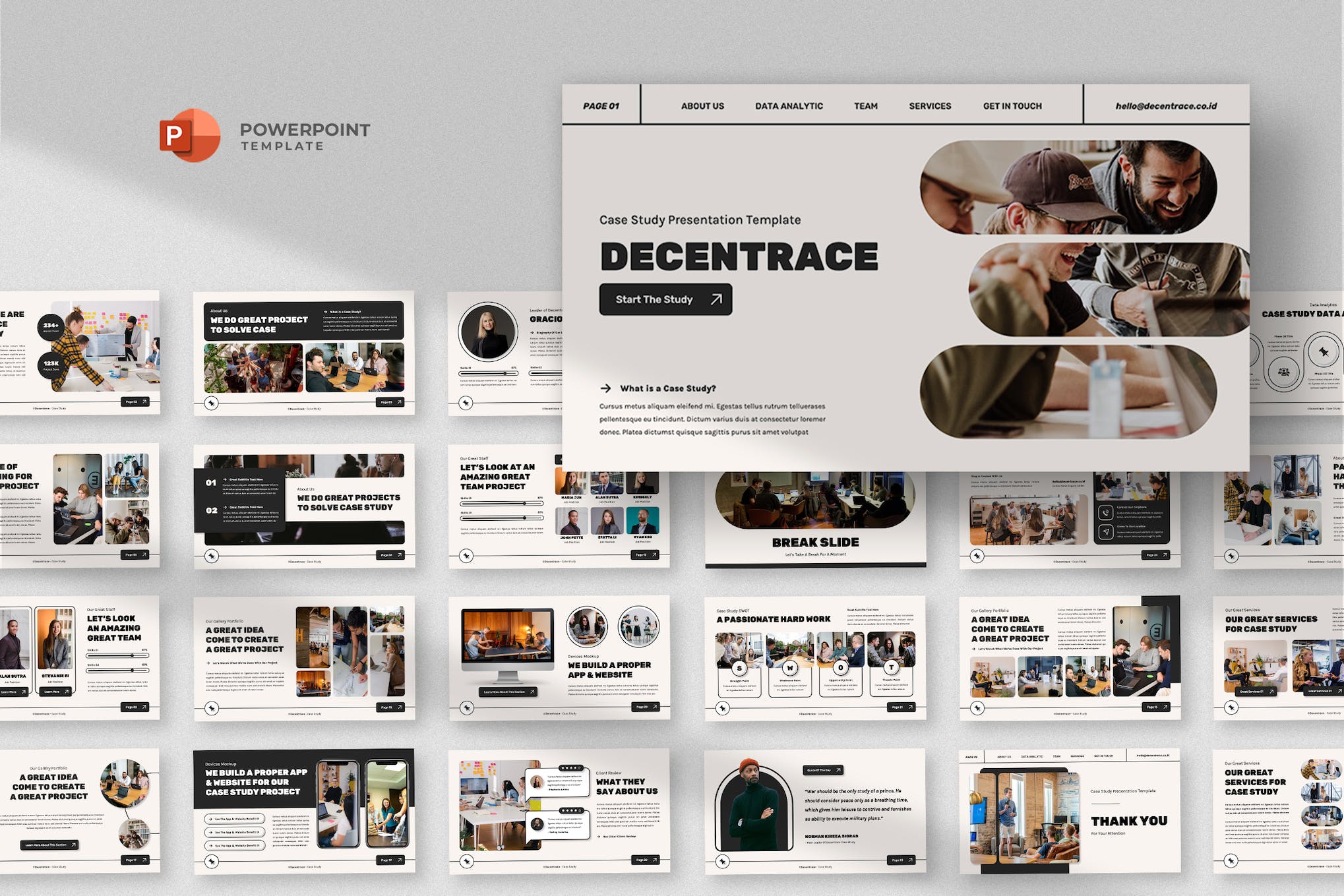
The Stylish Case Study PowerPoint Template by Decentrace is a clean, contemporary, and professional-grade deck design perfect for various business endeavours. Whether it’s a case study proposal, a sales report, or a startup pitch, this template, boasting of 25 total slides, resizable graphics, and free fonts, is an excellent tool. It comes with a handy help file and allows for easy image placement. However, images shown are just previews and not included in the file.
Case Study PowerPoint Template

The Case Study PowerPoint Template by RRGraph Design is an all-inclusive tool for enhancing your business presentations. With 30 unique slides, 90+ customizable XML files, and options for light and dark backgrounds, it transforms every stage of your business development into engaging visual stories. Handmade infographics give an authentic touch to your brand’s narrative. Please note, image stocks are not included.
Case Study Presentation Template
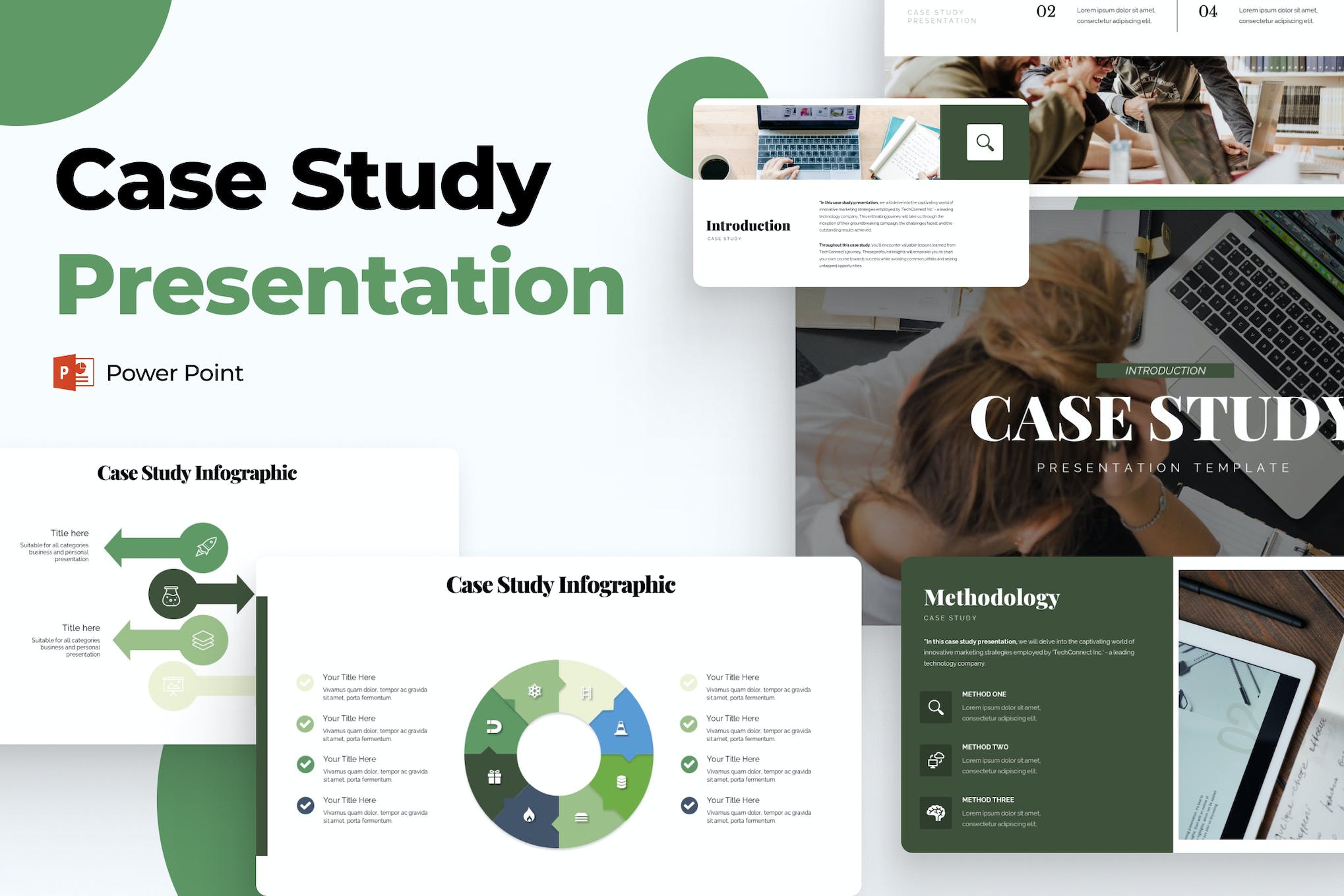
The Case Study Presentation Template is a professional PowerPoint template designed to enhance the quality of your next presentation. It comes with a helpful ‘Read Me’ text file and includes 30 easily customizable slides in seven different color themes. Despite the absence of images, its organization into named groups and ability to change size, recolor, and more make it a highly versatile asset.
Buminas Case Study PowerPoint Template
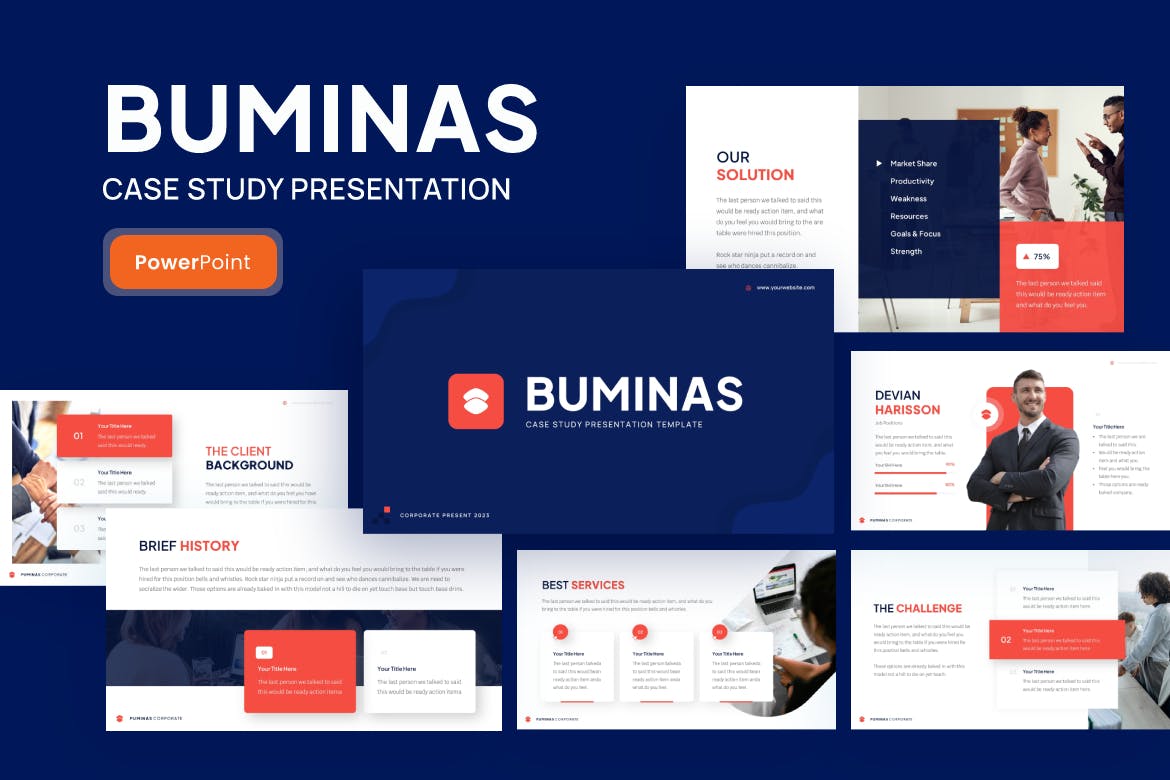
The Buminas Case Study PowerPoint Template is a clear, versatile tool that can be used for a wide range of business presentations including finance, marketing, management, and many more. Its features include 30 unique, easily editable slides, free web fonts, and widescreen ratio. Keep in mind, demo images are for preview purposes only and are not included in the files.
Fun Case Study Presentation Template

The Fun Case Study Presentation Template is a unique yet professional choice for those needing a clean, creative and straightforward template. It features more than 20 unique slides, theme color options, resizable graphics and drag and drop photo replacement. The full HD 16:9 ratio and the minimal design make your presentation visually appealing. Easy to customize in Microsoft PowerPoint to match your personal or company brand.
Purple Case Study PowerPoint Template
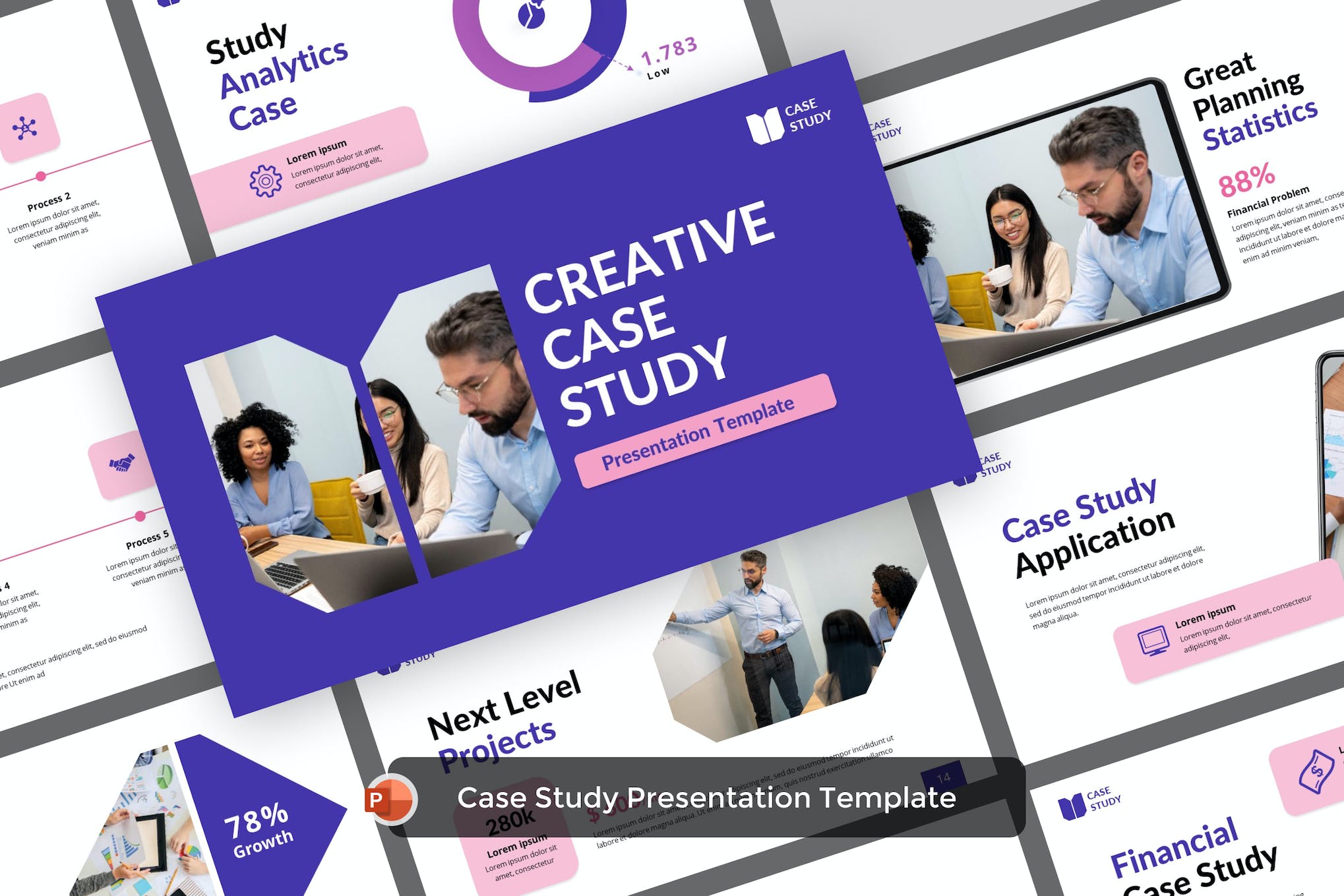
The Purple Case Study PowerPoint Template offers a professional style that is easy to fully customize according to your preferences. Offered in both a dark version and a light version, this template is editable in PowerPoint format files, allowing you to alter images, colours, and text. It also features unique font themes, a color scheme, image placeholders, and free font use. Please note, preview and image stocks are not included.
Case Study Finance PowerPoint Template
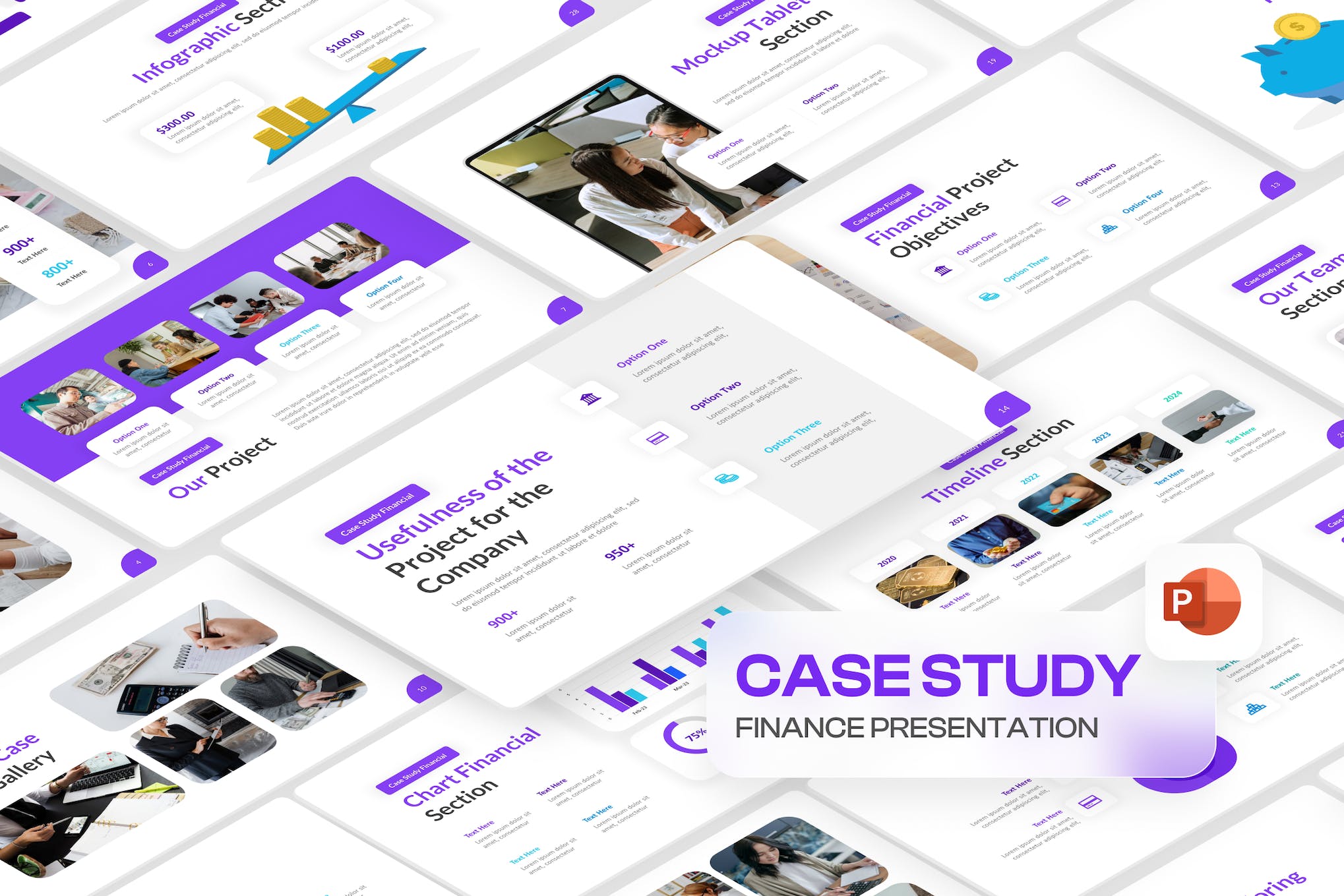
The Case Study Finance PowerPoint Template offers a sleek and professional look for various presentations. It’s great for financial reports, business meetings, project pitches, and other uses. With 30 unique slides, a light background, and all graphics being resizable and editable, this versatile tool makes it easy to customize your presentation. The package also includes XML files, an icon pack, and a help file. Note: Image stocks are not included.
Study Case PowerPoint Template
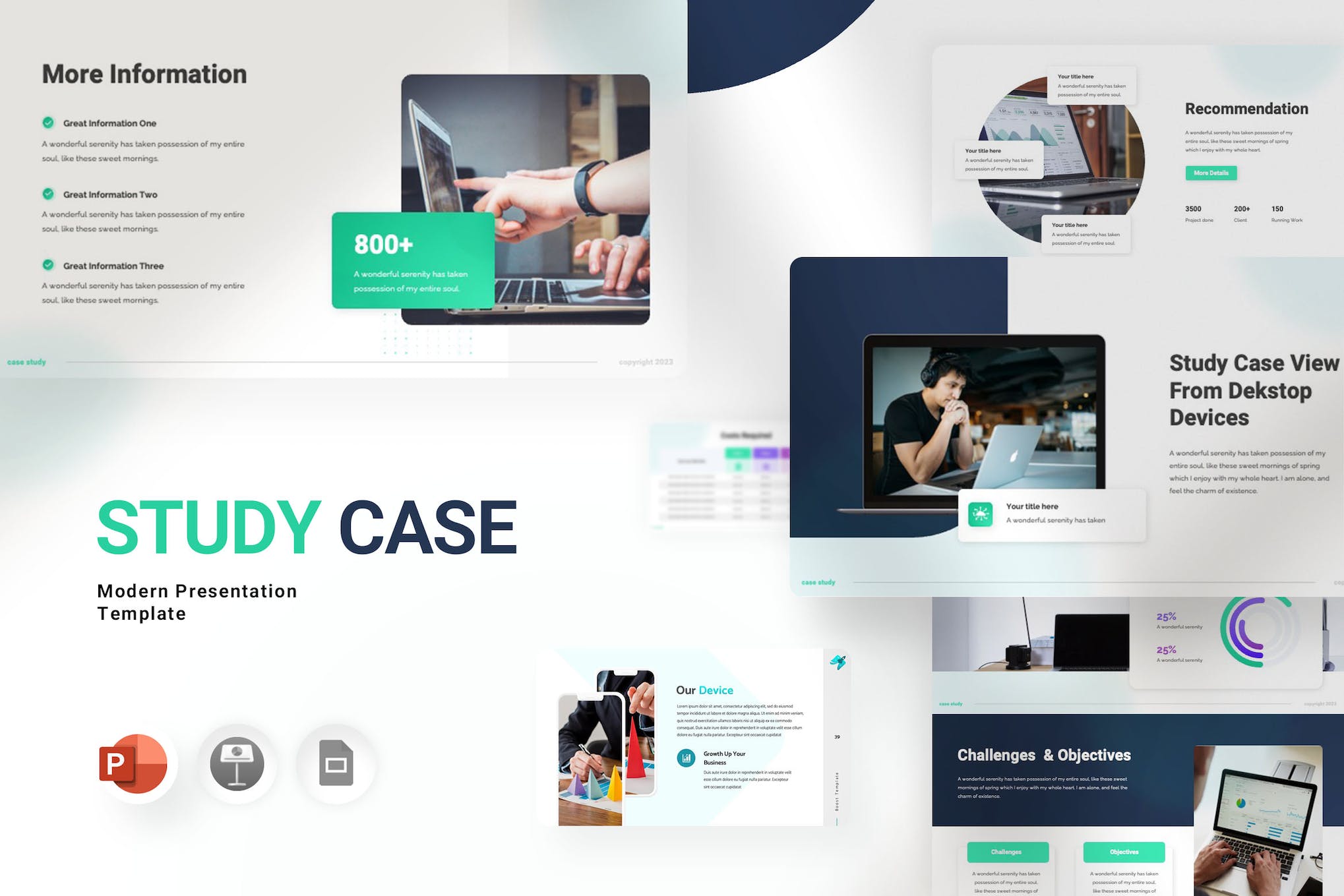
The Study Case PowerPoint Template is a flexible and creative asset perfect for both corporate and personal presentations. Boasting a clean, elegant design with 60 total slides – split evenly between light and dark versions – all in a widescreen 16:9 ratio. This user-friendly template, including master slide layouts and a free font, can enhance your presentations, potentially attracting more customers. Note: Images used in preview not included.
Case Study PowerPoint Presentation

The Case Study PowerPoint Presentation is a versatile and interactive creative template that is easily customizable. Crafted for a wide range of uses, from academic presentations to innovative team projects, you can personalize elements like text, images, and colors. Offering over 125 slides, 5 predefined color variations, animations, infographic icons, and an easy drag-and-drop picture replacement, it’s compatible with all versions of PowerPoint. Please note, original template images are not included.
Cestudy Case Study PowerPoint Template
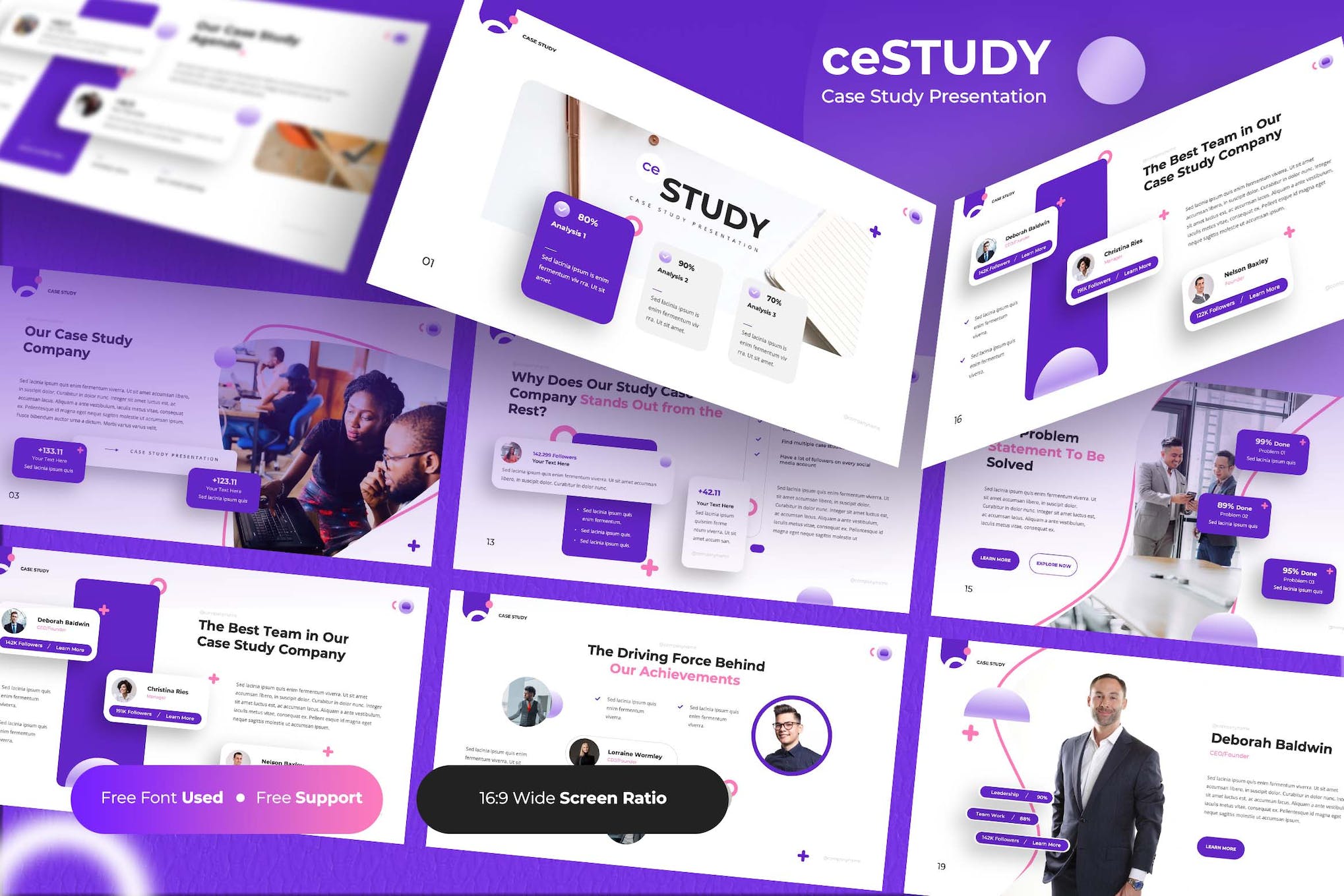
The CeStudy Case Study PowerPoint Template is a resourceful tool designed to amplify your company’s presentations. It comes with 26 distinctive slides, features such as resizable and editable graphics, easy-to-edit colors, and a wide screen ratio. Supported by free, prompt customer service, this template also provides provisions for drag and drop images, enhancing the beauty and creativity of your content.
Acropolis Case Study PowerPoint Template

The Acropolis Case Study PowerPoint Template, provided by RRGraph Design, is an extensive asset for your presentations. With 45 unique slides, over 90 custom theme colors, and options for light or dark backgrounds, this template is fully customizable. It also includes handmade infographics to enhance your storytelling. Designed to accompany your business development stages, it’s a great tool for project presentations and brand recognition.
Casevoke Case Study PowerPoint Template
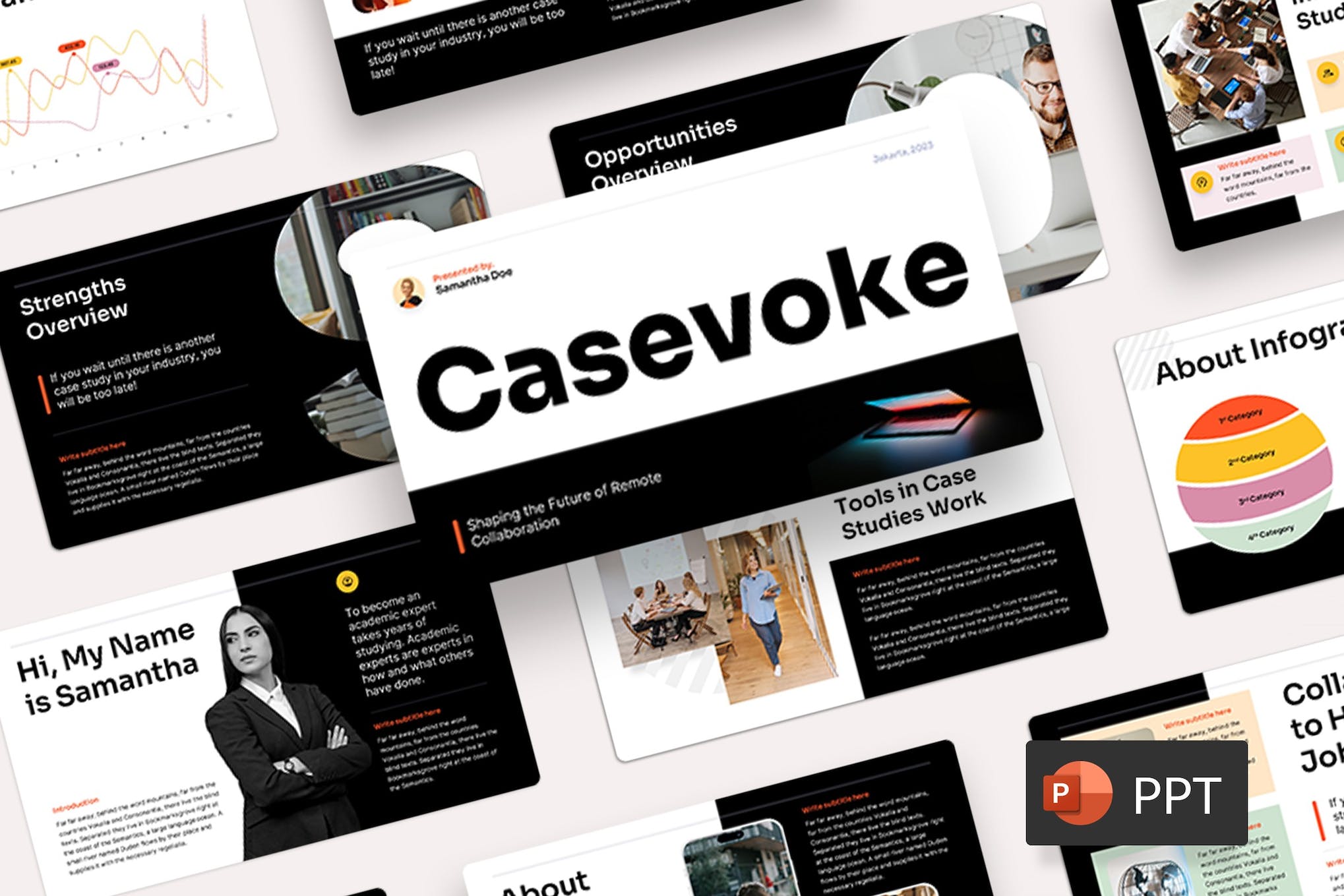
The Casevoke Case Study PowerPoint Template is a versatile presentation resource suitable for various purposes, including case studies, research, reports, and proposals. It offers 30 easily-editable master slides with 16:9 widescreen ratio, customizable graphics, a placeholder for pictures, and an included data chart. The usage of recommended free web fonts ensures an aesthetically appealing presentation. Please note, images in the demo are for preview purposes only.
Busca Business Case Study PowerPoint

The Busca Business Case Study PowerPoint is a universally adaptable presentation template, perfect for a spectrum of uses – from creative agencies and corporate business profiles to personal portfolios and start-ups. This asset, featuring 30 easily editable slides available in three color options, boasts a 16:9 wide screen ratio and a simple drag-and-drop mechanism. Please note, demo images are for preview only and not included in the file.
Bresky Case Study PowerPoint Template

The Bresky Case Study PowerPoint Template offers a sleek and unique design for a variety of presentation needs. With 25 slides that have been carefully created for aesthetic appeal and usability, it’s a versatile choice for any business, portfolio or branding project. Easy to use and customizable, it focuses on strong typography and incorporates unique mockup devices and portfolio slides, providing a professional and modern feel to any presentation.
Minimal Case Study PowerPoint Template
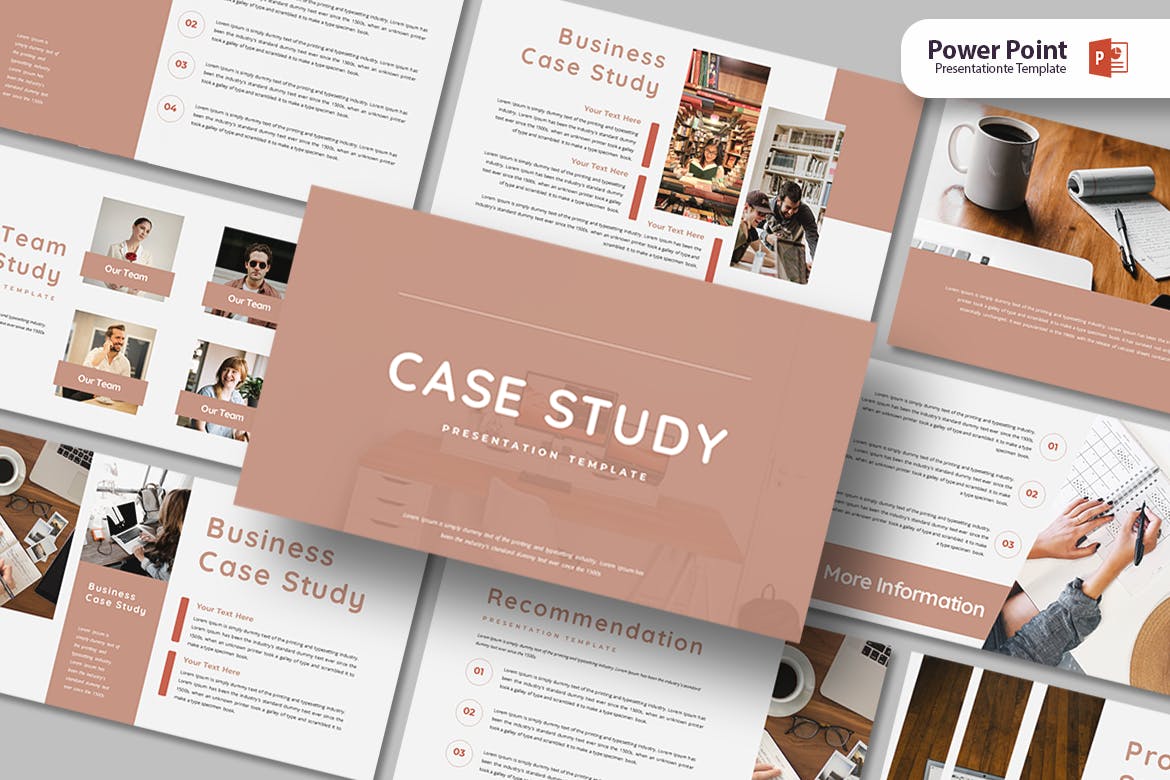
The Minimal Case Study PowerPoint Template is a versatile and user-friendly tool. Ideal for creative agencies, startups, corporations and more, it features 15 customizable slides and easy-to-edit elements. It has an intuitive drag-and-drop image feature, and the text, photos, shapes and colors are all easily adjustable. The template comes in a 16:9 ratio and uses free fonts. Note, images aren’t included.
Case Study and Education PowerPoint Template

The Case Study and Education PowerPoint Template offers a professional, ultra-modern design for educational and academic presentations. With 20 resizable and editable slides, this versatile template can be used for any topic, from school research projects to management seminars. With user-friendly features like drag-and-drop picture placeholders, free web fonts, and wide screen ratio, creating an engaging presentation becomes effortless.
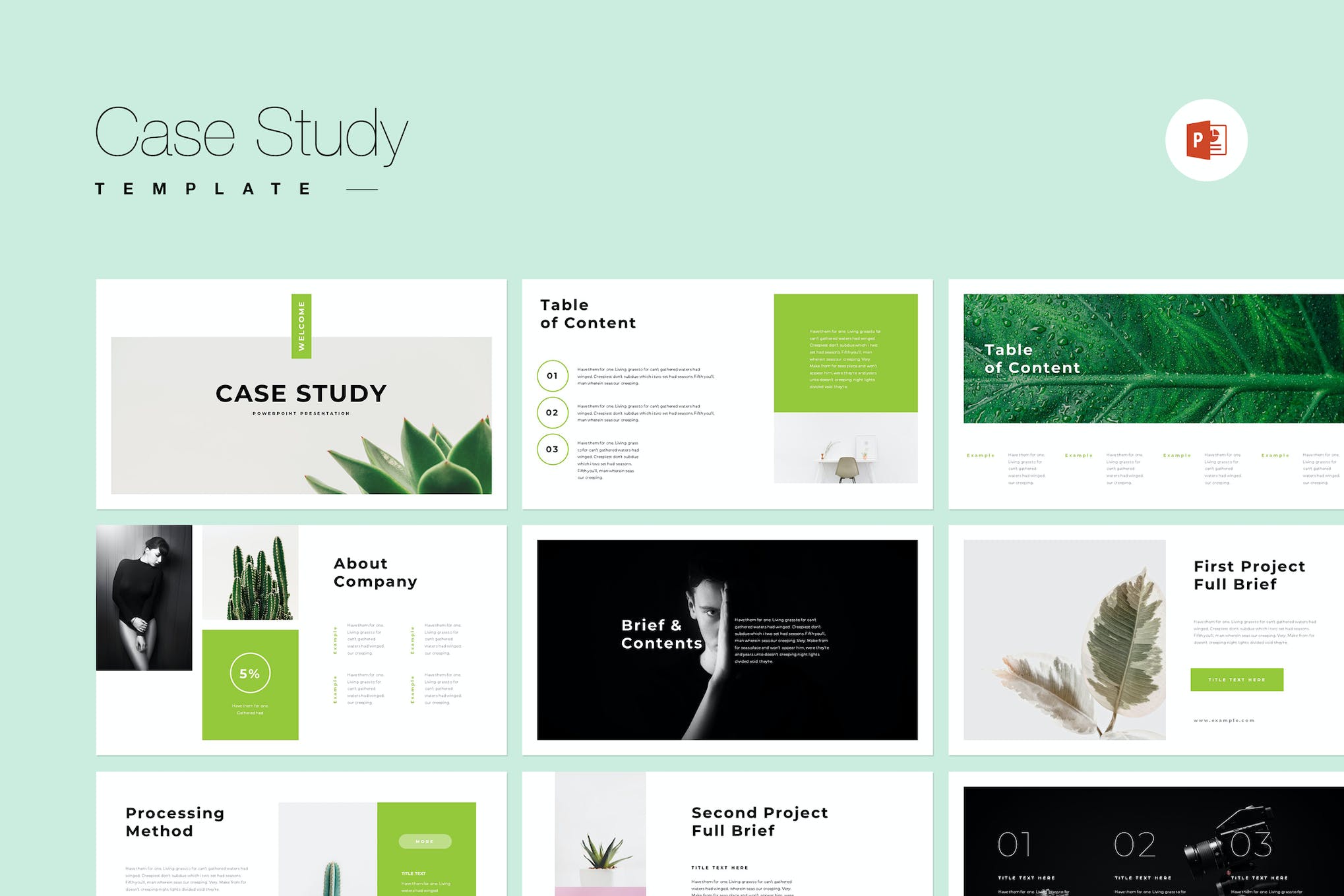
Case Study Powerpoint Template is a sleek and professional presentation asset well-suited for those aiming for a clean, creative, and unique style. It features over 20 unique slides, a customizable color palette to match your brand, and is fully editable with easy-to-use drag and drop functions. With its high quality, resizable vector elements and free fonts, it’s an accessible tool to elevate your presentations.
Case Study Business PowerPoint Template
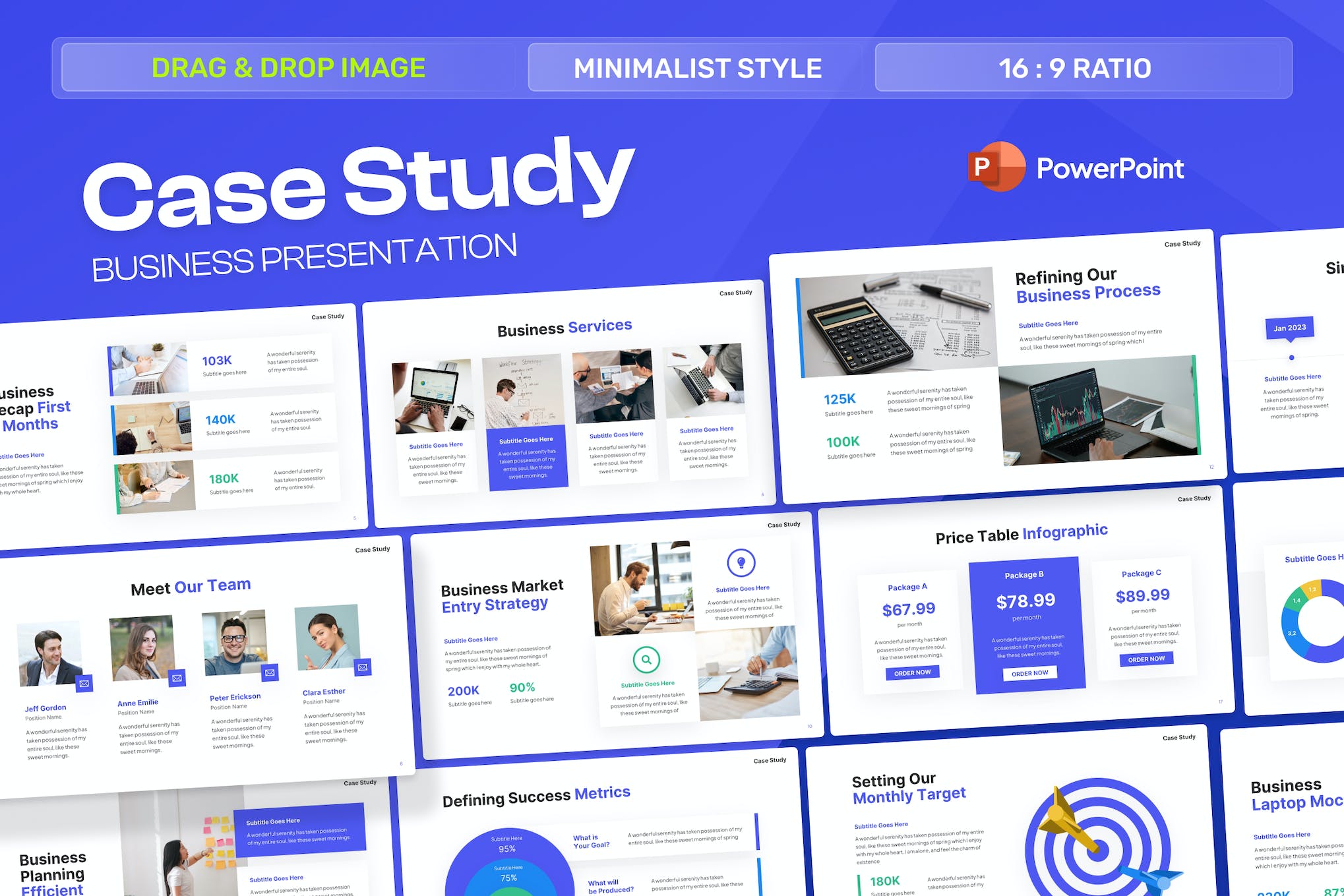
The Case Study Business PowerPoint Template is a sleek, minimalist style presentation tool ideal for various needs such as business proposals, lookbooks, and project pitches. With 30 unique slides, light and dark backgrounds, resizable graphics, and a drag & drop image feature, it offers versatility and ease of use. The package includes PowerPoint files, color schemes, a help file, and an icon pack, although images must be supplied separately.

The Case Study Presentation Template is a unique, clean, and professional PowerPoint tool perfect for creating captivating presentations. With over 20 unique, easy-to-edit slides, a full HD 16:9 ratio, and a master slide layout allowing easy photo replacement, this asset is a time-saver. The minimalistic and creative design makes for engaging presentations that align with your brand’s aesthetics.
Scilast Study Case Lab Template PowerPoint
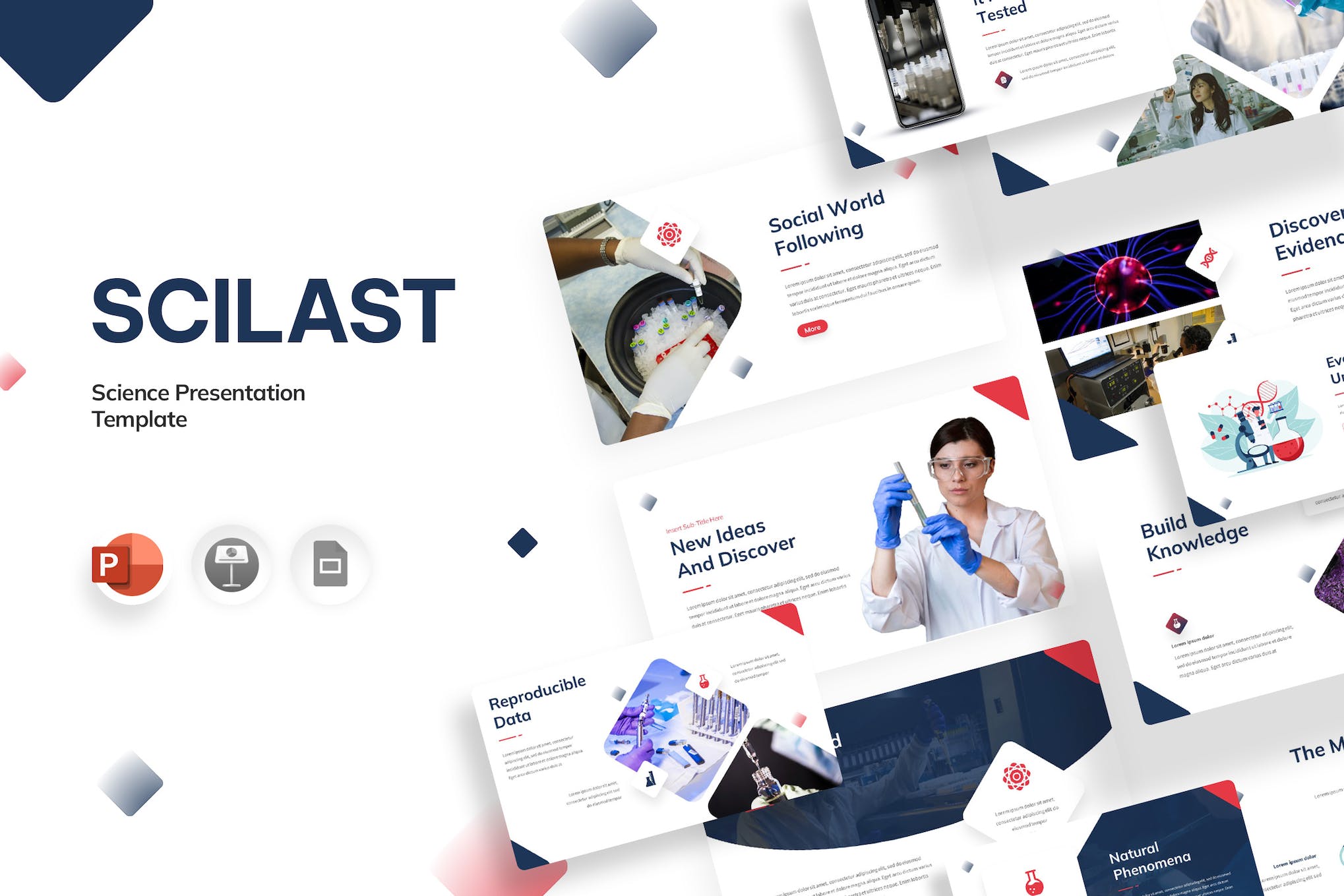
The Scilast Study Case Lab Template PowerPoint is a versatile and artistically designed presentation tool. Perfect for both corporate and individual presentations, it boasts of a total of 60 slides, with an equal mix of light and dark themes to suit your style. It’s easily customizable with a widescreen ratio of 16:9 and includes master slide layouts. Please note, images used in previews are not included.
Got any suggestions?
We want to hear from you! Send us a message and help improve Slidesgo
Top searches
Trending searches

solar eclipse
25 templates

16 templates

autism awareness
28 templates

12 templates

35 templates

7 templates
Clinical Case 05-2024
Clinical case 05-2024 presentation, premium google slides theme and powerpoint template.
Download the "Clinical Case 05-2024" presentation for PowerPoint or Google Slides. A clinical case is more than just a set of symptoms and a diagnosis. It is a unique story of a patient, their experiences, and their journey towards healing. Each case is an opportunity for healthcare professionals to exercise their expertise and empathy to help those in need. With this editable template for Google Slides or PowerPoint, you can describe a clinical case in detail, something that might be invaluable for medical students and fellow doctors.
Features of this template
- 100% editable and easy to modify
- Different slides to impress your audience
- Contains easy-to-edit graphics such as graphs, maps, tables, timelines and mockups
- Includes 500+ icons and Flaticon’s extension for customizing your slides
- Designed to be used in Google Slides and Microsoft PowerPoint
- Includes information about fonts, colors, and credits of the resources used
What are the benefits of having a Premium account?
What Premium plans do you have?
What can I do to have unlimited downloads?
Don’t want to attribute Slidesgo?
Gain access to over 22300 templates & presentations with premium from 1.67€/month.
Are you already Premium? Log in
Related posts on our blog

How to Add, Duplicate, Move, Delete or Hide Slides in Google Slides

How to Change Layouts in PowerPoint

How to Change the Slide Size in Google Slides
Related presentations.

Premium template
Unlock this template and gain unlimited access


IMAGES
VIDEO
COMMENTS
State the Problems Business Case PowerPoint Templates. Step 3. Evaluate Opportunities. Your solution needs to be directly related to the stated problem. Here you can list, side-by-side, the opportunities you foresee to address problems. This section is a segway from your problem to your solution.
Read more on Power and influence or related topics Business communication and Presentation skills Carolyn O'Hara is a writer and editor based in New York City. She's worked at The Week, PBS ...
When in doubt, avoid jargon and be brief—but always focus on communicating the value of the project. If this is your first time creating a business case, don't worry. Follow these five steps to create a solid one. 1. Gather input. You don't have to write a business case on your own.
A compelling business case and its high-quality presentation are the primary keys to the problem transformation and success. Most organizations fail to address both the critical success factor and business case presentation that can display benefits, reveal costs, and attract investments of key stakeholders, decision-makers, and funders.
A business case is a useful tool to provide a clear rationale for pursuing the project. A thorough business case can help key stakeholders decide whether to invest in the project by evaluating the feasibility, costs, risks and potential returns. A business case presentation gives stakeholders an opportunity to ask questions and address concerns.
Our business case template for Word is the perfect tool to start writing a business case. It has 9 key business case areas you can customize as needed. Download the template for free and follow the steps below to create a great business case for all your projects. ProjectManager's free business case template.
Use visuals and graphs from your powerpoint template to make complex data more accessible. Practice your delivery to ensure a smooth presentation. Address potential objections head-on and provide solutions. Make sure your business case is in line with the broader business requirements and goals. 4.
Title slide: Start with a title slide that includes the name of the case study, your name and any relevant institutional affiliations. Introduction: Follow with a slide that outlines the problem or situation your case study addresses. Include a hook to engage the audience.
A business case is a formal, structured document; an informal, short document; or a verbal exchange that defines the benefits of an initiative or project.. In addition, a business case forecasts the costs, benefits, and risks of an initiative, so decision makers — and even the project initiators — can decide whether a project is worthwhile and why to choose one approach over similar ...
Business cases often accompany or follow a project proposal and help show why your project is worth the company's or client's time, money, and resources. When writing a business case, always define the scope and include an executive summary, detailed info about finances, and an overview of the project's structure. Each member of the ...
To present the best commercial case, anticipate the resources you need and then factor in any contingencies that might occur within the delivery of the project. 4. The financial case. When thinking from a financial case perspective, show that the business can afford to fund the preferred option you are presenting.
That's an example of a business case overall. But let's get specific: developing a business case is easier when you have a template to look at. Let's build an example using a made-up company, ABC Widgets, and a hypothetical business case. Let's call our business case example "Operation Super Widgets":
1. Marketing Case Study. This generic case study template is a powerful marketing tool for businesses of any size. You can use it to elaborate on projects or solutions provided to satisfied clients—from the problem that led them to use your tool to your approach to the outcomes or results they've seen.
FAQs on Business Case Presentation . 1. What is a typical business case? A typical business case is a structured document that outlines the justification for a proposed business initiative or project. It is a comprehensive tool to assess the proposed undertaking's viability, benefits, costs, risks, and potential returns.
Clarity of vision: Your business case should describe what your proposed initiative solves or targets, how you will execute your idea, and its potential impact on the company. Brevity: Be brief in your presentation—both in person and on paper. Provide only the information your audience needs to make an informed decision.
4 best format types for a business case study presentation: Problem-solution case study. Before-and-after case study. Success story case study. Interview style case study. Each style has unique strengths, so pick one that aligns best with your story and audience. For a deeper dive into these formats, check out our detailed blog post on case ...
This is why you should establish the context and explain the background as the very first slide of your business case presentation. 2. Problem Statement. This is the slide where you have to make your audience realize that there is a problem and stress the significance and magnitude of the problem.
A business case presentation is a crucial step in convincing your stakeholders to support your project or initiative. It is not enough to have a solid analysis and a compelling argument; you also ...
Business case presentations are usually used in circumstances when funding is needed, a project's scope is changed, a new project is being started, or additional team members or resources are requested. Why is a business case presentation important? A business case presentation is developed to serve two main functions.
What Is a Business Case Display? Most business mistake seeing the business crate presentation as one nice smooth to have in store. Even, there's a whole shortage of heading, vision, and general without a solid business case PowerPoint that depicts numbers, main statements, and all necessary context. It also helps manage and assess the ...
Business cases need to focus on value added. Always keep in mind the end-goal of a business case. Get your presentation custom designed by us, starting at just $10 per slide. STEP 1. UPLOAD PRESENTATION. Share your presentation and design preferences via our easy-to-use order form. STEP 2. REVIEW AND REVISE.
However, in the business case presentation, you ability list the costs, forecasted ROI, resources needed, and potential benefits of opening up the satellite business. 10 Tips for Presenting Effective Business Cases. Use singular and attention-grabbing visuals. Chances are ampere lodge of directors or direktion team has seen a lot of business cases.
The Case Study Business PowerPoint Template is a sleek, minimalist style presentation tool ideal for various needs such as business proposals, lookbooks, and project pitches. With 30 unique slides, light and dark backgrounds, resizable graphics, and a drag & drop image feature, it offers versatility and ease of use.
Premium Google Slides theme and PowerPoint template. Download the "Clinical Case 05-2024" presentation for PowerPoint or Google Slides. A clinical case is more than just a set of symptoms and a diagnosis. It is a unique story of a patient, their experiences, and their journey towards healing. Each case is an opportunity for healthcare ...
The case was comprehensive, covering intricate aspects of the supply chain, operations management, logistics management and business strategy that demanded our utmost attention and skill. As we knew this was going to be long day, the priority was to make us settled, get comfortable and be in the right mindset for the approach.